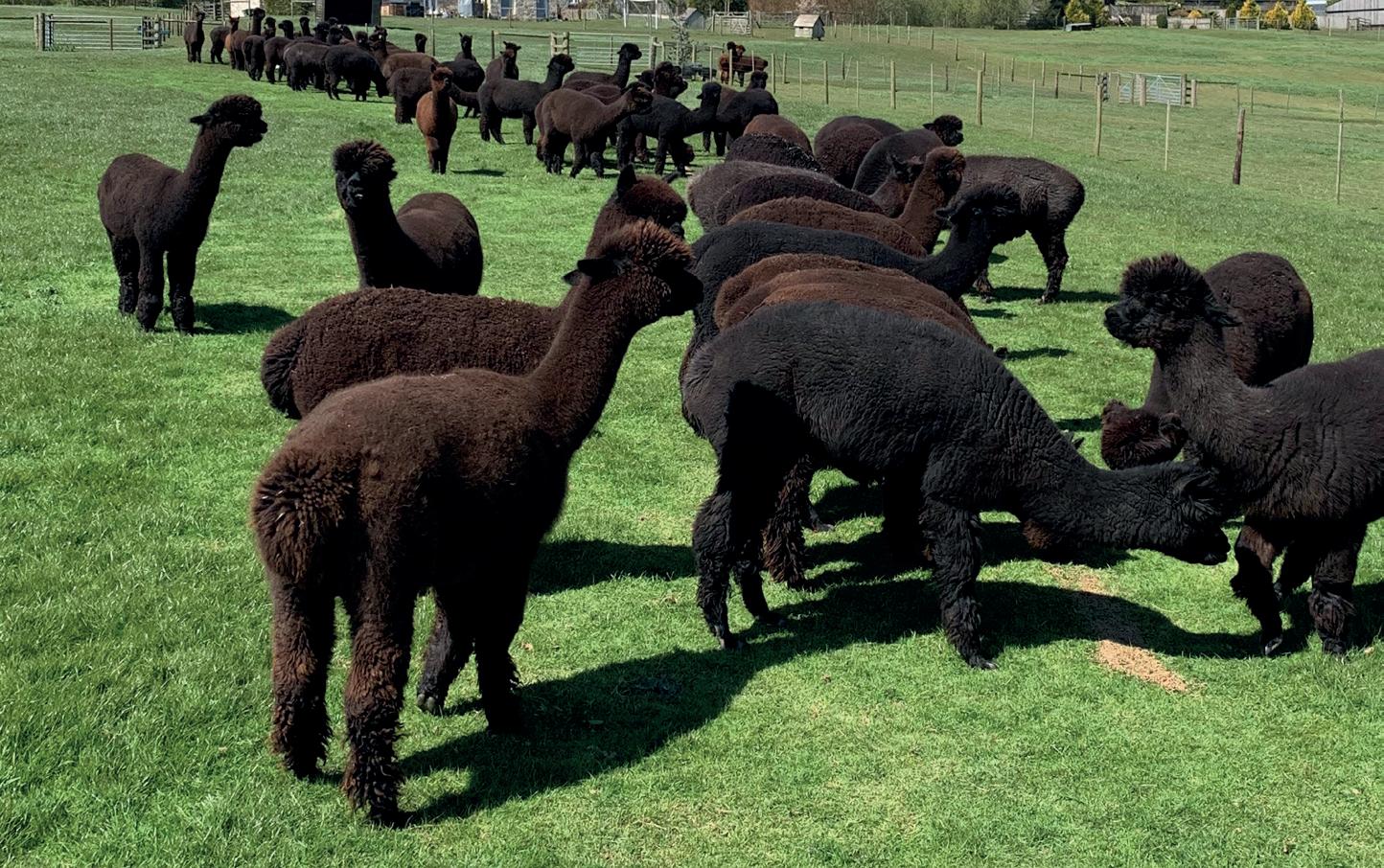






www.bas-uk.com
THE BRITISH ALPACA SOCIETY
c/o Grassroots Systems Ltd,
PO Box 251, Exeter EX2 8WX.
Tel (within UK): 0845 3312468
Tel (Overseas): +44(0)1392 437788
Fax: +44(0)1392 437788
Email: info@bas-uk.com
BAS CHIEF EXECUTIVE
Dr Duncan Pullar
Tel: 07496 578781
Email: ceo@bas-uk.com
EDITORIAL
Editor: Liz Wright alpaca.ed@kelsey.co.uk
ADVERTISEMENT SALES
Wendy King
Talk Media Sales Tel: 01732 448748
Email: wendy@talk-media.uk
GRAPHIC DESIGN
Jo Legg 07306 482166 jo.legg@flair-design.co.uk
KELSEY MEDIA
The Granary, Downs Court Yalding Hill, Yalding, Maidstone, Kent, ME18 6AL 01959 541444
MANAGEMENT
Divisional Managing Director: Steve Kendall
Group Publisher: Fiona Mercer
Retail Director: Steve Brown
Renewals and Projects Manager: Andy Cotton
Senior Subscription Marketing Manager: Claire Aspinall
Subscription Marketing Director: Kevin McCormick
Print Production Manager: Georgina Harris
Print Production Controller: Kelly Orriss
DISTRIBUTION
Distribution in Great Britain: Seymour Distribution Limited 2 East Poultry Avenue, London EC1A 9PT Tel: 020 7429 4000 www.seymour.co.uk
Distribution in Northern Ireland and the Republic of Ireland: Newspread Tel: +353 23 886 3850
Kelsey Media 2025 © all rights reserved. Kelsey Media is a trading name of Kelsey Publishing Ltd. Reproduction in whole or in part is forbidden except with permission in writing from the publishers. Note to contributors: articles submitted for consideration by the editor must be the original work of the author and not previously published. Where photographs are included, which are not the property of the contributor, permission to reproduce them must have been obtained from the owner of the copyright. The editor cannot guarantee a personal response to all letters and emails received. The views expressed in the magazine are not necessarily those of the Editor or the Publisher. Kelsey Publishing Ltd accepts no liability for products and services offered by third parties.
For more information of our privacy policy, please visit Kelsey Media takes your personal data very seriously. For more information of our privacy policy, please visit https://www.kelsey.co.uk/privacy-policy/ . If at any point you have any queries regarding Kelsey’s data policy you can email our Data Protection Officer at dpo@kelsey.co.uk.

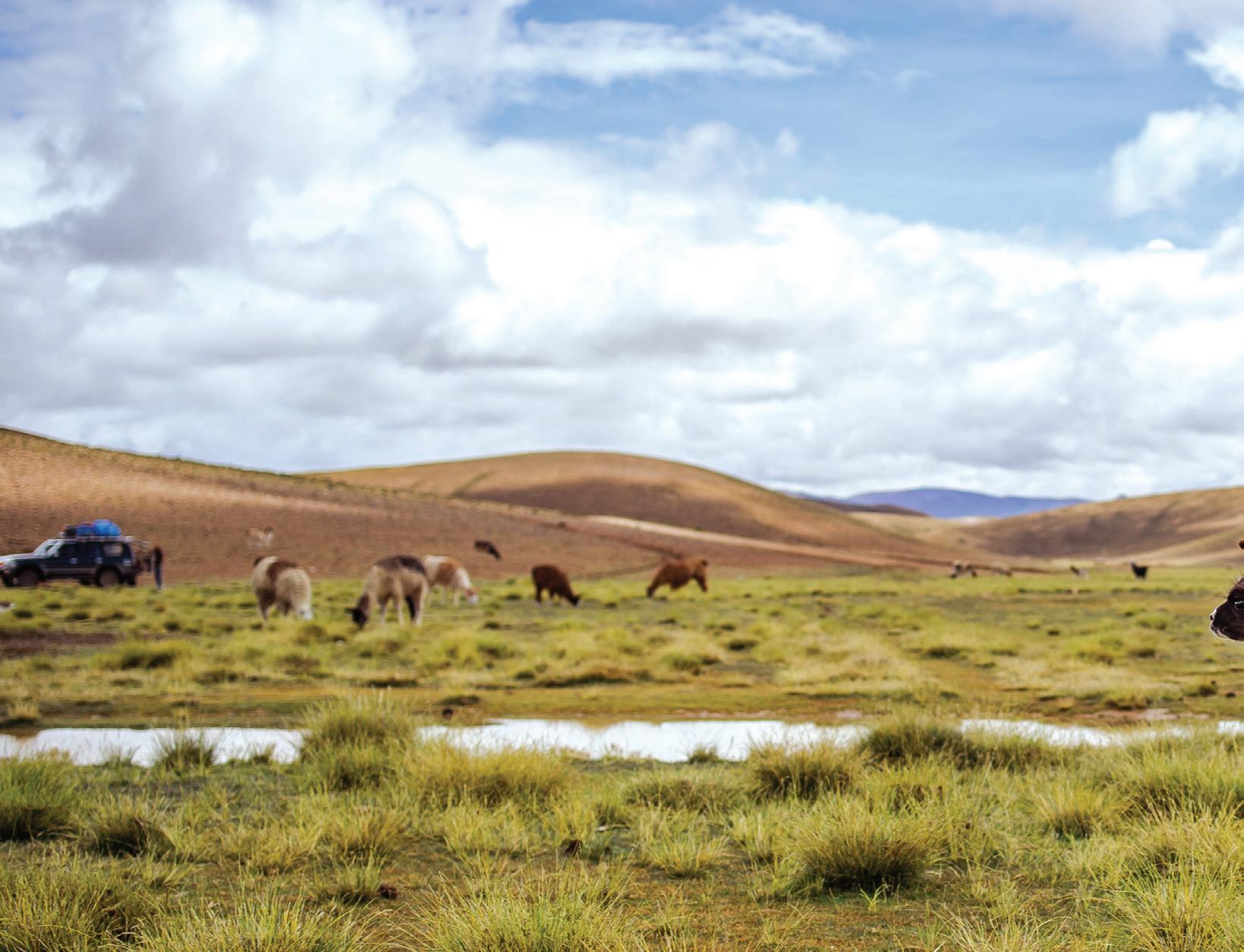
with highlights showing the
We continue to celebrate their beautiful fibre plus the versatility of other activities. We also have an exciting preview of the BAS Show where the very best fleeces and alpacas are on show. BAS are proud to see Judges who have come through the training programme being much sort after in other countries for engagements, while the fashion show in Peru attended by a breeder, is inspirational. Enjoy the world of alpacas! Email the editor Liz Wright: alpaca.ed@kelsey.co.uk
this be the final spring for colour testing? Or can we still affect the


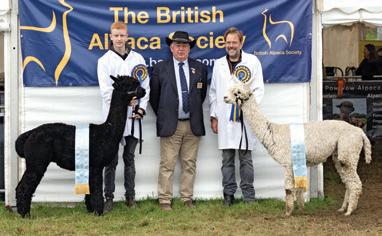



Alpaca Society gives access to a variety of courses for members from basic husbandry to advanced
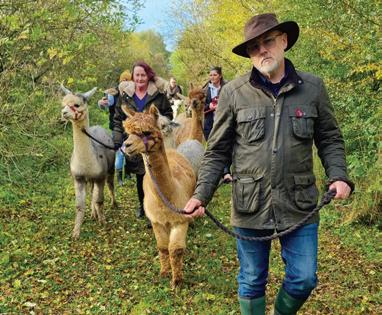
Alpaca Group was formed to cover a blind spot in the previous coverage of the
www.kelsey.co.uk
Cover

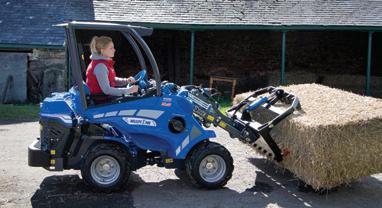
BAS membership and alpaca ownership continues to be healthy. At the end of 2023 BAS had 1,600 members 44,000 registered alpacas. There were 3,200 new registrations in 2024.
BAS Welfare has been continually active this year with advice to owners, Trading Standards and RSPCA. Alpacas have been re-homed successfully all over the country. A number of these animals were in a poor state and required veterinary intervention or shearing and sometimes transport. Thanks to all members who helped by alerting BAS to issues and, in many cases, investigating the situation. The Welfare Network has worked well this year – well done.
Exporting to the EU by land and sea is still difficult and we are continuing to try and work with the relevant agencies to expedite the process. There is some hope that sea transport across the channel may soon be a realistic route.
As individuals we can do our ‘bit’ to help the planet by way of modifying our thoughts and behaviours (e.g., recycling, replacing plastic with paper etc); so too can we, as individuals, set the foundations for the future in breeding best quality alpacas. As breeders we can utilise the tools in our toolbox to maximise the potential of those animals in our current herds and by making sometimes
tough choices with our animals e.g., removing from the breeding herd our poorer/poorest animals who may be perfect candidates for pet homes, for not using little Freddie for breeding just because he is cute. We can apply scientific numbers & data to our choices – we can colour DNA-test our alpacas, use EBV’s, use fibre test results and historical data to improve our own herds quality.
The fourth run of EBVs was calculated and published back to participants in January 2024. Thanks to all who submitted data. The size and quality of the data set is continuing to grow which makes it stronger. Most members who participated last year have submitted data again, along with some new recruits.
The National Show has moved! The 2025 show will be at Stafford Show Ground on 21, 22 and 23 March. The aim of moving is to make a more inclusive event and increase visitor numbers. The World of Alpacas is expanding to cover elements of alpaca training, shearing, fleece preparation, spinning, weaving and welfare.
BAS published a calendar for 2025 with a sequence of 12 beautiful photographs taken by members. All members were given a copy, distributed with the Autumn Alpaca Magazine issue. There was a prize for each featured photograph. Get your camera out and start planning for the 2026 calendar with high resolution landscape pictures!
Bluetongue virus continues to be an issue in the UK. At the time of writing movement of ruminants is under restriction with the eastern half of England in a BTV restricted
Zone. There is highly likely to be a period when movements restrictions are eased, in what is called the “vector low period.” This is when the cold weather reduces the risk of spread because midges are not active. Sales and shows have been affected in 2024 and probably will be in 2025. There have been some positive benefits from vaccination.
BAS is here to support its membership on their alpaca journey with help, advice education and welfare support alongside a thriving show scene and strong regional communities which allow like-minded alpaca owners to meet and support each other. The BAS Chat forum has continued to grow its membership and provides an active forum for members to exchange views on a wide variety of alpaca related issues. At the time of writing there were 719 members signed up to the Chat forum.
We have had a positive year with our regional alpaca groups. With 15 regional alpaca groups so there is definitely one near you!
The society is dependent on the member volunteers who do much of the work for the society at national and regional level. We are fortunate in having those members who do so much, from organising and running our alpaca shows, to everything else the society does, including education and training through to welfare and industry development. Thanks to everyone who puts in such an effort to make these events happen, and to everyone who attends.
Making contact is easy by phoning or emailing me, Duncan Pullar for all your alpaca enquires.
Venue: Lawrie Symington, Lanark, ML11 9A

Based in North Somerset 2 minutes from M5 J22 FOR SUPERIOR STUD SERVICES AND SALES OF MALE AND FEMALE ALPACAS Southern Sands Alpacas
FOR FRIENDLY AND HONEST ADVICE
PHONE: Ben 07791 396986
EMAIL: ben@southernsandsalpacas.co.uk
WEBSITE: www.southernsandsalpacas.co.uk
The British Alpaca Society (BAS) currently has 1,610 members representing 44,742 alpacas spread in various densities all the way from Lands End to John O’Groats.
As well as providing information and support to its members, one of the organisation’s most important functions is maintaining a pedigree registry for all alpacas in the UK national herd and a European directory for all BAS registered alpacas domiciled in Europe.
The alpaca industry is at an exciting stage of development and the BAS is working hard to support its members in their initiatives – both in the UK and Europe. By joining the Society you become part of a national community, dedicated to all things alpaca. Membership offers knowledge, networking and support to help you protect your investment and work towards your own alpaca aspiration.
The British Alpaca Society supports a national network of regional alpaca groups who meet on a regular basis to share experiences and knowledge, organise events and talk about the alpaca.
The autonomous groups provide an invaluable forum for sharing expertise through workshops, lectures, shows and related alpaca events, with the emphasis on self-help, accessibility and local initiative.
Whether you are an owner, a prospective owner or just interested in these fascinating animals, your regional group will always make you welcome.
The BAS website is a one stop educational resource containing detailed information on the alpaca, the membership and the Society. The BAS also has its own Facebook page which it uses to keep members updated on news and the latest information on events and shows.
The BAS provides its membership with an informative quarterly magazine dealing with all aspects of alpaca ownership. The editorial content is applicable to the aspirant, beginner and established breeder within the UK and Europe. The BAS also provides its members with regular electronic information updates.
The BAS, through its regional representatives on the national Education Committee, provides members with a range of educational courses on alpaca assessment, advanced alpaca assessment, alpaca fibre and processing for breeders.
Through its comprehensive BAS judge training scheme, it provides the UK industry with certified qualified judges to support the show circuits and through its training and recertification programme, it maintains the standard and consistency of alpaca judging in the UK.
Its National Fibre Committee provides members with information on shearing, skirting, sorting and processing alpaca fibre, keeping them up to date with all developments within the alpaca fibre marketplace.
The BAS is dedicated to the welfare of alpacas. It facilitates training and educational dvd’s and documents to aid husbandry and care of alpacas and is involved in all facets of government liaison regarding disease monitoring and exports. The BAS have emergency contacts for welfare issues and support members who have husbandry related questions or need help.


BAS Show Committees support a programme of BAS accredited halter and fleece shows throughout the length and breadth of the British Isles. Not only do these shows provide a showcase and learning experience for the general public, they also play a major part in educating and informing alpaca breeders throughout the UK.














Libby Henson from
A strong accurate pedigree database is an essential tool in the future development of our industry, and key to the development of a successful breeding strategy for all members. It provides the opportunity to look at trends within the national population, produce statistics for the BAS board, the marketing committee, Alpaca magazine, and potential new members. With easy access for all members the Online Registry holds a wealth of information on over 80,000 animal records including pedigrees, offspring, show results and images and helps members plan unrelated matings.
Please ensure that your alpacas are part of the future – check your herd records in the Online Registry, and get all your animals registered.
There are currently 44,472 alpacas registered as living in the UK in BAS herds ranging in size from two or three animals to several hundred. Most herds consist of 10 to 20 registered animals. It is important that all UK born alpacas are logged with the BAS even when they are kept as pets or for fibre production.
All alpacas should carry a microchip which is the primary form of identification and is the quickest way to positively identify a lost or stolen animal. Tag numbers should be allocated but do not have to be worn in the ear.
All cria should be logged with the BAS registry as soon as possible, and before their first birthday. There are three sections of the
If you need help or advice please contact the Grassroots Office on 01392 270421 or email pedigree@grassroots.co.uk
Or write to: BAS Registry, PO Box 251, Exeter, EX2 8WX
registry – Registered, Notified and Listed.
• All females should be ‘Registered’ (£20 +VAT).
• All pet males which will not be used for breeding or have been castrated should be ‘Listed’ (free of charge). This is important because it keeps them in the registry, and maintains their mother’s breeding record.
• All other males, whose destiny has not yet been decided should be ‘Notified’ (£5 +VAT)
• Certificates are available for Listed or Notified males for an additional £5 +VAT.
• Males selected as breeding studs must be fully registered. (£50 +VAT to include the compulsory DNA profile). The DNA profiles can then be used to parentage verify cria in the future.
Late fees apply to all cria applications which are not reported to the registry until after their first birthday.
Animals which have been sold should be transferred on the registry to the new owners.
Search for animals for sale by location, age, sex, colour and style

The transfer fee applies to ‘Registered’ females, ‘Registered’ and ‘Notified’ males and is normally paid by the vendor. Transfer of ‘Listed’ non-breeding males is free of charge.
The details of all ‘Registered’, ‘Notified’ and ‘Listed’ alpacas is available via the Grassroots Online Registry at breeds.grassroots.co.uk/bas
The landing page links to the animals you own (top left), your membership details and payment methods (bottom left). In the top right hand corner are the ‘action’ buttons:
• The magnifying glass – to search for people and the animals they own, any animals in the database, and animals which are available for sale or hire.
• Sort or filter the list offered, click on an animal to view its details; pedigree, offspring, show results and images if the owner has uploaded them from the Grassroots Mobile App.
• The menu icon – for a list of all the actions you can apply to make online: report births, register previously notified males, transfer ownership out of your herd, report deaths, apply for DNA profiles (this is automatically included in the application to register a male).
The online show entry system provides a full list of shows. You can go back in at any time to check which animals you entered, make changes up until the show is closed, and reprint fleece sheets. The entry system filters the classes to help you make the correct choice and reminds you of the shearing dates you logged for each animal at previous shows.
There are four ways you can apply to Notify, List or Register your cria with the BAS. You can:
1
2
3
4
Apply via the Grassroots Online Registry. You will need your herd letters and password. If you have forgotten them please click on the ‘forgot password’ or contact the Grassroots office for a reset.
Apply via the Grassroots Mobile App which you can download from the Google Playstore or Apple Appstore. Search for Grassroots Systems.
Email a list of cria in an excel spread sheet.
Send a paper application form or email to the Grassroots office with all the details.
Please note in 2024 the board decided that all applications MUST be paid for before they can be processed. If you have not already done so please ask for and sign a Direct Debit mandate which will avoid any possible delays.
Fees have been waived for the first 20 female cria ‘Registered’ or male cria ‘Notified’ in each herd between January 2024 and the end of 2025.
Use Check Mate in the menu list to look for common ancestors in potential matings.
Please do check that the animals are on the BAS database or contact the Grassroots office for assistance on 01392 270421 or email pedigree@grassroots.co.uk. It is very important that animals are registered before you buy because cria can only be registered by the person who was the registered owner of their mother on the day they were born. If you purchase unregistered animals you
Use Check Mate to identify common ancestors in potential matings
will not be able to register them yourself, and any cria they subsequently produce will only be eligible for Listing. Remember if you are planning to show, or to breed animals you may wish to sell in the future, you must begin with pedigree registered stock. Registration is also important because the pedigree of an animal, its offspring, siblings and other relations are a good indicator of breeding potential and that of any descendants. If you want to breed to improve your stock, you need to know as much as possible about what you are buying.
If you do already own unregistered stock, please contact the BAS registry for advice. It may be possible to trace their registered parents and arrange for late registration and transfer. Failing that, there is a ‘grading-up scheme’ which enables unregistered stock to be brought back into the fold, over three generations.

The BAS National Show is one of the largest and most prestigious alpaca shows in the world, with approaching 600 alpacas in the Halter Show, the winners of regional shows competing in the Champion of Champions Fleece Show and the Fibre Zone showcasing alpaca products.
• Brand new venue bringing all exhibitors together in one hall
• Live streaming of the Halter Show judging from two rings via YouTube
• Results of the Champion of Champions Fleece show with all the fleeces on display
• Halter Show judges will be Molly Gardner (NZ) and Peter Kennedy-Gane (AUS) and Fleece Show judge will be Roger Clarke (UK)
• Fibre Zone competition offering classes for yarn, garments, homeware, toys and crafts
Further information
TV www.bas-uk.com/bas-national-show
• World of Alpacas featuring alpaca handling demonstrations and exhibits designed to inspire, advise and educate on all things alpaca
• Trade and sponsor stalls with a host of alpaca related products and services for sale
• Loads of socialising opportunities with pub, café and dining all on site
• Array of sponsorship opportunities
• Stud Auction in February with all proceeds supporting the show and a chance to secure some of the most exclusive stud opportunities
We’ve moved venue to Staffordshire County Showground which is a major events and exhibition venue located near Stafford, England. Bingley Hall, the centrepiece, is a large, versatile exhibition space often used for trade shows, fairs, and corporate events. Opened in the 1970s, it has become known for hosting a diverse range of gatherings, including agricultural shows, antique fairs, automotive


events, and even concerts. With its ample parking, on-site facilities, and nearby transportation links, the venue is well-suited for large crowds. Surrounded by the scenic Staffordshire countryside, the showground provides a unique blend of urban accessibility and rural charm, making it a popular spot for both organisers and visitors.
The showground gives us all the facilities we need to run one of the world’s most prestigious alpaca shows
• All exhibitors for the Halter Show brought together in one hall
• A mezzanine wrapped around the hall providing excellent viewing plus further exhibition space for the Fleece and Fibre Shows, room for trade stands and a cafeteria
• Further space in the adjoining annex for our third ring featuring alpaca training and agility
• The Bingley Arms pub and banqueting hall all on site – sorting out the social scene!
• Plenty of (free) parking and exhibitors have the option to bring their caravan, motorhome or camping gear and stay on site.
Most obviously, the National Show is a chance for breeders to showcase their alpacas and compete for the prestige of being a colour champion and ultimately Supreme Huacaya or Suri in both the Halter Show and the Champion of Champions Fleece Show.
But the show is more than that.
The spectacle of over 500 alpacas representing some of the finest in the country is an exhibition of the quality of the UK alpaca industry.
For UK breeders, it’s a chance to catch up and compare breeding programmes and an important opportunity to learn from and trade with one another. It’s also a great chance to showcase to visitors from Europe who may wish to import to meet their breeding goals.
With the Fibre Zone competition and numerous trade stands retailing alpaca products, it’s a chance to sample and enjoy the luxury and utility of alpaca fleece. And with spinners and weavers doing live demonstrations and a specialist shearer and local alpaca mill on hand to answer questions about how to get your fleece made into yarn, it’s a not to be missed opportunity to inspire and inform alpaca owners who want to use their fleece.
This year, there’s even more for alpaca owners with herds of all sizes as we include demonstrations on handling and training and, as always,

we have special events for young handlers with the aim of inspiring the up and coming next generation of owners.
There will also be a crafting zone, particularly aimed at young people – although those who are older but still young at heart may also join in!
With all this going on at the show, we open our doors not only to existing alpaca owners but to all in the local area who may want to come and have a great day out, to meet and learn more about these wonderful animals. There will even be a few llamas in order to address the age old question ‘what’s the difference between alpacas and llamas?’
Overall, the gathering is a window on the health and vitality of alpaca ownership in the UK. Our aim is to inspire and encourage alpaca owners old and new and create the opportunity for all to enjoy a fun weekend!
A customary feature of the annual show is the opportunity to buy stud services from a fabulous selection of males from across the country. Sold by auction over four weeks in February, the sale is the perfect opportunity to secure a special stud for one of your females, including some who are not available for any other outside matings. The breeders kindly offer stud services without charging a fee, so all proceeds go towards the National Show fundraising. Every year this is an event in itself with all the excitement of seeing who is going to outbid who, particularly when the Irish contingent get going!
The stud males available are being advertised on the National Show website now along with all the details on dates and the process. If you spot just the one for you, we wish you good luck!
Many thanks to all who donate stud services and everyone who bids.
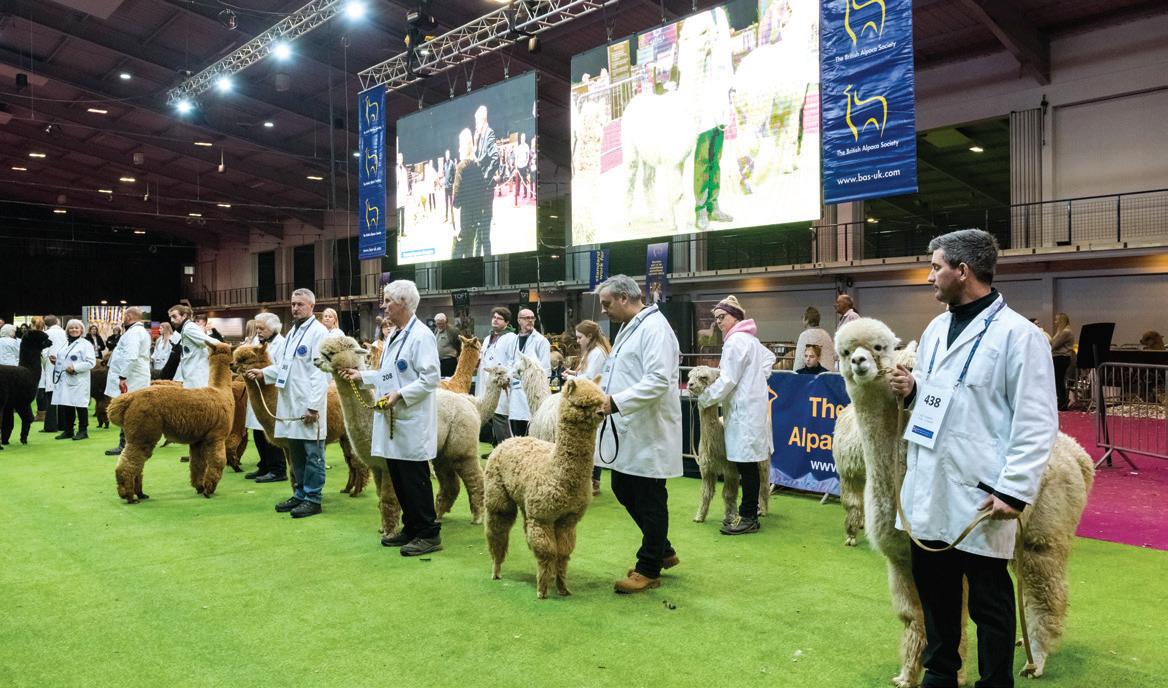
All you need to know in the trade and sponsors’ area of the BAS National Show.




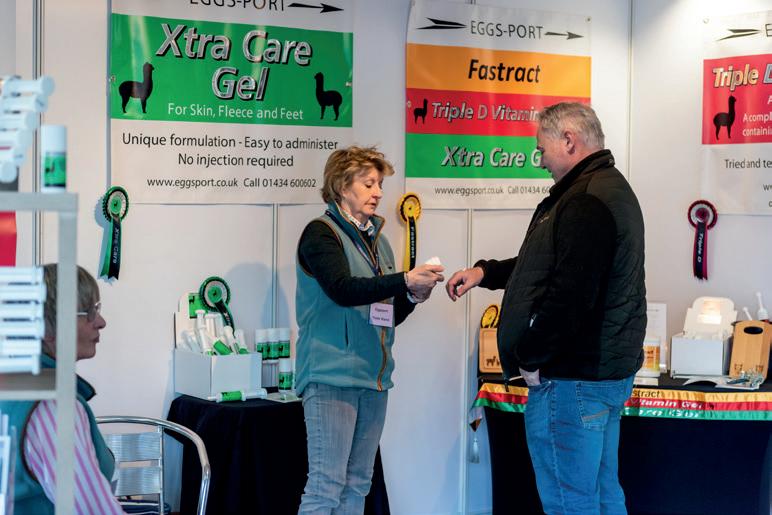
As well as the fascination of seeing so many top quality alpacas all together at the same time, the trade and sponsors area is a vital part of the show where you can find out about new and established products and services for your alpacas.
Among the exhibitors are those who have moved the knowledge of alpacas and their fibre forward such as Claire Whitehead, UK Alpaca Vet who has a wealth of resources to keep your herd happy and healthy.
Another tool for evaluating fibre is Skin Imprint. Skin Imprint® was created by award-winning alpaca breeder and farm owner Caroline Barugh. Having spent 10 years in the industry, Caroline wanted to explore a more humane way to determine the quality of the fleece. An advocate and practitioner of high-welfare farming and breeding, she wanted to find a replacement for skin biopsy which could assess density, count the primary/secondary ratio and analyse the micron of primaries compared to secondaries. Its humane and effective – to find out more visit their stand.
Balanced feed, tailored to the needs of alpacas is, of course, an important part of alpaca care and JG Animal Health and GWF are both happy to talk nutrition all day long! It’s a big and very important subject so bring your questions and observations to them and find out what makes a well fed alpaca.
To evaluate your alpacas, body scoring is all important and part of helping with that task is good handling facilities. Marshwood Alpacas have kept and bred alpacas since 1998. Breeding and selling over the years, they found it increasingly difficult for one person to manage the husbandry jobs of injections and foot trimming on their own. They searched the internet for alpaca handling equipment and found nothing

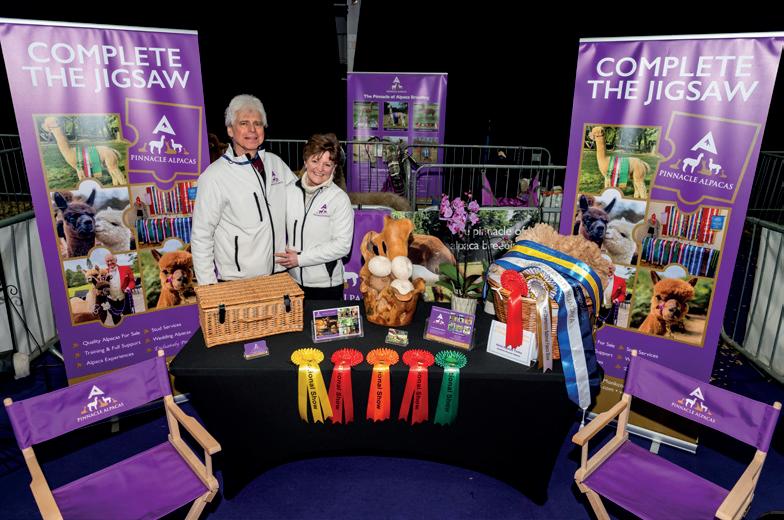
available in the UK. Geoff being an agricultural engineer, was fully experienced in welding and metalwork, decided to build his own handling system. The Alpaca Easy Pen was designed and built with first-hand experience of handling and working with Alpacas. It allows one person to carry out all usual husbandry tasks on their own, if necessary.
Simply Alpacas will give you the tools to understand and work better with your alpacas, so important for an unstressed herd and Mary Roach harness will be able to advise on halters and other alpaca designed equipment.
For larger equipment check out Compact Loaders UK – a specialist distributor of plant and machinery for the lifting and shifting of materials. Their range includes mini loaders, skidsteers, dumpers, and vacuum lifters. The many uses on an alpaca farm are obvious, to make life that bit easier. Their aim is to help you utilise equipment that will increase your productivity and profit, by reducing labour and costs.
Eggs-Port specialises in the export of semen but also offers a vitamin gel for alpacas. Shipping genetics overseas can appear very attractive and readily available, however due to extensive veterinary regulations which vary country to country, shipping genetic material is particularly complicated. Eggs-Port believe their experience and specially negotiated rates for shipping and insurance are incredibly beneficial.
They need no introduction but West Wight Alpacas who have become an attractive tourist destination on the Isle of Wight, will be there too where you can see the varied ways they promote alpacas, including their quality Suri breeding stock.
All in all, the trade and sponsors area is a great place to get ideas, solve your alpaca problems and help plan you and your alpaca’s future.

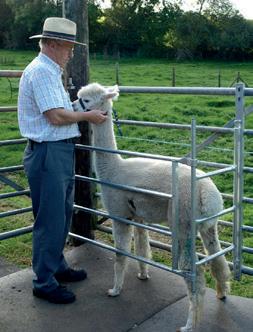
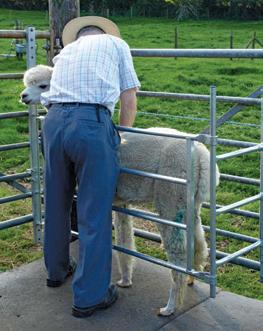




























By Drew Thomas of Arkadia Alpacas.
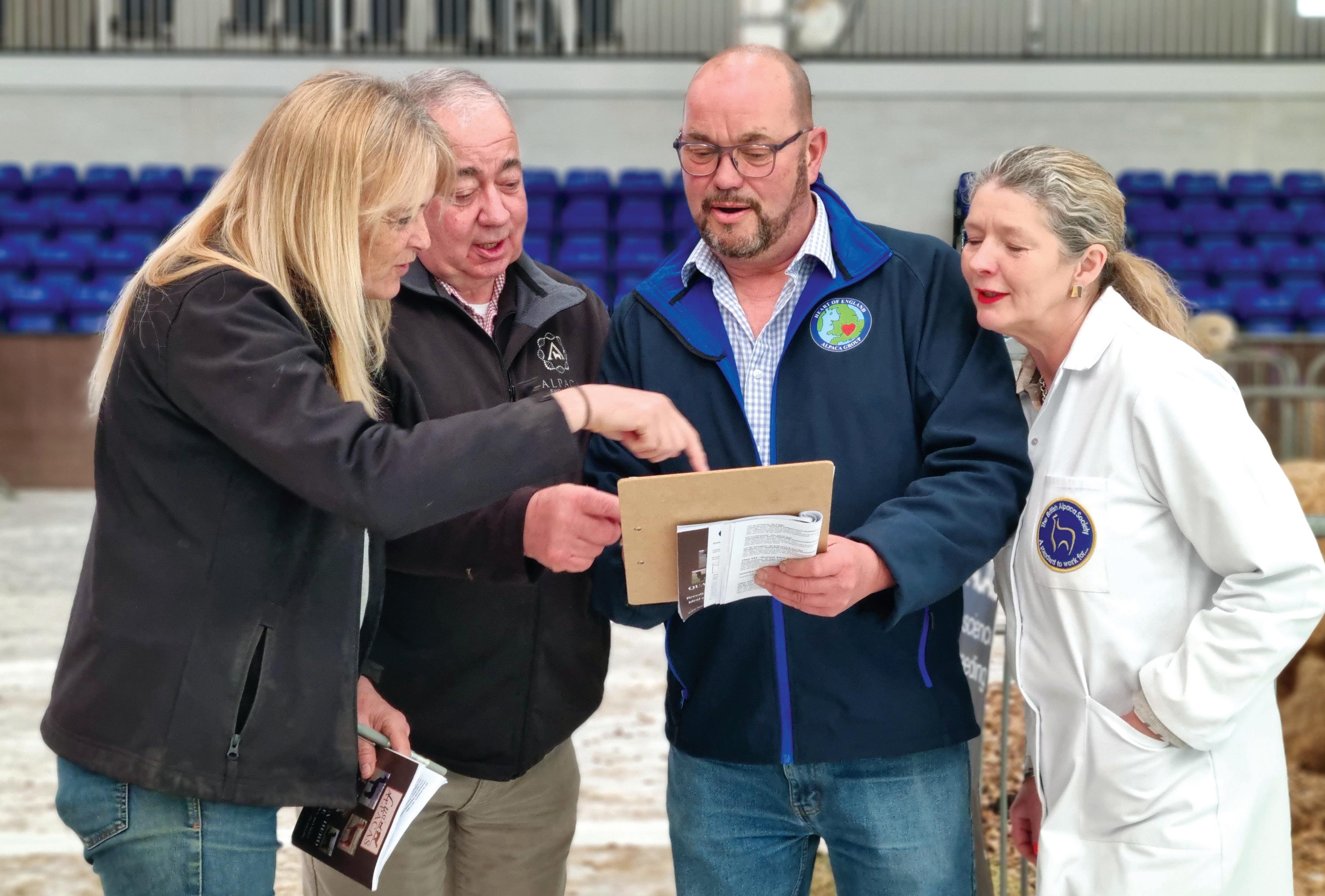
Ifrequently question whether I would still have gone ahead with the purchase ten years ago if I’d known that the group of five female alpacas I was planning to buy would become a herd of more than fifty, that Walking with Alpacas would become virtually a full time occupation rather than a sideline and all life’s decisions would be affected by these enigmatic creatures from the High Antiplano. The fact is that I did and thus began the long and meandering journey of navigating my path and carving my niche in the world of alpaca breeding. And what a journey full of learning it has been!
Reading and learning as much about alpacas prior to that first purchase (including a husbandry course with the inspiring duo Rob and Shirley Bettinson at Toft Alpacas) left me quite proud of myself for having learned so much in a short time, but looking back it was very much a small drop in
the vast ocean of camelid information.
It was followed by a lot more learning – much of it on the job – about nutrition, housing and grass management, including studying the best types of grass to plant on former arable land along with legumes and herbs to improve gut health and make the best hay to feed the herd through the winter. Learning how to train alpacas to be happy and content while accompanying members of the public on walks, while at the same time jumping through the hoops required to run a rural business requiring licences, insurance policies, risk assessment and health and safety policies, alongside the daily delights of dealing with the public, particularly those that arrive for a ‘Walking with Alpacas’ experience and announce that they didn’t know walking would be involved (thankfully a rare occurrence).
Learning to spin fibre into yarn was another skill learned in something of a hurry in order to be able to teach at craft workshops and is still something I love to do when I have time.
>> Continued on next page



After my first year of alpaca ownership, when I was just about beginning to refer to myself as a ‘breeder’, I had a bash at the collective linear measurement of the fencing I’d built. I was impressed and horrified to learn that it was over a kilometre, I can only imagine what I would have thought if I’d known that figure was going to be multiplied by at least ten and that fencing would still be ongoing. There seems to be no end to the need for additional catch pens, races, double fences, electrified perimeters or adjustments to gateways and field shelters always seem to need attention, replacement after they’ve blown away in a storm or alteration to suit the needs of the very particular herd.
At the very top of the list of learned skills has to be the agonising excitement of watching births take place – births that are the result of long-planned matings which may or may not bring the desired quality in the cria. Every birth brings hope and anticipation. Will this enchanting little bundle grow up to be in the show team?
Which brings me on to the matter of my first trepidatious steps into the show ring at the Heart of England Spring Fiesta in 2017. My show team had, of course, been picked for entirely the wrong reasons and those first results were less than encouraging, but I was on the way and there was no turning back. Following on from those early shows, I learned how to be more astute when it came to purchases and matings - looking at the genetic ingredients of quality alpacas rather than hankering after the impossible dream of being able to buy champion quality animals – but, more importantly, I realised the huge value of assisting at shows.
I can’t count how many fleece shows I’ve assisted with and there is no doubt in my mind that it is something every serious breeder should do. To
Drew Thomas

see fleece after fleece judged before your eyes has to be the best learning experience and put me in a good position when tasked with judging fleeces on training courses.
Halter shows, too, provide excellent learning experience for those willing to commit to stewarding. After all, without stewards the shows can’t function, but there is much to gain from being in on the organisation, seeing the bigger picture and, quite simply, having a hands-on insight into the alpacas entered. Once you’ve been a steward, you appreciate what they do, from checking in all entries efficiently making sure each alpaca is in the right class for its colour, through to making sure every alpaca gets to the ring on time for its class to the often-undervalued ring steward getting the alpacas lined up in the ring for the judge to do their job.
Meanwhile, my newly-informed breeding choices were reaping dividends. My first Champion, Arkadia Rapscallion, born three years into my alpaca journey and now working at Solomons Alpacas, paved the way for a string of successes, most notable being Arkadia Unakite (National Champion Brown Female 2022) and Arkadia Umberto Pinkerton (Champion Grey Male - Royal Three Counties and South of England 2022, East of England 2023, Heart of England Fleece 2024, Reserve Champion Grey Male - Somerset County 2023, South of England 2024, Judges Choice East of England 2023). Umberto’s offspring are eagerly awaited in 2025.
All this involvement with the process of showing helped to cement the more formal learning achieved by attending BAS training courses.
First came ‘Introduction to Alpaca Evaluation’ with Nick Harrington-Smith held at Alpaca Evolution. This was a really solid basis for the rest of the training that was to come in the form of ‘Intermediate Alpaca Assessment’ – a three day course held at Toft Alpacas, which to my mind has to be the very best venue for alpaca training courses, not least because of excellent hosts Rob and Shirley Bettinson. The tutors on the course were Tim Hey and Barbara Hetherington, who introduced delegates to the hands-on process of assessing alpacas. In short, the course was thoroughly enjoyable and I’d recommend any alpaca owner to take part, whether or not they are contemplating going further on the road to judge training. The next stage was ‘Advanced Alpaca Assessment’ at C S Alpacas, tutored by Tim Hey and Mary-Jo Smith, a course designed to build on knowledge attained at the other courses, working particularly with the assessment of alpacas grouped into classes.
This is also a good place to mention that volunteering to handle at these courses is also an excellent way to learn. I’ve handled on several courses, judge certifications and judge clinics. In all cases, knowledge and insight into assessment and judging was gained. Judging is not, after all, a mystical art but rather a human process of assessment and evaluation, in which there is rarely a definite right and wrong answer. Judges, by their own admission, don’t necessarily make the best teachers, but do their best to impart the knowledge they have gained over the years to those of us eager to learn.
I try to take advantage of any opportunity to look at alpacas herds, but the most valuable experience was a weekend spent with the other successful delegates from the ‘Advanced Alpaca Assessment’ visiting four herds who kindly agreed to accommodate us, namely Chinchero Alpacas, Parkside Alpacas, Pemberley Alpacas & Churchfield Alpacas. This led to the single biggest leap in my grasp of the complex knowledge of alpacas that would give me the impetus to carry on to the next stage on the meandering road of learning – ‘Judge Training 1’ at Beck Brow Alpacas.
The learning will continue for the foreseeable future…

IT’S IN OUR DNA
One export that can still go ahead successfully is BAS judges who are invited to highly prestigious alpaca shows and events around the world. This is indeed demonstrated by judges Tim Hey and Nick Harrington-Smith at the World Alpaca Conference 2025 that runs from the 4-9 March 2025 at the Arena Hohenlohe, Ilshofen, (Baden-Württemberg) Germany.
Hosts Robin Näsemann, Heinz Kuhne-Pfaff, Simon Klink and the entire support team are excited to welcome you as a guest and have a jam packed programme where you can find everything that interests you. To date there are 600 plus alpacas entered and 500 plus fleeces. Nick will be casting his expert eye over the high quality fleeces together with Arturo Pena from Peru. Nick is the only Brit who is a qualified judge and judge training in America with the AOA and is relishing the challenge. Nick said: “It is always a privilege to judge any show no matter how big, but to be asked to judge fleeces at the WAC feels more than a little special. The opportunity to judge fleeces from many countries across Europe is a special opportunity for me as both a judge and a breeder, I cannot wait to see what is in the competition.”
Tim is taking on the challenge of the Halter Class where the very best alpacas in the world will be on show and what a sight that will be to see. Amanda Vanden-Bosch from the USA will be his fellow judge. Tim said: “I feel it is a privilege to judge alongside Amanda at this prestigious show where we will be seeing alpacas from multiple European countries at one location. This is a unique chance that won’t come around for a few more years!” He continued: “I take judging very seriously and look upon it as

Look out for our focus on judges throughout 2025 who will share their experiences at home and abroad

Tim Hey judging a previous BAS National Show
an opportunity to give back to the alpaca industry by ensuring that the alpacas that achieve show success will impact on the future improvements of the breed”.
The World Alpaca Conference is both an opportunity to view the very best European alpacas at the Halter Show and also view the finest fleeces. But also it’s an opportunity to attend a world beating conference where topics range across every aspect of the alpaca. Among the highlights are the Alpaca Fashion Gala presented by Lucrecia Lovera from Argentina and the stud fee auction. Seminars and visits on fibre production, evaluation and production and veterinary aspects are given by exceptionally experienced people and there is also a program of visits. The programme can be found on https://wac2025.com/en/program/
Mary-Jo Smith was the well respected Chair of the Judges last year. It has been decided that this year there should be two Chairs that will share the work so Tim Hey is taking on the mantle with Mary-Jo.
British judges are much in demand across the world and are frequently to be found in other countries sharing their skills in evaluating top show classes. They are very much sought after for their knowledge and professionalism. This is much to do with the BAS system of training (which you can find on page 39) which allows everyone, who wants, to take their fascination and respect for alpacas to the next level until finally they reach the pinnacle after many years of learning and training. As Tim said, it gives people the chance to give back to the industry as well and to encourage others to come forward for the future. It’s something BAS is very proud of and is protective of the high standards that they uphold.












Dorset County Show is a highlight of the calendar says Clare Jenkins who was part of the organising committee for the first time.

2024 was a year of many firsts for me. The Dorset County Show is a long running highlight in the Dorset calendar, but this year saw the first alpaca show as part of the “Alpaca Village”, and what an inaugural show it was!
I had the pleasure of being on the organising committee for the first time, which for me involved assisting with taking samples for the fleece show, helping set up the display of Champion and Supreme Champion fleeces and recording for the halter show judging.
It was eye opening to see just some of the large amount of hard work that goes on behind the scenes. Of course, my input was just a small subset of the tasks needed to set up and run such a fantastic show and the rest of the organising committee and stewards did an amazing job.
As a “newbie” I didn’t know what to expect, to date my experience of shows are purely equine but I was overwhelmed with both the professionalism of the show and also how that combined with such a lovely friendly and welcoming atmosphere. It’s much easier to achieve just one of these things; to accomplish both is hard but also a fantastic achievement and very rewarding.
The Dorset County Show is the first weekend in September, so it’s always important to be prepared, sun cream and wellies are normally a good combination! As usual, the great British weather didn’t let us
Left to right: Huacaya Supreme Champion
Inca Replay with Oliver Hey of Inca Alpaca, judge
Nick Harrington Smith, Suri Supreme Champion
Dark Sky Ziggy with owner Tom Scott of Dark Sky Alpacas
down and we were blessed with some beautiful blue skies but also hampered with some torrential rain and a large amount of mud, particularly at the entrance gates. Nevertheless, some careful planning and the hilltop location meant that the alpacas stayed dry and the grass arena held up very well.
The tents provided by the show also allowed us to have a Plan B and do the judging inside should it be needed. Thankfully we managed to find some lovely gaps in the weather and all the judging was superbly done outside by our halter judge Nick Harrington-Smith, supported by his very able assistant in the ring, Isla May. Not only was Nick able to provide some technical feedback to the exhibitors, he kept the audience enthralled explaining his choices and the reasons behind his decisions. Later on and after some basic instructions on what to look for, the audience was also able to provide a show of hands to identify the three alpacas that most looked like each other, adding a fun element to the progeny class.
>> Continued on next page


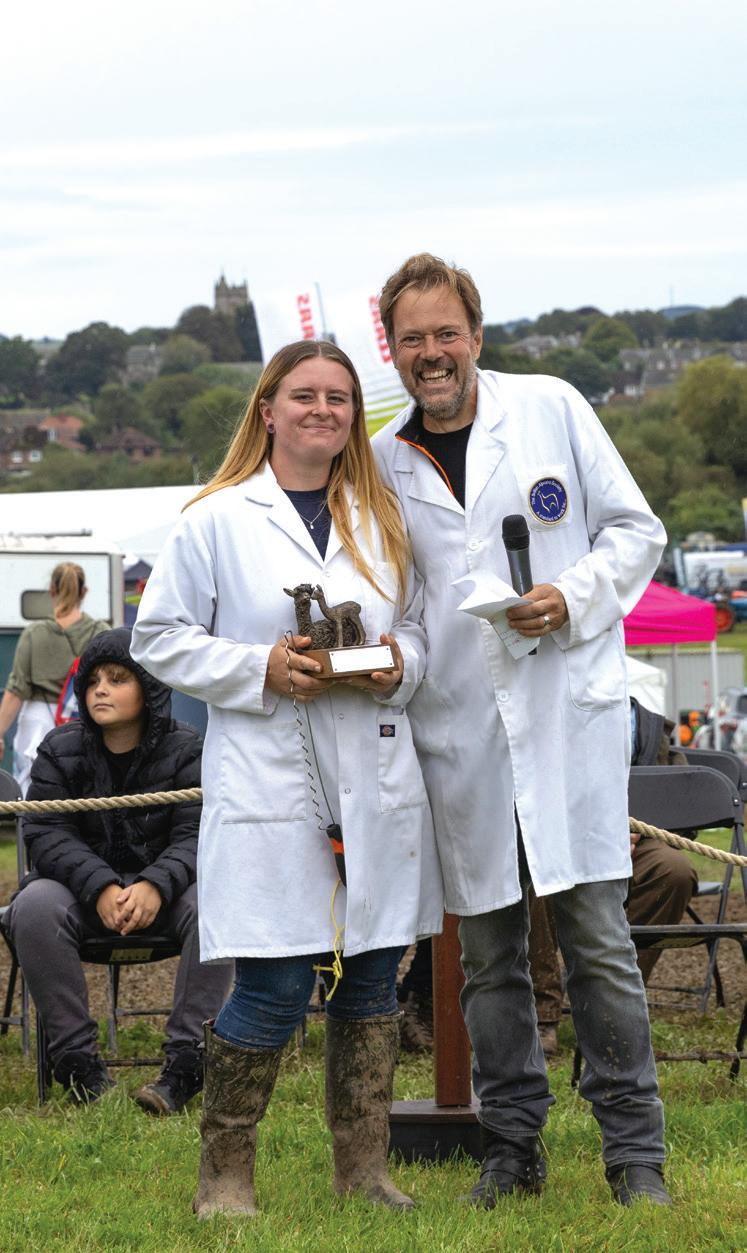

The junior handler classes added to the enjoyment of the show and the audience certainly seemed to want to watch the children demonstrating their handling skills. An exuberant alpaca in the placings line up did cause Nick to say if he hadn’t already awarded the rosettes he might be inclined to change his mind after some very impressive “holding on”.
In between the judges feedback, the crowds were kept entertained by the skilful commentary provided by Tom Scott of Dark Sky Alpacas and Tim Hey of Inca Alpacas, I even learned something new in between the (sometimes very funny) narration. The sponsors all had the chance to present the sashes and trophies for the classes they had sponsored, giving a real sense of community and the results were posted to Facebook in (almost) real time.
Exhibitors were kept watered and fed throughout the day with a superb rest area set up, which took some of the stress out of the days. It also acted as a social gathering space for the quiet times between classes. A small party was arranged for the end of the first day, with nibbles and a dry space to hide from the deluge outside.
The second day saw the Championship classes and the small, medium and large breeder awards and trophies. The show had kindly offered us a chance to join the parade in the main ring in front of thousands of visitors but unfortunately the weather had other ideas, next year will be a spectacle, I’m sure.
SWAG is one of the UK’s longest running regional alpaca groups, with its core membership coming from Cornwall, Devon, Dorset and Somerset. However, membership isn’t limited to those in that region and they actively encourage you to join wherever you are based. The group was formed to provide a network of alpaca owners to offer support, advice and encouragement to each other, as well as offering a range of educational and social events where members can learn and meet in an informal and friendly environment.
TV www.swagroup.org.uk
Huacaya Supreme Champion Inca Replay with Oliver Hey and Ring Steward Isla May
The feedback from non-alpaca people was so positive, from how amazing it was to see so many different colours of alpacas to how smart the stewards looked in their blue coats. I know a few potential future alpaca owners were also impressed and enjoyed talking to the breeders. The children were catered for with a craft table stocked high with a spectrum of colours of alpaca fibre and some alpaca art creations.
The BAS stand was a success and one we’ll be repeating next year. I was surprised and delighted by how many people stopped to look at the beautiful display of championship fleeces, superbly judged by Mr Jay Holland. Many commented how useful it was to be able to see the fleece score cards and fibre sample test results, to give context to the decision making process.
If you are an experienced breeder looking for a high quality show, then you should definitely add this event to your calendar for 2025. If you’re new to breeding, come along, enter some alpacas and you’ll be amazed at the support and encouragement you’ll get. People were more than happy to hold and show other people’s alpacas where there was a timing conflict or in some cases where they had more alpacas in a championship class than they had arms for, although next time, I think the advice to the novice show handler needs to be more than “Hi, you can hold this one, his grey fibre matches your grey hair!”
I said at the start that it was a year of many firsts for me. I overcame my reservations and entered the fleece show, which was daunting but ultimately very informative. The feedback will enable me to better show my fleeces next year as well as helping me understand more about breeding decisions. We used the wonderful Wool Testing Authority for fibre sample testing and the report was very useful, we’ll definitely be using them again next year. I wasn’t confident enough to enter the halter show, after all my fleece is very well behaved, I can tell it to sit and stay and it stays exactly where I left it but having been to the show and seen how friendly everyone was, I think the winter will see me upping my game with the halter training and who knows 2025 might be the first of many halter shows to come.
If you’re based in the SW and want to get involved in any way, no matter how big or small, reach out to the SWAG team, we’d love to have you on board.














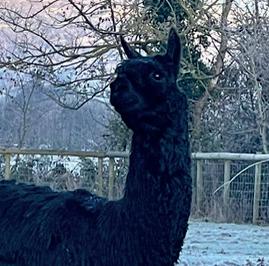



The HoEAG Fleece Show took place on 26-27 September, with the results being announced via a zoom presentation on Sunday 29 September, writes Julia Corrigan-Stuart, HoEAG Fleece Show organiser.




This year, due to the increased number of fleeces on the show circuit now, it was agreed to only appoint one Judge, Mr Tim Hey, joined by apprentice Kim Murray, who did a sterling job of judging the fleeces. Entries were capped at 140 and judging was undertaken over two days. We filled up quickly, with some herds unfortunately missing out – remember next year to get your entries in early.
As usual, we had a great group of helpers, who did a wonderful job, hopefully learnt a lot and made the two days very enjoyable.
The Wool Testing Authority kindly tested the micron samples for the show, which we are very grateful for.
The HoEAG Fleece Show results
• The Supreme Champion Huacaya Fleece was awarded to Beck Brow Centre Stage, owned by Beck Brow Alpacas, who was also awarded Best British Huacaya.


• The Judges Choice Huacaya Fleece was awarded to Bozedown Generation Now, owned by Bozedown Alpacas.
• Sheriff Yee-Haw was awarded Reserve Supreme.
• The Supreme Champion Suri Fleece was awarded to Pure Suri Phoenix, owned by Pure Alpacas.
• Best British Suri fleece was awarded to Bozedown Mystic Star
• The Judges Choice Suri fleece was awarded to Springfarm Digby’s Diamond, owned by Springfarm Alpacas.
• Springfarm D’Angelo was awarded Reserve Supreme.
• The HoEAG Special Awards were awarded again this year and the results of these, as well as the Colour Champions can be seen on the HoEAG website so please visit heartofenglandalpacagroup. co.uk and take a look.
A massive thank you to all the exhibitors, who continue to support our show, the judge, Tim Hey and all the helpers, we are very grateful.

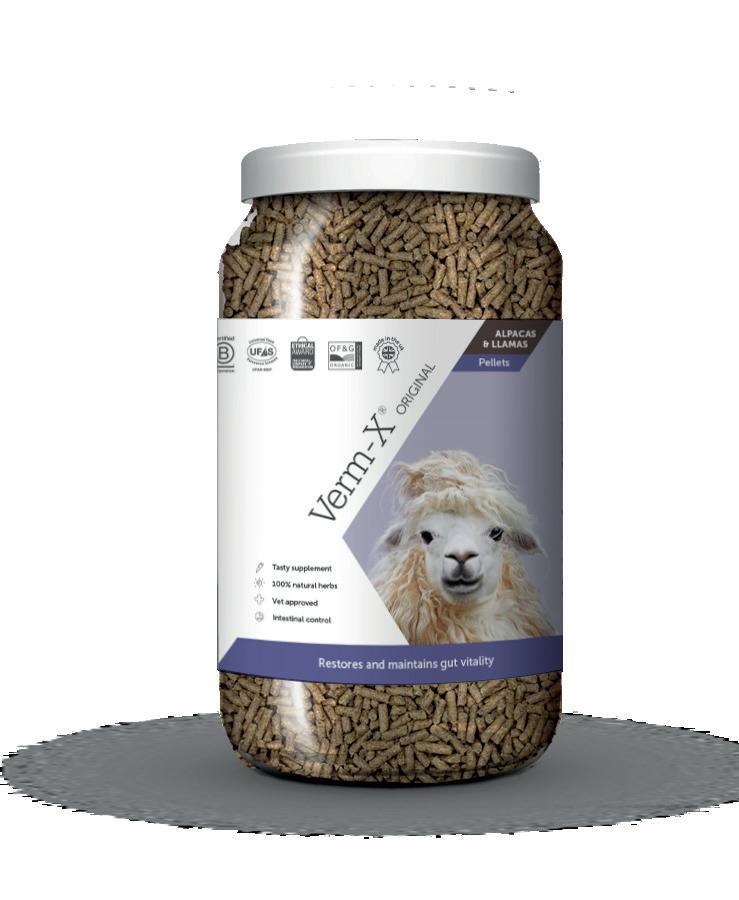
Barbara Hetherington says a successful showtime begins long before the show date.
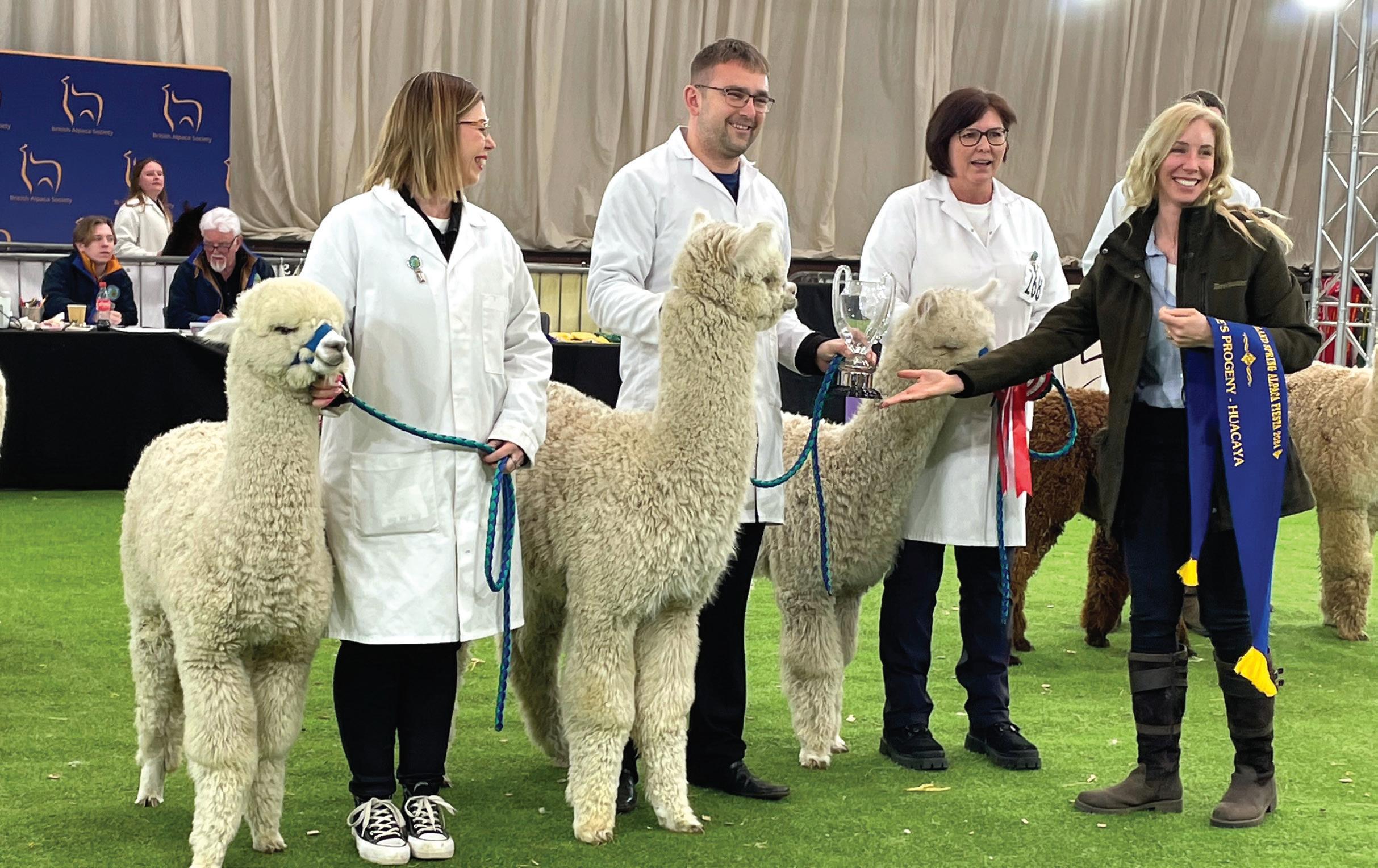
The New Year is the time when many alpaca breeders start thinking about entering their alpacas into the halter shows (which will be held throughout the UK). Without doubt showing entails preparation and expense. Here is why I believe it is an important and exciting aspect of alpaca ownership…
Preparation for showing essentially begins when we make our breeding decisions. We select our pairings hoping to produce those extra special cria who will make it in to our team. Yes, it’s a long game, especially as we want to see those junior prize winners repeating their success as intermediates. But this makes it all the more exciting.
Of course making good breeding decisions is the first step, but we don’t really know what progress we have made until we are assessed against others. This is why the junior classes are always so popular at the
spring shows. Ideally we should be improving with each generation and we all want to see where we are when compared to others.
Although, a note of caution here: do not necessarily write off your youngster on the results of one show. Alpacas are vulnerable to weather conditions prior to the show, as well as how well they travel. We can all have a bad hair day!
Attending shows is a great opportunity for education. We are fortunate that alpaca judges do not merely place the alpacas in order, but give reasons why one alpaca is placed above another. Thus, it is a very valuable exercise to listen carefully to the whole class reasonings not just your own alpaca (and don’t forget to do that either!).
It is not all about the colour of the rosette you have in your hand but the feedback that you received. Your alpaca could be placed fourth in one show but receive more positive feedback than the first placed at another.
Some shows/classes will have much stiffer competition than others. Do take up the opportunity to look at the other alpacas at the show. Most breeders are more than happy to let you look in the fleece. Some shows, including the BAS National Show, have pens where everyone is invited to inspect the champions.
The halter shows can be stand alone (just alpacas exhibited) or form part of a larger agricultural event. The latter are a great opportunity to promote the alpaca industry as a whole as well as individual herds. Many are held during late summer and early autumn when the fleece is short (thus results should be considered in context) but the footfall can run into tens of thousands. This provides a very economical way of advertising your business to a large audience.
The stand alone shows tend to be when fleece length is optimal and therefore can be judged more accurately. These shows mainly attract existing breeders or those already interested in alpacas. However, it is a great opportunity to promote your herd to your target audience, and to network with new and established breeders alike.
The majority of us buy into alpacas not only for the lifestyle they provide, but for the fun and joy they bring. Attending/exhibiting at alpaca shows is part of this. We have made so many good friends at the shows and made so many memories.
Win or loose we never fail to have so many belly laughs (and quite a few at my expense usually!)
I know for some showing may seem quite daunting at first. There really is no need, alpaca owners are a friendly bunch and help is always on hand. Here are some tips that might help.
Alpacas are shown in ‘paddock condition’, by this we mean no brushing, no shampooing, and no products. Straight from the paddock or barn.
However, few of us want our alpacas to turn up at the show resembling a walking hayrack or hedgerow. So whilst we cannot groom our alpacas, we can try to keep our paddocks free from thistles, sticky burrs and any other vegetation that loves to bury itself into fleece.
That said, there will be some cria who will get messy whatever we do, and they won’t be alone at the show.
With the exception of top knots (alpacas need to be able to see) and under the tail (the judge will examine the genitalia and doesn’t want any surprises) any fleece trimming post shearing is against the BAS rules, and will be heavily penalised by the judge. Toe nails should be trimmed if necessary.
Halter training should ideally begin post weaning. It is vital that the halter to be used is a good fit, and sits high up on the nose. When halter training begin with little and often. Five minutes of wearing the halter would be our starting point.
Once your alpacas are comfortable walking some distance, it is time to prepare them for their experience in the ring. If possible run a mock show. Have the alpacas walk towards the ‘judge’. Practice showing their teeth and having their genitalia inspected. Have the ‘judge’ lean over the alpaca and open the fleece. Learn to stand in profile and face on. An alpaca who walks confidently into the ring and stands well to be inspected, often catches the eye of the judge from entering the ring.
>> Continued on next page

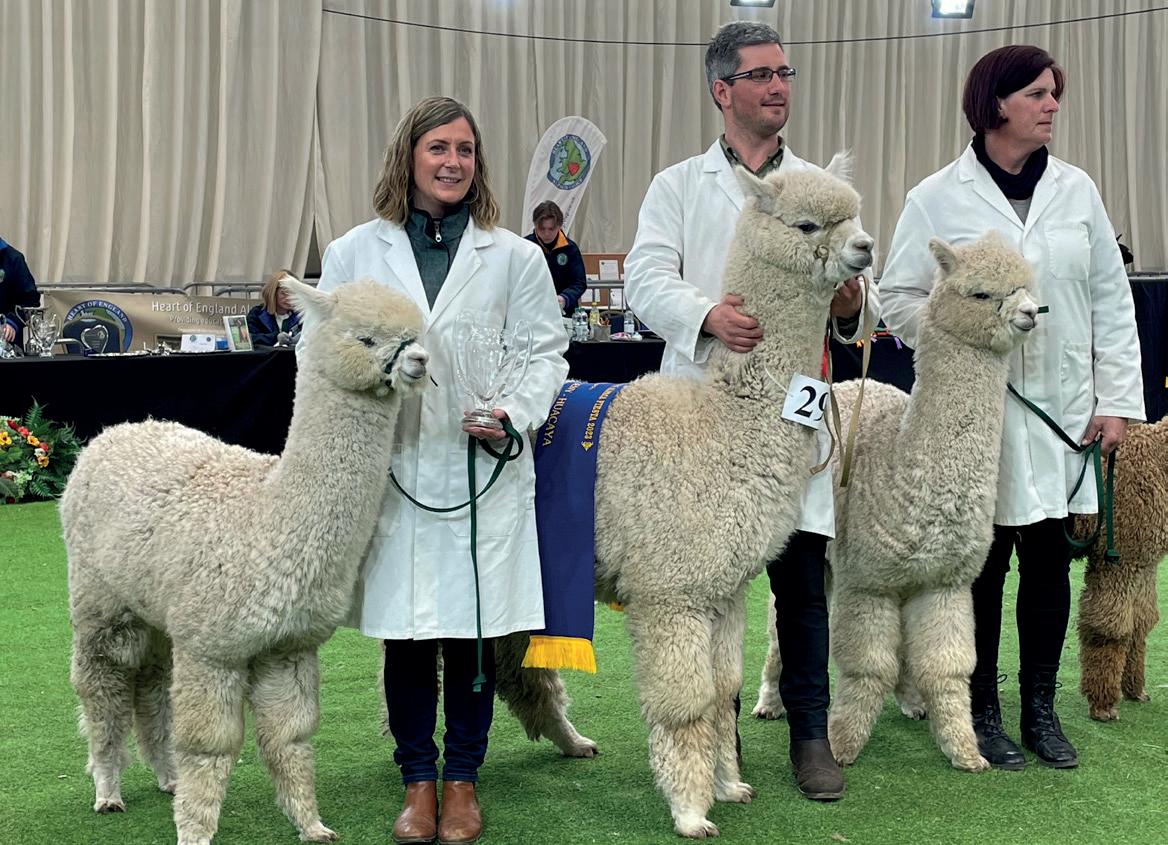

This really comes with experience and this is somewhat gained by showing in the first place. For the majority the purpose of exhibiting is to have their alpacas assessed and build from the feedback.
One thing to consider is whether you wish to exhibit at the smaller regional shows first, where you are more likely to be given oral reasonings. You are also less likely to have to stay overnight. At large shows classes can have up to twelve in the class and only six get placed and discussed. There will also be considerably less expense involved than exhibiting at the BAS National Show for example. If you are unsure, visiting the National Show as a spectator is a great experience and learning opportunity.
For those with rather more experience; remember to actually look at the fleece, just because it is from your best female and sired by a renowned stud, doesn’t mean that the progeny will always be as anticipated – it is not always easy to be objective about our outcomes.
That said, do not over examine fleeces; if it looked good on Tuesday, it will still look good on Thursday. All you will do is disturb the organisation within the fleece.
Also remember to reassess your show team from last season. A successful junior doesn’t always still look good as an intermediate. Equally, that junior you dismissed last year; did he need a first shearing before his full potential could be seen?
Remember 40% of the judging criteria is based on conformation, check that leg angulation. How are those teeth and testicles?
A week or so before the actual show, you will receive your Exhibitor’s Letter. This will provide you with all the information you will need about arrival times and directions:
• Remember to check your microchips at this point if not using ear tags (ear tags must be in the alpaca’s ear if used)
• Double check your hotel reservation if applicable.
• Have a checklist to ensure nothing is forgotten.

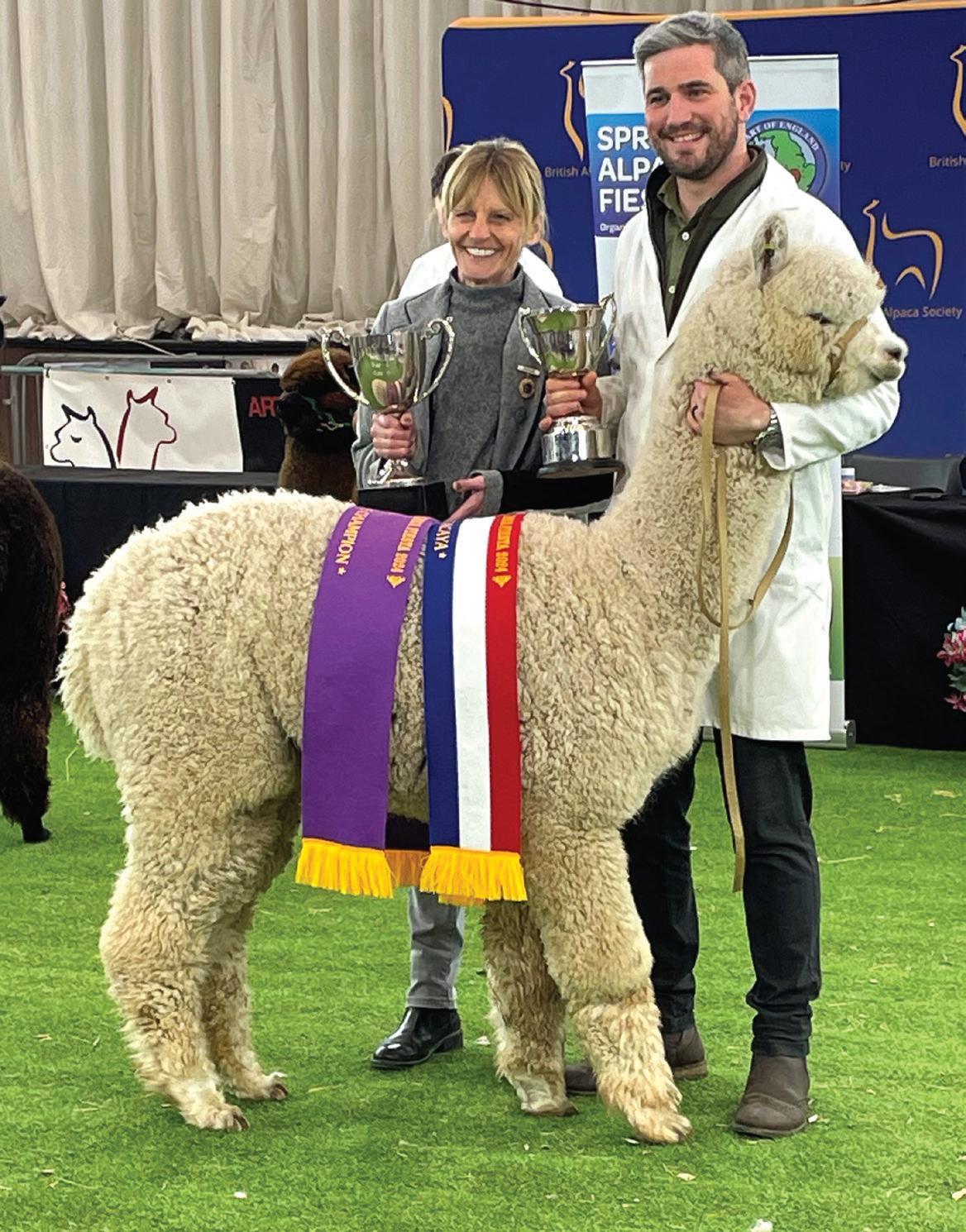
It is important that the alpacas are show ready. This includes checking for any signs of mites, checking are the alpacas in good health? What is their body score? Have you wormed your show team or had recent negative faecal egg counts?
Showing can be stressful for an alpaca who is not in perfect health. It may be disappointing, but any alpaca with a poor body condition score must be left at home.
Ensure your transport is comfortable and adequately ventilated. A long journey may require a number of pit stops to allow your alpacas to stretch their legs and toilet (have some droppings in the trailer/van to encourage this). Provide water, especially during hot weather.
It is essential to have enough halters for all alpacas travelling (in case you need to move your alpacas at any point on the journey). It is also advised to have specialist livestock breakdown cover, this is to ensure that the recovery service will rescue your alpacas as well as your vehicle.
Once you have arrived at the show and your alpacas are unloaded, and food and water supplies are in place, your alpacas will be inspected. This is to ensure they are the correct alpaca (ear tags or microchips will be checked) and that they are in the correct colour class (colour will checked by the inspection steward/chief steward. Any disputes will be resolved by the judge before the show commences).
Ensure supplies of hay and water are adequate at all times and your pen is kept clean.
Watch the running order and be ready for your class. You will be called to the collecting ring in plenty of time before your class commences.
Showing is fun. A way of making new friends. Relax and enjoy…when you are in the ring remember to breathe … and to listen to the oral reasoning, because having your alpaca critiqued by the judge is the main reasons that you are there!
A select herd of quality alpac as with excellent pedigrees and genetics, located in Scotland.
We provide:
•
•
•
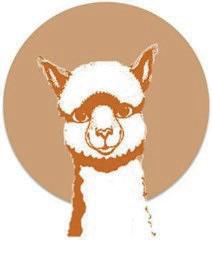




BobCat A lpa
BobCat A lp
BobCat A lp
Edinburgh, Scotlan d
Edinburgh, Scotlan d
Edinburgh, Scotlan d
www.bobcat -alpacas.co.u
www.bbobcat -alpac as.coo.u
www.bobcat -alpac as.co.uk
+44 (0) 7963324922
+44 (0) 7963324922 Dedicated to the care and breeding of quality alpacas
+44 (0) 7 796333224922 Dedicated to the care and breeding of quality alpacas
Dedicated to the care and breeding of qualit











Louise Holland of Flatlands Alpacas shares what inspired her to write her book for children, beautifully illustrated by Holly Taylor, that contains plenty of advice on alpacas and their care in a delightful format.
My journey owning alpacas began due to my love of animals. We had ponies, chickens, cats, dogs, goats, sheep etc as pets while growing up, and I really enjoyed interacting with them. I don’t really remember when alpacas came to my attention, but I remember finding them interesting animals (even though I had never actually met one).
I spent a few years trying to convince my mum to let me keep an alpaca on the farm, when she finally agreed I began researching their care. I bought every book available on Amazon about keeping alpacas (although there were not too many available). This is when I discovered that three was the recommended minimum number of alpacas to keep. I found a registered breeder not too far from me, and I went to visit them to discuss purchasing my herd.
We spent a good few hours discussing all things alpaca, care and feeding, and had a tour of their alpacas. They delivered my first three alpacas in 2019.
It was only a matter of months before I added two more alpacas to my herd, then a few years later my herd grew to nine alpacas.
I enjoyed speaking with the breeders I purchased my alpacas from, their advice was invaluable when I was learning the basics of keeping alpacas, likewise with my shearer, I still call upon his knowledge if I am after any advice.
My intentions were to keep the alpacas purely as pets, this changed after the pandemic. I felt incredibly fortunate to have been able to continue to spend time outdoors with the alpacas, doing the routine animal care jobs on a daily basis, when many people were isolated inside their homes. I found that spending time with the animals meant I was not feeling the isolation that many people did during that time. When restrictions relaxed I began getting enquiries from local people, who knew I kept alpacas, about visiting the alpacas to spend some time outdoors with them. And so, I fell into my current business which is having visitors to the farm to meet the alpacas.
I spoke initially with my vet, who advised me to get a licence and insurance in place to open my business, which is what I did. I started with a meet and greet maybe once a month. The experiences I offer now have developed mainly through visitor feedback, and some chance encounters which have led me down particular paths.
I don’t offer trekking as we don’t have anywhere interesting to go where we are based, and our field setup wouldn’t make an interesting walk either.
Upon developing the alpaca experiences I offer, I found I was quite

good at waffling all things alpaca to people, any questions from guests which I couldn't answer I would research, so I knew for next time. I still do this as I am always keen to improve my knowledge. This is how the educational side of my business has developed.
I now have regular visits from local schools, pre-schools, colleges, U3A groups, and community groups. I work closely with our local college to tailor visits for their animal care students. The students assist with husbandry jobs, such as toenail trimming and administering oral vitamin paste, we also have some class room time in our cabin, where we learn about natural history, fibre, origins of alpacas, sustainability and more.
I wanted to write a story for children which would be educational, and enjoyable. I remember particularly enjoying rhyming books as a child, so that was the format I decided to use.
When writing my book I actually wrote the lines on last page first, I started with the ending!
I wanted the book to summarise how I feel about alpaca ownership, not just caring for the alpacas, but the relationship between alpaca and owner, in essence what we get from the animal. I didn't need to think very hard, because for me the most rewarding part of owning alpacas is the trust they share with you. Trust is important to alpacas, and to me, the ultimate reward is when your herd trust you as though you are part of their herd. I wanted children to learn that dedicating your time and care to an animal, and gaining their trust in return is special.
So I began with the last line: It will take time for them to see you as one As part of the herd and second to none Because what people don't know is the trust they extend When you’re truly a herd member, you are truly a friend.
I then moved onto the story line, I wanted to point out the differences between alpacas and other animals. I drew upon my experiences of watching children interact with the other animals on the farm, and what they notice about the other animals. I realised children like the noises animals make, and how animals behave, for instance children really enjoy watching our naughty goats getting up to mischief, or the cockerel when he crows, and of course all children are fascinated when any animal has a poo! I watched children move around the farm asking about each animal they come across, and that was my story line decided, although I had no title for my book yet.
I wrote the book from the perspective of a child going around a farm and asking about the animals they come see, but they are actually looking to find out what is an alpaca. I included some of the animals we have on the farm, which proved popular with children who have visited and bought the book. I gave the first draft of my book to my neighbour, who



The search for an alpaca is published by Taylor and Wood publishing and priced at £7.99
TV www.flatlandsalpacas.co.uk
proof read it for me, and added the title The Search for an Alpaca
I had no idea about how to get a book published or illustrated, I researched on the internet, but found the answers a little confusing. By chance I was scrolling through a business page on social media, and read a comment whereby someone was asking for recommendations for a publisher. A publisher responded to the comment so I sent a message to the publisher.
That’s how I met Holly and Nicola. They had just opened their own Publishing House and my book was the first book they published. They made the process very simple, and produced the illustrations for me.
I was so proud to receive the final draft, and excited to hold a copy of my book. I gave a copy of my book to local schools and pre-schools, and I have done a number of readings in different settings, one being to members of a care home, which was organised by Pat Bentley. Pat literally wrote the book on alpaca guidance, so I was over the moon when she enjoyed the book I had written.
I have met some wonderful and interesting people through owning alpacas, whether it be visitors or breeders, and many of the opportunities that have come up along the way have been chance encounters. I look forward to what opportunities and encounters lay ahead, and spreading the word about alpacas to many more people.



Will this be the final spring for colour testing? Or can we still affect the outcome? asks Carita Saarinen, Futuregen. The long awaited new Colour Genotype Calculator will show you how you can benefit from this information. Now is the time to vote with your actions.
Initially, this was supposed to be a completely different kind of an article with a completely different looking horizon.
We have come a long way since first introducing the Alpaca Colour Genotype testing to breeders across Europe and Worldwide in 2021. Colour testing has now become one of the standard procedures within herds that want to make more targeted mating and sales decisions or those who simply want to offer improved service to their customers and learn more about their unique alpacas. Information and education has been globally shared together with breeders and associations, articles have been published in different magazines, seminars have been offered and tools such as Dark Sky Genie have been developed. I feel that we were given something to get excited about and something to inspire our everyday lives with these fascinating animals.
On top of all this, in January 2025 I finally got the happy news of Kylie
No matter which colour your breeding is focusing to, using the colour genotype information will increase the odds
Munyard having her intensity project finished, which would be ready to have been added to the current colour test.
Sadly, in January 2025 the unexpected happened and the only lab in the world providing the Alpaca Colour Genotype test, Neogen Ltd, decided to end the Alpaca Genomics testing services with short notice. The last day any Neogen offices would accept samples in and proceed with their testing is 31 May. Any samples that arrive at their offices after this date, will be returned to the sender. So please, if you still have unused tests, that you have paid for, or if you want to have some colour testing done to your herd, please proceed with your tests ASAP! Orders can be placed until the end of April at www.futuregen.fi.
This is a real set back to everyone that has been excited to have this information on their herd and after all the efforts relating to this venture. We, Futuregen and Neogen Europe, keep working together to find a new provider in Europe and hopefully there will be a lab to take over this complex

Colour Genotype Calculator
Scan the QR code and see what your alpacas could produce
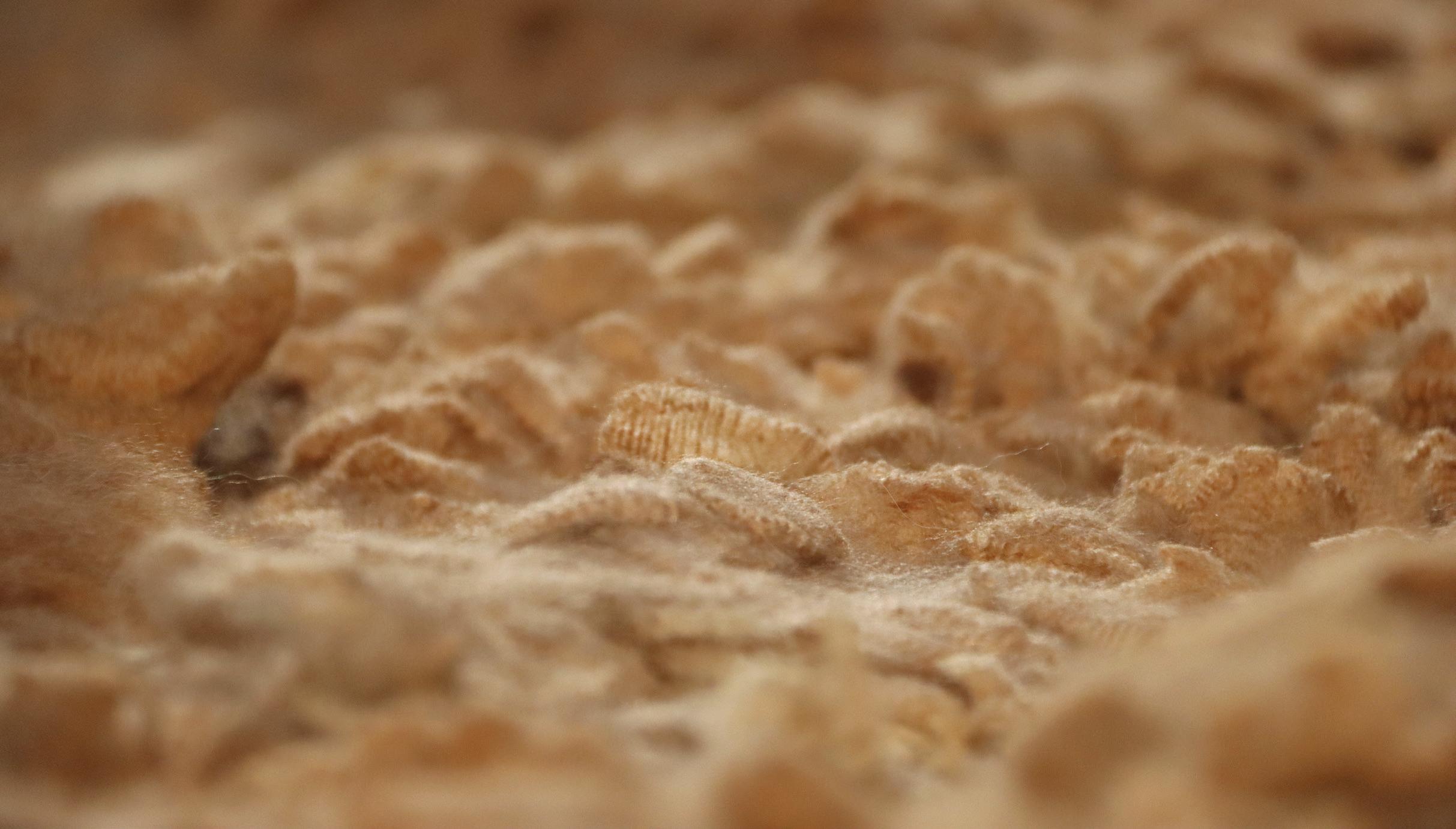
test with a small annual testing volume going forward. I want to pass my warmest thank you to all of you that have been involved along the way, providing the invaluable case examples, sharing experiences with us and of course, added the Colour Testing as part of your herd breeding programmes and shared the information with the fellow breeders. For us, the numbers having grown by four times since 2022, highlights that more and more breeders have found this tool useful in their selection process. I guess that is something to be proud for.
If you think that the industry needs DNA testing services going forward that provide information to improve our breeding strategies, then this is the time to take action! It will only have a future if breeders use the test. Your contribution will be highly valuable.
The most exciting new addition to the Futuregen website is the long awaited Colour Genotype Calculator designed by the talented Manuel Staub, from Manu Alpaca Services, Germany. The calculator will show you the possible outcomes of each mating with the probabilities of each in percentages and pictures expressing the range of colour each genotype is known to display, with a short description. This will help you work with the genotype information and successfully improve your breeding strategies. (Always keeping in mind that health, conformation and fleece quality is not compromised over the colour, of course).
Not news but rather a reminder. Futuregen website offers a map of the Colour Tested Herds in Europe, that provides free visibility for European farms that have done the colour genotype testing on their alpacas. Anyone that is seeking local farms providing colour genotype information, can easily find these contact details in one place. If your farm provides this information, but is not yet on the map, just contact Carita via email and your farm will be added.
Futuregen has run several trials over the years to learn more about the different ways of carrying out DNA sampling on alpacas; how to help owners choose which method to use and how to make sure the sample taken would perform the best way possible at testing. Both testing methods currently available have proved to be very successful. Blood sampling on FTA blood cards had the success rate of 99.15% (Futuregen trial 2021) and the average success rate of all the blood card samples tested in 2024 was 98.7%.
Breeders can take the blood sample themselves by using an injection needle and pricking the edge of the alpaca’s ear to get a few drops of blood on a paper blood card. However, this may sometimes be seen as a little uncomfortable and a time demanding procedure – in case there are problems in finding a spot that will bleed, it closes too soon or the animal is not behaving well. Many owners prefer veterinary assistance to take blood samples in the jugular vein. This of course adds the costs.
>> Continued on next page
“There are no specific age requirements for sampling crias. I personally prefer sampling after two months of age.”
Carita Saarinen, Futuregen

Start planning your matings for 2025 by using the Colour Calculator at www.futuregen.fi
Swabs offer a non-invasive and quick alternative for the blood sampling. It is easy for novice users to do and does not require assistance with well behaving alpacas
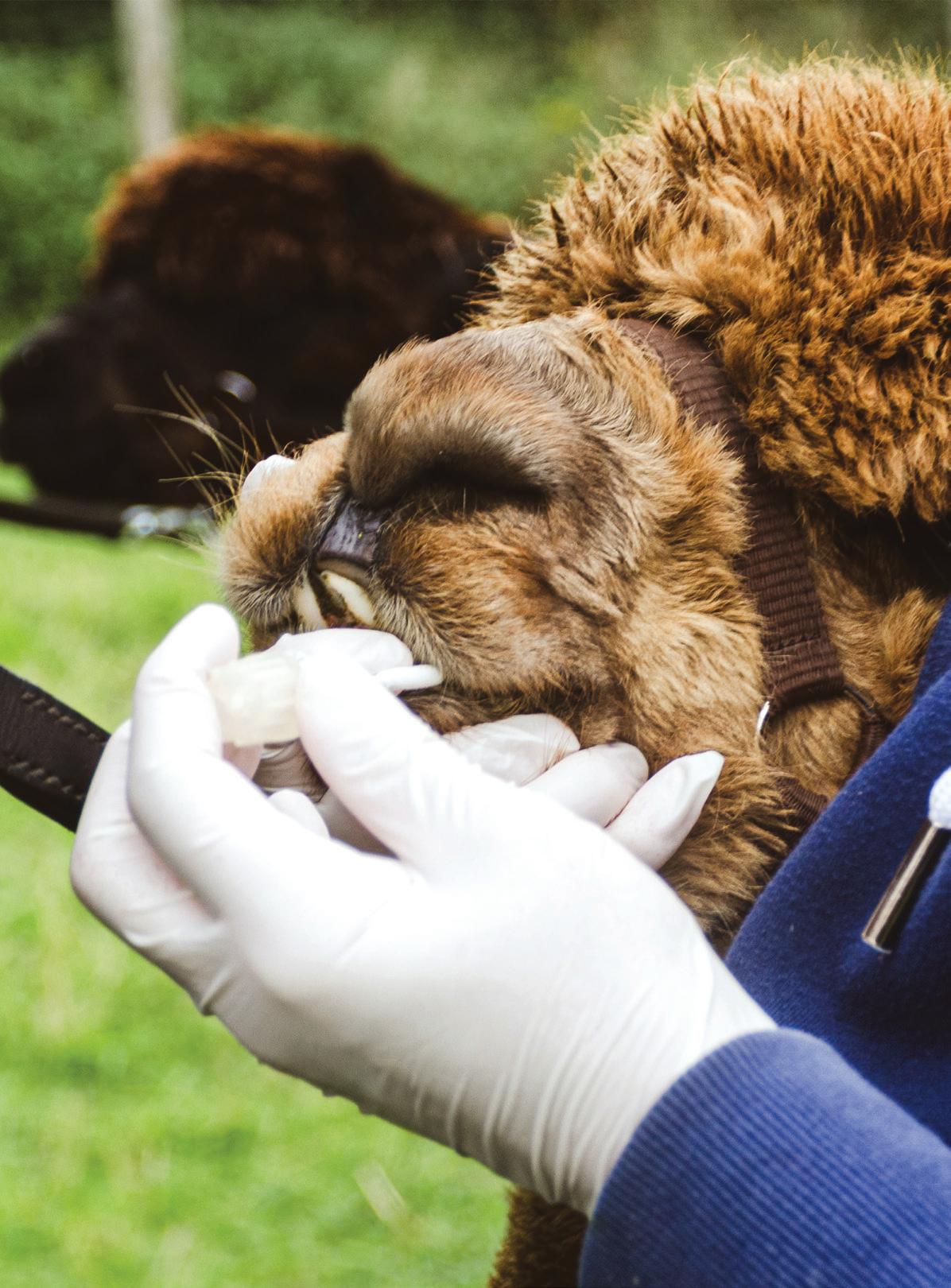
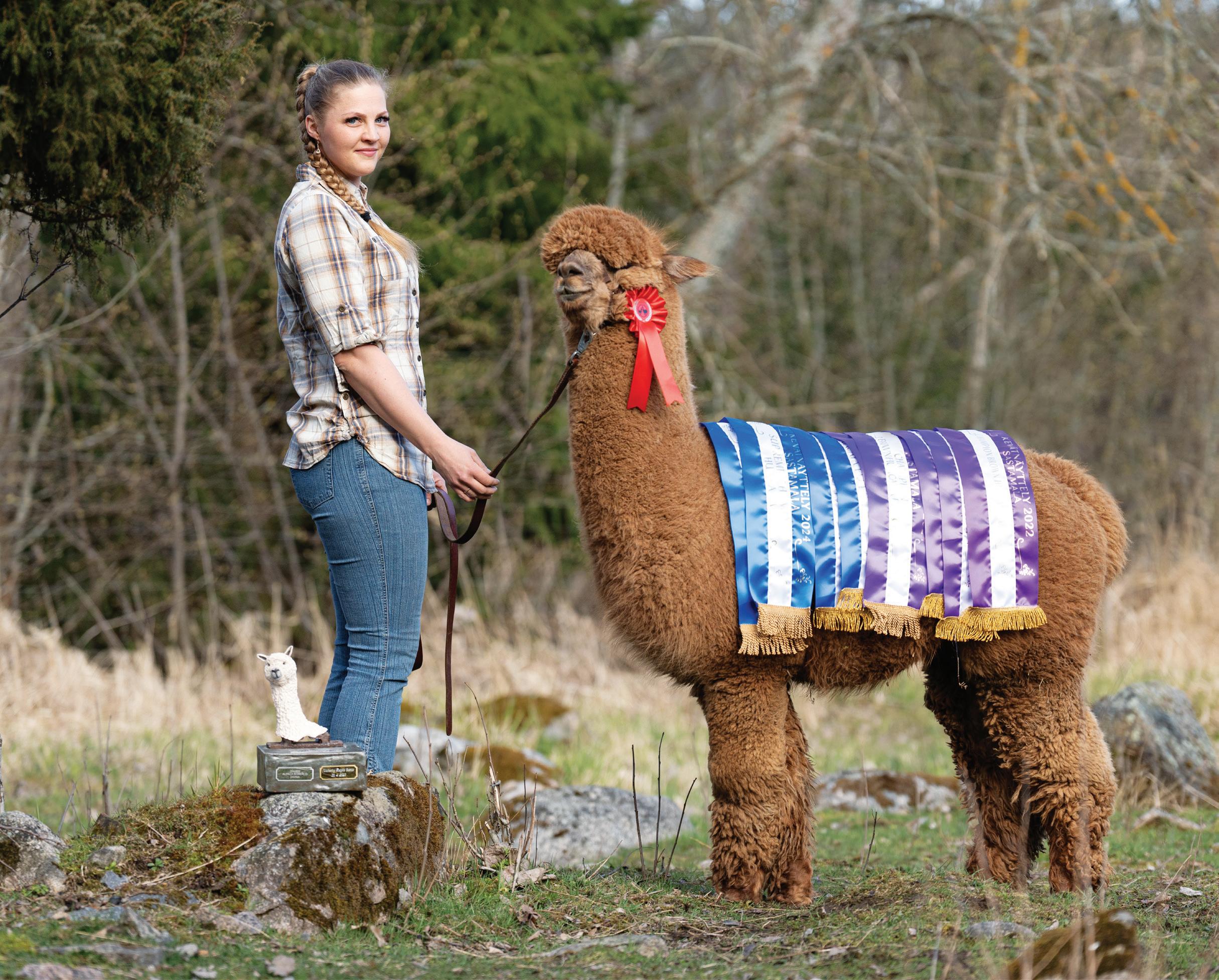
Offer more advanced service to your customers by providing the colour genotype information of your sires that are available for stud servicing
With swabs I got 96.7% success rate at a trial in early 2024, where I compared the samples taken from the nose and samples taken from the mouth. The difference between those two ways of swabbing was extremely minor – the success rate with nose samples was 96.702% and mouth samples 96.703%. The trial was run with 13 alpacas, which were from three different farms and were all tested in both ways. The average success rate of all the swab samples tested in 2024 was 97.8%.
Swabs offer a non-invasive and quick alternative for the blood sampling and more and more of our customers seem to prefer it. It is easy to use and does not require assistance with well behaving alpacas. I was pretty pleased to see, that the mouth sampling won the comparison over the nose, if not by more than just a hairbreadth, as it is an even safer and more comfortable way for the alpaca. I wanted to study it a bit further to find out if there was anything that could go wrong with the mouth sampling. So in the autumn 2024 I carried out the final trial.
As many breeders now want to test their crias when they are still unweaned, I wanted to learn if the possible remnants of the dam’s milk could affect the sample/result. I compared swab samples collected from the mouths of five of my own crias. First I took a sample from each cria after they had been separated from their mums for an hour and had their daily meal, making sure there was absolutely no milk in their mouths as I took the sample. After this I released the babies back to their dams one at a time, let them nurse for a while, interrupted them for sampling making sure there was milk in the samples and let them carry on. The results were quite surprising. Each cria had exactly the same alleles in both of the
test results! Even though the trial group was very small, it still shows that it is not likely for the possible remnants of the DNA in the dam’s milk to confuse the test result. However, three of the samples that had milk in it, had one No Result (NR) call in one of the six mutation alleles. In that sense it looks like it can affect the sample quality a little and give a lower success rate. So best to not go and interrupt nursing for sampling purposes if you prefer a higher success rate.
You can now choose your preferred sampling method from the website while you are purchasing your tests. The updated sampling instructions are on the Futuregen website under Colour Genotype Information –Futuregen Material. You will also receive them together with the shipping instructions and documents after you have placed and paid for your order at Futuregen. Do not hesitate to email Carita for further advice.
Probably the biggest and most important improvement we made with Neogen last year was beginning to offer free retesting from a fresh sample for samples that fail to give the complete MC1R and ASIP Genotype (both genotype pairs, four letters in total being present), and/ or the grey/non-grey status was missing. Free retesting is not possible if there is a complete result (all four letters present) in the MC1R and ASIP Genotype column and if the grey/non-grey status is present, even if some of the mutation allele calls had an NR result. This is currently available for Futuregen customers only and information was included in the first Futuregen newsletter that went out on 29 August 2024. Please
subscribe to the newsletter from the Futuregen website in order to receive any upcoming news.
Sometimes the test may show an NR call in one or more of the seven columns in the testing reports. This means that the test was unable to obtain a result for that particular allele. In some very rare cases the sample might fail to give any result at all, so the whole row shows NR. This might be caused by various reasons and the lab team would always routinely rule out any obvious quality issues by visually carrying out a QC (Quality Control) check to spot any samples that do not seem right for testing. If the sample fails the QC Check, the breeder will be informed of such a sample not proceeding into testing and a new sample is required.
The samples that pass the QC Check, will be tested. Any samples which produce NR calls and are likely not a DNA issue are sent for reprocessing within the task to rule out the possible issue in the testing process itself and make an internal note for it. If the sample fails to produce a result on the second attempt, the lab team has to report the result as NR as after two failed attempts the expectation is that it may be an issue with the sample. Essentially the majority of fails are related to the quality of the DNA as the process is reliable. If the sample got multiple NR it is likely a DNA issue and a new sample would be required to redo the test. Neogen does not do redos for any samples unless there is a suspicion of a processing issue, this is the company policy.
If you have received a result that would be eligible for a free retest, please send Carita an email where you write the name of the animal plus the order number and we will send you a new card for a retest. The same paperwork, such as the sample submission form will be required.
The current sample submission form has a column called ”Sample for a retest” and you need to type ”Yes” in this column for such samples. You will receive the sample submission form after ordering.
Please note, that the last date Neogen is able to accept any samples for testing is 31 May. After this, I do not think any free retests are possible.
Please do not hesitate to get in touch if you need any further information regarding failed samples/incomplete results.
• Visit www.futuregen.fi
• Choose your preferred tests.
• Choose your preferred sampling method and confirm your order.
• Proceed with the payment through PayPal. After this you will receive all the instructions and documents via email on how to take samples and prepare the shipment to Neogen Scotland.
• Swabs will first go to DNA extraction in Ayr, which takes a couple of workdays. All the alpaca Genomics testing is currently carried out in Australia. Neogen Scotland will ship the samples to Australia in batches of minimum 24 samples at a time. Blood cards will be shipped without extraction. Once the required minimum number is received at the lab and the samples have been shipped, the turnaround time for the results to become available is 30 business days. Futuregen will inform about the samples being shipped.
• Please note, Futuregen is not responsible for the storage of the samples at Neogen. If you need further information relating to your samples, please contact genomicscustomerservice@neogen.com. Best of luck to everyone in 2025. Let’s keep the wheels rolling.
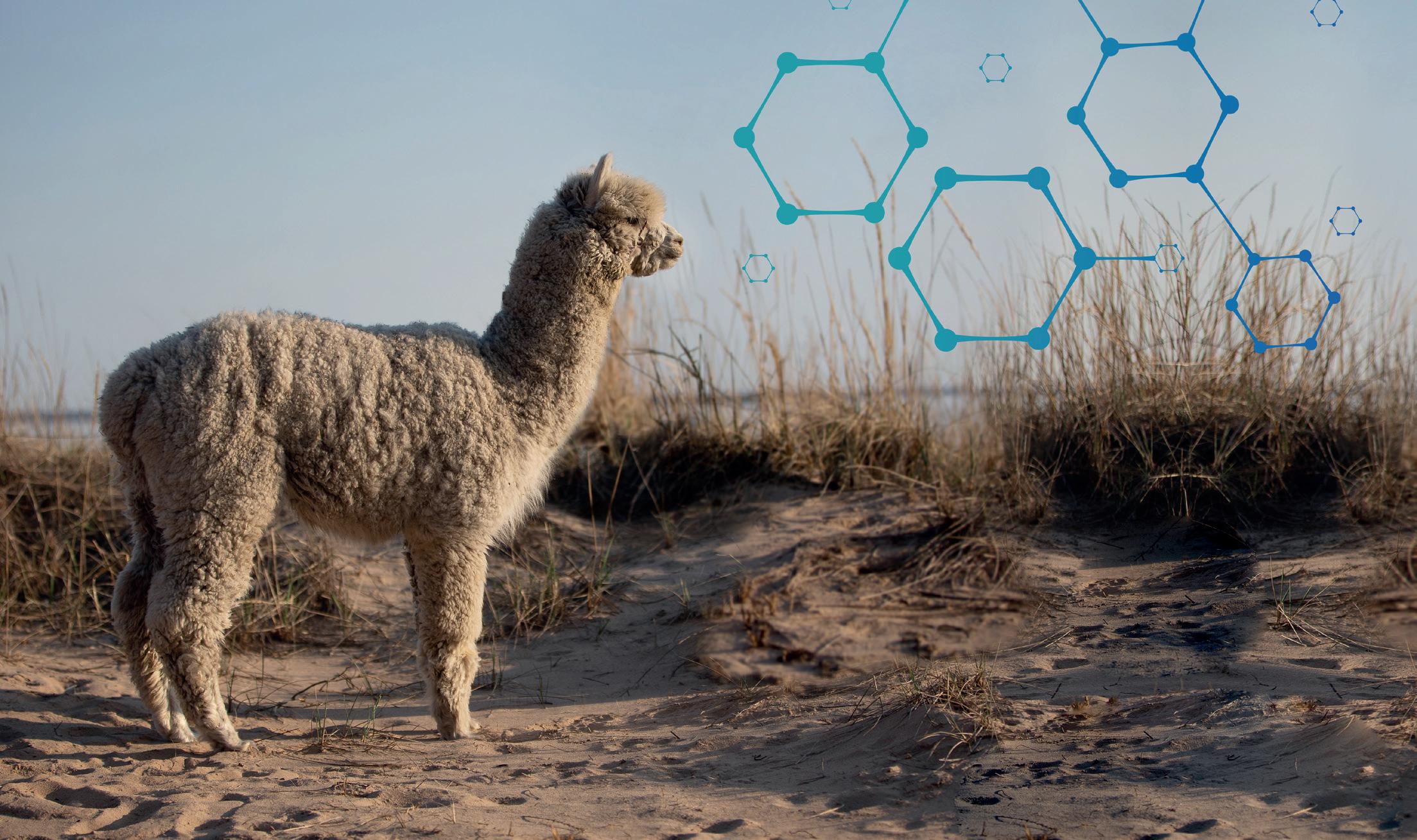
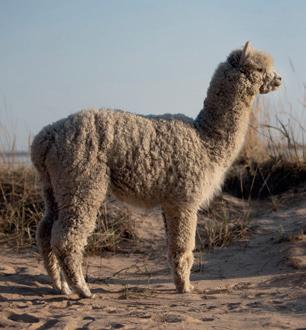
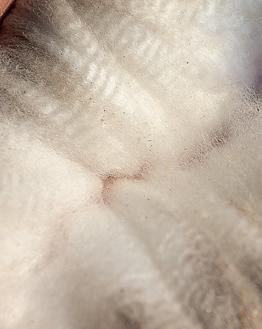


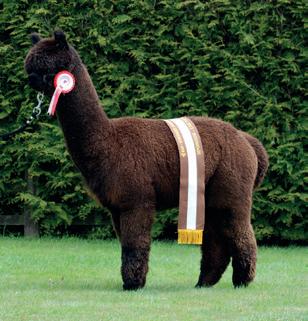

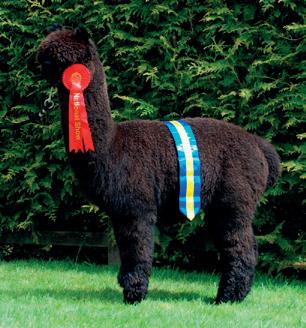

Doug Steen explains the purpose and background of this quick glance information tool for good welfare.
The idea for this infographic came about when I was involved in representing camelids with regard to livestock worrying (such as dog attacks). Although fortunate not to have experienced this ourselves we do have a public footpath through one of our fields so I feel we are at risk. I was involved with numerous incidents as part of my role as director of Welfare for the British Alpaca Society. When discussing this issue with one government group involved with livestock worrying legislation (the All Party Working Group for Animal Welfare – APGAW), I noticed that they had been involved with the production of an infographic designed to highlight key welfare information for rabbit owners/ potential owners at a quick glance.
I realised that the alpaca community had nothing similar although there is a wealth of information spread across multiple documents/media. I decided therefore to look at creating an alpaca version which I figured would be quick and easy! I fairly rapidly realised that deciding what the essential key items needed to be was not as straightforward as I had thought!
I contacted a few people to get a bit of a steer on the content and then worked with ‘The Vet Shed’ and a local graphic designer ‘Lightning Signs’ to produce the final document over many months. There was a need for simplicity and readability but also to cover the essentials that prospective/ new owners need to consider when keeping these fascinating and rewarding creatures.
There will inevitably be some disagreement on things that have been left out and possibly some of the content but I think that all of the content has been discussed, written about, and is backed up by many years of experience and from multiple sources. One always has

to remember that just because you can (or do) it doesn’t mean that you should; and that how things work out on someone else’s land won’t necessarily hold true on your farm/ smallholding. When learning more about the care and maintenance of these animals I believe it is important to be well informed and use published materials and not rely too heavily on anecdotal information often found online which, whilst well intentioned, may be wrong and even harmful.
Asking lots of questions before taking the ‘leap’ into alpaca ownership; buying
from, and keeping contact with, reputable breeders who should be there with you on your journey should prove invaluable.
With luck this infographic will give those thinking about keeping alpacas some help in identifying key requirements in advance and a starting point for doing more research (for example the BAS has fact sheets and videos which are vet checked and peer reviewed with lists of literature/books on all aspects of health and welfare). When done right, keeping alpacas is a fabulous activity but then I may be slightly biased.
Teesdale Alpacas are Doug and Sam Steen, based near Barnard Castle in County Durham; Doug and Sam have kept alpacas since 2008 (and also llamas since 2018). They have been passionate in improving the welfare for all camelids from the beginning of their camelid journey. Doug has served for a time on the British Alpaca Society board of directors and Welfare committees as well as contributing articles, creating and updating welfare documents for much of that time. Doug has also liaised with a number of government departments, MPs and various groups and agencies in several areas including bovine TB and Livestock Worrying Legislative efforts and continues to be active in this independently and actively promoting alpaca (and llama) welfare.
‘Pre-Purchase’ Research and Prepare Buy the right alpacas Are you ready for them? Alpacas can live for 20 years
Fresh Water at all times
Free access to good hay all year round
Feed appropriate camelid feed
• at the correct daily rate
Ensure extra vitamins over winter months
• Do not feed grass cuttings
Any fruit and vegetables even cut small
• may present a choking hazard
•
•
•
• Provide adequate space
• Fence securely and check for any toxic plants
• Provide suitable shelter against wind, rain, sun and flies
• Shelter should be light inside with large opening/doors so one animal cannot block it
• Take veterinary advice before grazing with or over the fence from other livestock
• Max 4-6 animals per acre of suitable land for grazing and exercise (not less than 0.5 acre required)
• Should be kept in groups of 3 or more in single sex groups only
• Males are best castrated but not before 18 months of age
• Do not remove animals on their own or leave a solitary animal behind as they will become stressed
• Alpacas may spit at each other as communication but are generally very calm animals
• They will roll and create dust pits and use a communal dung pile

• Microchip and register alpacas with BAS
• Register with vet with relevant experience
• Vaccinate annually against Clostridial disease
• Check all animals every day and be suspicious of any unusual behaviour
• Be alert for fly strike in warm/ moist weather especially in heavily fleeced animals
• Feed and check fresh water
• Clean up toilet area to reduce parasite challenge
• Organise help in advance if you are going to be away
• Training courses are available
• Discuss parasite control and faecal worm egg test regularly
• Toenails will need trimming 3 or 4 times per year
• Shear annually – book shearer In good time
• Provide extra Vitamin D over winter months
Credit to ‘The Vet Shed’ and ‘Lightening Signs’ for their help and assistance
By Charlotte Brockwell, Cadbury Alpacas.

Module 5: understanding shearing day
Alpacas are a relatively new addition to the British Countryside, exports from South America to the UK started around 1996 as a commercial enterprise for fibre production. Originating from a very different climate in South America, camelids have specific husbandry needs in our climate which is paramount to their welfare. However there are still unregulated novice breeders and new owners acquiring welfare cases and “rescue animals” for example with house moves, without the education and support
Charlotte has been running Cadbury Alpacas in North Somerset for over 12 years.
To find out more about her BAS affiliated courses: TV www.alpacaemporium.co.uk
To find more BAS affiliated trainers and courses throughout the UK: TV www.bas-uk.com/training-courses
of an experienced alpaca farmer.
As alpacas are stoic (able to mask illness from potential predators), sometimes new owners don’t seek knowledge until an animal “suddenly” becomes unwell from the effects of not having their needs adequately met.
In some cases this may be avoidable as access to information is easily available online and through the BAS affiliated courses.
Well bred animals with good commercial fibre should be fetching premium amounts enabling reputable breeders to improve our national
herd fibre quality and commerciality, and educate new owners. Instead rescue animals, herd disposals and welfare cases flood the market which then drops the value of good fibre producing non-breeding animals, as does the lack of a profitable commercial outlet in the uk for their fibre (a work in progress), as there is only enough processable fibre to support mini mills in the uk which drives the processing prices up and profit margins down. Owners learning how to use their fibre (modules 5 and 6) may help change this situation as we work towards establishing a commercially viable eco-friendly UK fibre industry.
The BAS recommends buying alpacas from BAS members who follow the Code of Conduct For Sale which includes full after care advice and support. Selecting the right breeder for support if you are new to this is just as important as selecting the right animals. One way breeders can help new owners is to offer or recommend a local BAS affiliated husbandry course which are run throughout the country by selected alpaca owners and breeders who follow an approved programme of modules combining practical hands on learning, alongside facts and power points.
There is usually a discount for couples and lunch is included for full day courses. There are also lots of resources and husbandry fact sheets on the BAS website.
If you have acquired welfare cases please seek support from a local breeder and acquire husbandry information from a course or reputable resources. Unfortunately some “alpaca rescuers” could potentially neglect their specific needs from lack of knowledge, and there’s nothing worse than novice owners exhibiting animals with poor welfare to the public for walking or petting without themselves knowing the basics.
A basic day long course consisting of modules 1-3 will set you back around £100 or less, a sound investment to avoid heartache and expensive, preventable vet bills.
Education is useful to new and potential owners alike to ensure the delivery of the alpacas’ essential needs such as life in a group of same sex alpacas, access to shelter, fresh water and hay at all times, appropriate camelid minerals and vitamin D, regular worm and parasite screening and treatment if indicated, foot care, body condition scoring, vaccination and shearing.
Owning alpacas can be one the most rewarding endeavours but if you are unable to offer the basics for animals who can live around 20 years, please consider rehoming to someone who can by contacting the BAS welfare officer, and if you can re-home an alpaca, similarly please get in touch with the BAS.
Courses are offered all over the country by BAS Affiliate Trainers based on a set of nine modules approved by the British Alpaca Society. The first three modules are the essential ones for new and prospective owners and usually offered together as a single course.
Module 1: Feeding and basic management
Module 2: Vaccination, Supplements, Illness and Ailments
Module 3: Handling Alpacas
Module 3a: Herding and catching
Module 3b: Fitting a head collar
Module 3c: Basic Halter Training
Module 4: The Alpaca – What to look for
Module 5: Understanding shearing day
Module 6: Fleece – what to do with it
Module 7: Breeding and mating
Module 8: Birthing
Module 9: Marketing your alpaca business
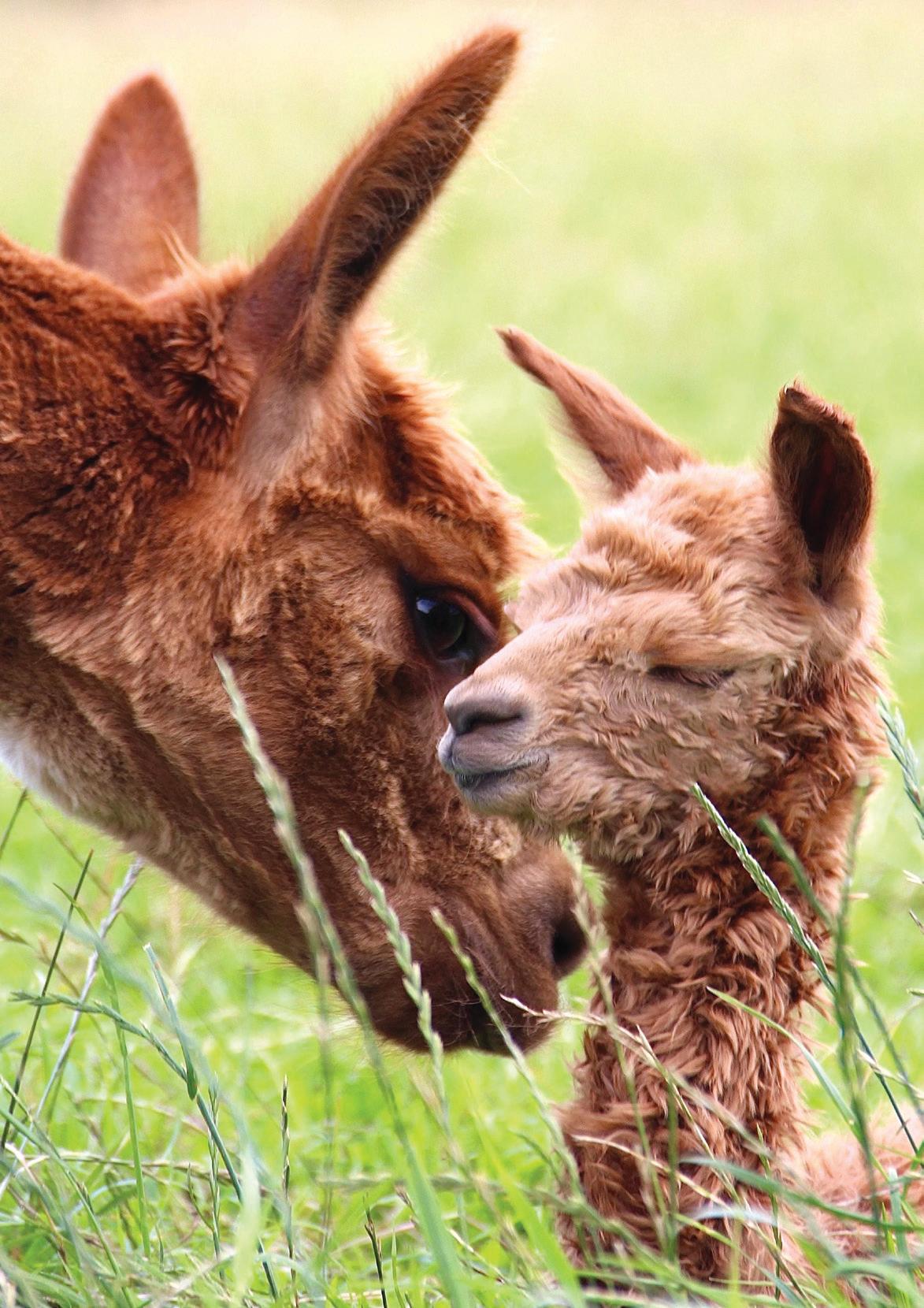
Module 8: Birthing
Module 1: Basic management

The British Alpaca Society gives access to a variety of courses for members from basic husbandry to advanced fibre recognition.
Courses offered by BAS Affiliate Trainers are from the set of nine approved by the Society:
• Module 1: Feeding and basic management
• Module 2: Vaccination, Supplements, Illness and Ailments
• Module 3: Handling Alpacas
3a) Herding and catching
3b) Fitting a head collar
3c) Basic Halter Training
• Module 4: The Alpaca – What to look for
• Module 5: Understanding shearing day
• Module 6: Fleece – what to do with it
• Module 7: Breeding and mating
• Module 8: Birthing
• Module 9: Marketing your alpaca business
*(This course was revised and updated in October 2022 and was formerly 11 modules. The content remains the same)

There are affiliates all over the country to find someone near you check out the website or look at the fortnightly newsletter.
Please apply directly to the affiliate concerned.
Want to consolidate your knowledge or need a spring board to go further? This is a fabulous course that not only gives you so much information, it also signposts you to go further.
A one day course on alpaca conformation and fibre covering:
• Basic conformation including teeth, stature, genitalia, legs, gait and body scoring;
• Fleece – how to recognise the different qualities and traits of fibre including weight and value, fineness, density, crimp, uniformity, length, colour, amplitude and frequency and an introduction to histograms. You will have the opportunity to assess fleeces and discuss the merits of different qualities and styles.
Course notes will be provided including a glossary of terms.
There will be a maximum of 12 people on the day.
Cost: BAS Members £ 65 + VAT Non Members £85 + VAT
This course will only run if there is a minimum of eight people.
Regional groups are encouraged to arrange for this course to be held locally for the benefit of their members so look out for details on their websites or email or call BAS for more information.
Following on from this course there are two more available.
A three-day, in-person course on alpaca conformation and fleece for Huacaya and Suri – a thorough overview of the major fleece and conformational traits for both Suri and Huacaya alpacas. This enables delegates to:
• Gain confidence to assess and verbally deliver fibre and conformational characteristics to other owners and potential customers.
• Make informed selection decisions within their own herd, at shows and when buying stock in.
• Gain the necessary information to make appropriate breeding choices.
• Gain valuable experience at handling and assessing a high number of alpacas of varying quality, sex, and type.
Suitable for all members and overseas guests who are interested in learning more about assessing both conformational and fibre traits. This course is a comprehensive package in furthering alpaca assessment and applicable to all.
>> Continued on next page

Colin Ottery: The Alpaca Shearer Alpaca Shearing since 2005



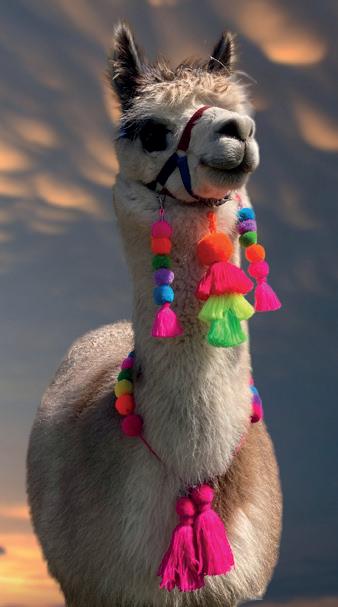
&

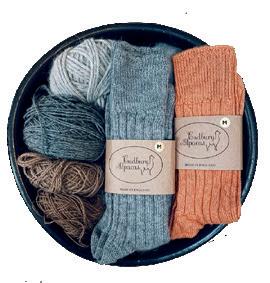
Please contact me for a friendly and professional service with competitive rates
Telephone Colin Ottery for a friendly and professional service with competitive rates. 01884 38782 07773 440354
All size herds considered 07746 957110 or 07773 440354
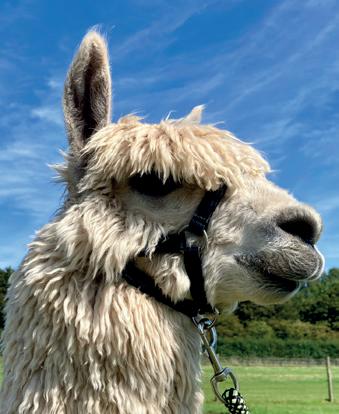
Our quality alpaca supplies include leather and nylon halters, padded lead ropes, waterproof alpaca coats, cria coats & base layers, mineral drenches and alpaca trekking accessories. We offer BAS affiliated husbandry courses and have pedigree alpacas available with full after sales support.
Email: alpaca2shear@yahoo.co.uk
Email: alpaca2shear@gmail.com www.alpaca2shear.com
Cadbury Alpacas � www.alpacaemporium.co.uk ���� 0800 020 9117
Alpaca & Llama handler training with...


Is your relationship with your animals all you had hoped for?
How can Camelidynamics techniques help me on my alpaca journey?
Camelidynamics is an approach to and collection of methods that represent the most positive, least intrusive techniques for training and managing alpacas.
This two day handling course will change the relationship you have with your animals forever.
Understand why camelids behave the way they do and learn kind and efficient methods that are science-based, for safe handling and husbandry that’s fun.
Tell your vet that we have courses for them too.
For those interested in finding out how this approach can inform and support your human/alpaca interactions in the therapeutic arena, we are now offering courses for owners and professionals.
Working with Alpacas in Animal Assisted Activity or Therapy.
HANDLER COURSES: 15-16th March – 26th-27th April 30th-31st August
ANIMAL ASSISTED ACTIVITY COURSES: 19th-21st June – 22nd-24th September
ANIMAL ASSISTED THERAPY COURSE: 19th-22nd June – 22nd-25th September


For more details and to book your places go to





A two-day course on alpaca conformation and fleece for Huacaya and Suri that builds on the Intermediate Course. Suitable for alpaca owners that want to develop their skills in breeding and those who may wish to become judges.
Content will be mainly practical and will be approximately one-third classroom, two-thirds hands-on practical. It will cover both Suri and Huacaya.
This course is part of the judge training programme but does not include formal oral reasoning. The course includes:
• A full and thorough overview of conformational traits and the way they impact on reproduction, growth and general fecundity.
• Advanced visual and hands on assessment techniques for alpaca selection for sale, purchase, showing and breeding.
• The ability to learn to orally compare and critique alpacas, in particular herd sires.
• An opportunity to exchange ideas and techniques with other likeminded breeders.
It is a fun couple of days fully immersed in the latest and most in depth alpaca assessment and breeding techniques.
Review of Basic Alpaca Assessment:
• Conformation positive and negative traits – more detail on limb angulation, dentition, testicles, and other issues
• Fibre – review
– Understanding follicular development
– Cell structure
– Primary and secondary follicles,
– Detailed examination of fleece qualities – density, fineness, character/ lock, micron
– Understanding fleece testing and histogram
– Relationship between characteristics
– Hands on alpacas – fleece
– Hands on alpacas – conformation
– Micron assessment
• Advanced fibre/fleece assessment
• Selecting a stud and heritability
• Multiple generations of progeny
A Practice Assessment includes:
• Looking for positive and negative traits passed down from the female or male and providing an explanation
• A group of alpacas to assess and put in order of preference and provide a reason why.
Tutors will provide written feedback to each delegate. There is no pass or fail.
After completing the Advanced Alpaca Assessment the Judge Training Stage 1 can be attended.
Delegates must have attended the Advanced Alpaca Assessment course before starting this training.
Judge Training Stage 1 is a two-day course on the skills needed to be an effective alpaca judge. There is an exam for each element of training which must be passed to proceed to Judge Training Stage 2.
In advance of the course, participants are recommended to:
• have read the latest version of the BAS Show Rules and Fleece Manual
• helped at halter and fleece shows.
This course focuses in its entirety on the training of individuals to assess alpacas (Suri and Huacaya) using the comparative method for halter and the absolute method for fleece. This course will be primarily of a practical nature.
Delegates will:
• revise previous training courses
• be taught show ring procedure
• discuss ethics of judging
• be taught a system for delivering oral reasons
• practice judging of the shorn fleece using the BAS fleece manual
• practice judging halter classes of 4
• be tested on each element.


This is a two-day course on the skills needed to be an effective alpaca judge. There is an exam for each element of training which must be passed to proceed to Judge Apprenticeships.
Delegates must have attended and passed Judge Training Stage 1.
In advance of the course, participants are recommended to:
• have read the latest version of the BAS Show Rules and Fleece Manual
• helped at halter and fleece shows
This is a largely practical course with emphasis being placed on:
• Accuracy and consistency of class placements
• Oral reasoning, accuracy and the ability to justify placing and use of correct and varied terminology
• Improving speed whilst maintaining accuracy
• Fleece judging, accuracy
• Manner and handling of alpacas
• Detailed knowledge of BAS Rules
• Show ring management
• Judges’ presentation, presence, and etiquette. Course content:
• Review of judging criteria and oral reasons:
– Fibre and Conformation
– Description of fleece samples
– Any recent changes to criteria and rules
• Hands-on review in barn
• Judging halter classes of up to six alpacas including giving oral reasons
– Huacaya and Suri
• Judging classes of six fleeces
• Video feedback.
Course notes will be provided including a glossary of terms and copies of the show rules and fleece judging manual.
There will be a maximum of eight people on the day. Ideally this course will only run if there is a minimum of four people (at BAS Board discretion). Delegates must have completed and passed the Judge Training Stage 1.
Exercise to develop oral reasoning: Produce written oral reasoning for 50 classes of alpacas (25 Huacaya and 25 Suri). This is practice and is not examined.
Judge apprenticeships: Following successful completion of Alpaca Judge Stage 2, candidates must apprentice with three different BAS qualified judges at three halter and two fleece BAS shows in the UK. One of the halter shows must have more than 100 entries present. An apprentice day must have a minimum of 60 alpacas judged to be considered a full day. On receipt of satisfactory reports, they may proceed to Certification.
BAS announced a pilot scheme last year to train more shearers. Working with Colin Ottery as the course lead tutor the aim is to recruit and train people who already have some shearing experience with alpacas, sheep or goats. The course will cover alpaca techniques, the equipment needed and how to make the most of the alpaca fibre.
Colin said: "Understanding how the quality of shear affects the value of the fleece is very important. You need to see the whole picture."
There are a limited number of places so if you are interested please email or call Duncan Pullar, BAS CEO to get your name on the list. Call 03453 192468 or email ceo@bas-uk.com


fast acting formula anti-bacterial, anti-viral & anti-fungal
quickly relieves, soothes & calms; cuts, grazes & post surgical sites
weepy eyes foot rot fly strike sores irritation caused by mites safe to use on pregnant animals & their young no damaging chemicals or dyes to fleece
passed for use in organic lifestocks systems
100% safe on all skin types
Reccommended & used by veterinarians. Available in all good indepentant pet stores, major petcare chains, trusted healthcare providers & online


info@leucillin co uk www.leucillin.co.uk 0345 548 9800

In the UK population it is expected breeders will want to continually improve all the traits. This BAS breed standard has been developed to encourage the objective assessment of the form and function of alpacas in the UK. It is intended as a guide for breeders to help promote the pursuit of alpacas exhibiting high quality fleece traits on a correct frame.

ABAS working group, led by Ken Freivokh, took on the task of developing a BAS Breed Standard. BAS are delighted to present the product of these labours below. Thank you to everyone who contributed.
The process of discussion and consultation with members was designed to try and involve as many people with an opinion and interest as possible. One of the guiding principles employed in the development was to keep the standard simple enough to be useable and relevant to as many BAS members as possible. The temptation to be too detailed was, hopefully, avoided.
The ideal alpaca should be fit for function and embody the best conformational and fleece traits of the breed. Simply put, an ideal alpaca is one that produces high quality fibre over a long, healthy, and
Phenotype
Side Profile
Head
Forequarters
Hindquarters and Tail
Genitalia & reproduction
Height
Movement and Tracking
productive life.
The breed standard describes traits as ‘ideal’ and ‘negative/ undesirable traits’, most alpacas will fall somewhere between the two on the continuum of the different characteristics. The “ideal” element of the breed standard promotes the goal of reaching the ideal through selective breeding, resulting in genetic gain and improvement in phenotype.
The traits are not listed in any particular order. In the UK population it is expected breeders will want to continually improve all the traits. Thoughts about what represents the ideal can, and do, change as new knowledge is acquired and this standard is not intended to be a static document, but to evolve alongside alpaca breeding in the UK and reflect the thinking of the time.
• Alpacas should have a balanced, proportioned frame, free moving, with a strong substance of bone and an alert stance
• The head should be carried high
• Squared-off appearance, neck and legs should be the same length and 2/3 length of the body
• Topline (back) straight and level rounding off at the croup to tail creating a slightly sloping rump
• Dense top knot (Huacaya)
• Dense top knot with well-defined locks (Suri)
• Wide and deep, wedge-shaped muzzle
• The eyes should be clear, bright, and set well apart
• The nose should exhibit two well-defined symmetrical nostrils
• The upper lip is divided and mobile
• The incisors should meet the front edge of the upper dental pad
• The ears are of medium length, erect and spear-shaped
• Chest should be broad and deep, well sprung ribs
• The withers well fleshed, set well into the shoulders forming a straight line with the back
• Forelegs should be strong and straight
• Pasterns should be firm and upright
• Feet should be neat and well-formed and bear two forward pointing toes
• The sole of the foot should be covered with a callused membrane
• Rump broad
• Well-spaced pin bones
• Tail should be straight and long enough to cover the genitalia
• Thighs should be well-muscled
• Hind legs should be straight from hip to the centre of the foot and parallel when viewed from behind and the correct angulation when viewed from the side
• Pasterns should be firm and upright
• Feet should be neat and well-formed and bear two forward pointing toes
• The sole of the foot should be covered with a callused membrane
• A female’s udder should show good capacity, with four uniformly positioned teats
• Females should have a normal size functioning vulva
• Males should have external genitalia correct in size, shape, and position, with two evenly sized, firm testicles descended into scrotal sacs of appropriate size for age
• A mature alpaca should measure no less than 32”/81 cm at the withers
• Alpacas should move soundly and exhibit an even stride length with two distinct tracks, the hind feet following the front ones
• Alpacas should have a fluid movement
NEGATIVE/UNDESIRABLE TRAITS
• Obvious lack of balance
• Light substance of bone
• Narrow head
• Obvious incorrect proportions
• Low neck set
• High tail set with tail straight from spine
• Swayback or humpback
• Curvature in spine, neck and/or tail
• Open, thin topknot
• Very narrow head, shallow muzzle
• Eyes with cloudy appearance, pale blue eyes
• Excessive fleece on the bridge of the muzzle beyond the age of three years
• Asymmetric nostrils
• Incisors excessively under or overshot
• Ears excessively out of proportion to head, banana shaped, fused or gofer
• Wry face
• Very narrow chest
• Loose shoulder blades
• Severely base narrow or base wide
• Buck knees, calf knees, severe knock knees
• Very prominent withers
• Weak, dropped or camped over pasterns
• Polydactylism
• Syndactylism
• Severe cow hocks
• Obvious sickle hocks
• Severe post legged
• Luxating patella
• Very narrow hindquarters
• Severely base narrow or base wide
• Weak, dropped or camped over pasterns
• Bent or kinked tail
• Steeply sloping rump
• Squared-off rump
• Tail absent or abnormally short
• Polydactylism
• Syndactylism
• Less or more than four teats on males or females
• Fused teats
• Testicles that are too small or of uneven size or undescended into scrotal sac
• Fused vulva
• Obviously undersized or oversized for age
• Paddling on the front feet
• Rope walking
• Obvious uneven stride and/or length of stride
HUACAYA
Uniformity of Micron
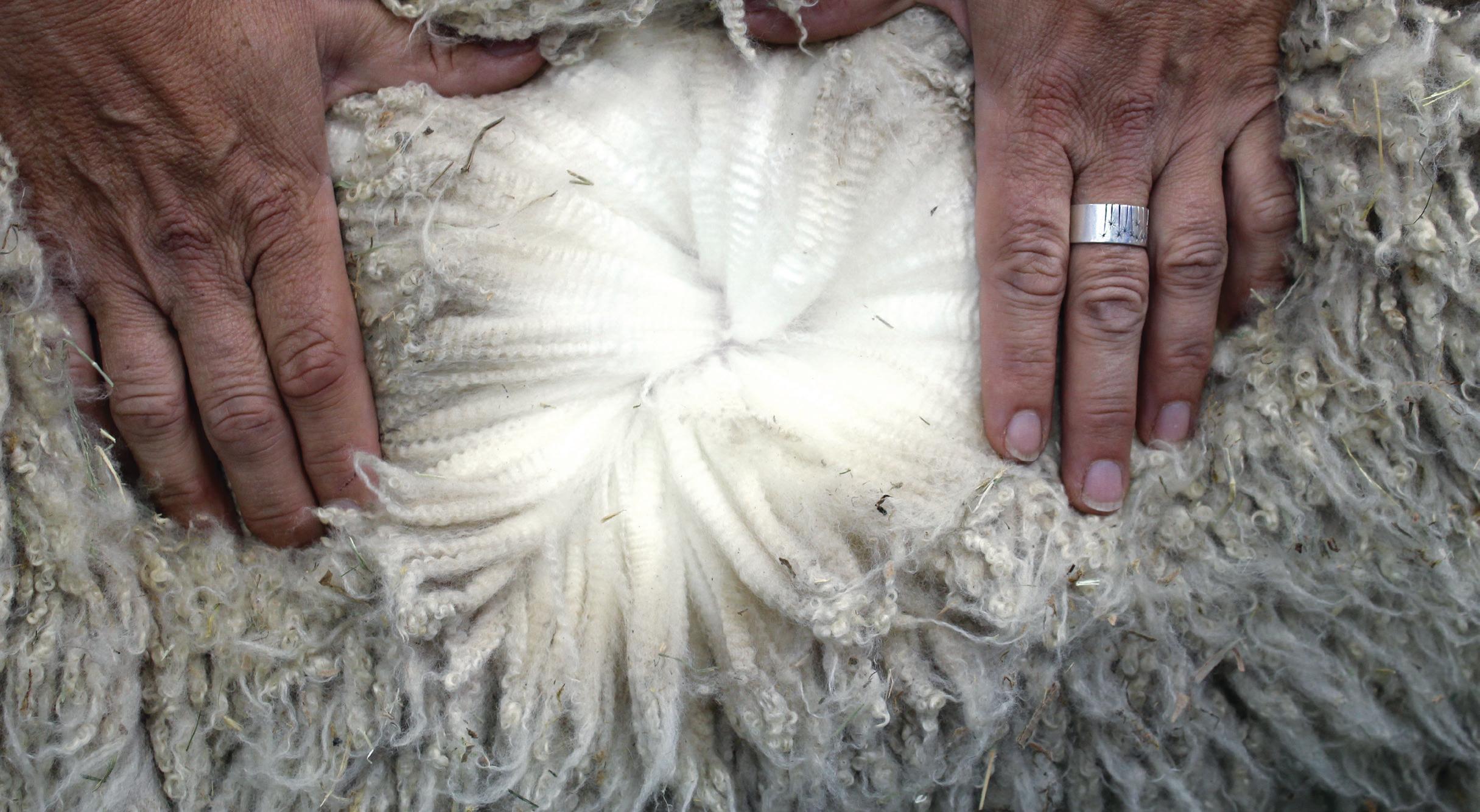
Fineness and Handle
Density
Character
Brightness
Uniformity of Colour
Staple Length
Guard Hair
• Uniformity of fibre diameter (micron) within the staple and across the body resulting in a low standard deviation measurement (SD)
• Minimal difference in micron between primary and secondary fibres
• Low micron not only in mid-side sample but across the animal into extremities
• Low transition line
• Soft and silky handling fleece
• Uniform, well aligned fibres both within the staple and across the body
• High ratio of secondary to primary fibres
• Highly aligned fibres with crimp definition
• Very well-defined staples which break into micro staples
• High degree of brightness displaying across the fleece which enhances handle
• Uniformity of colour in staple and throughout the fleece (on solid-coloured alpacas)
• Producing a staple length each year that is suitable for processing and is uniform in length across the body
• Low levels of guard hair across the body

NEGATIVE/UNDESIRABLE TRAITS
• High degree of variance in micron between primary and secondary fibres both within the staple and/or across the body (high SD)
• High levels of coarse fibres
• High degree of variability in the fibre diameter
• Harsh handle (prickle factor)
• Lacks density - open fleece
• Lacks any crimp definition or organisation
• Very dull
• Chalky look and feel
• Strong variance in colour within the staple, in patches or spots (multi-coloured alpacas and the white tuxedo pattern in traditional greys not included)
• Strongly differing colour in primary fibres compared to secondary fibres
• A length not suitable for processing
• Variable in length across the body
• High levels of guard hair (stronger straighter fibres) in main blanket area
Cervical vertebrae (neck)

Maxilla (lower jaw)
Mandible (lower jaw)
Scapula (shoulder blade)
Shoulder
Humenus
Carpus
Lustre
Uniformity of Micron
Fineness and Handle
Density
Lock Structure
Guard Hair
Uniformity of Colour
• High degree of lustre
• Uniformity of fibre diameter (micron) within the lock and across the body, resulting in a low standard deviation measurement (SD)
• Minimal difference in micron between primary and secondary fibres
• Low micron not only in mid-side sample but across the animal into extremities
• Low transition line
• Silky and cool handling fleece
• Uniform, well aligned fibres both within the lock and across the body
• High ratio of secondary to primary fibres
• Lock can be wave & twist, tight twist, corkscrew, or straight but should be highly aligned and start close the skin, layering and carrying solidity to the lock
• Individual locks breaking down into micro locks
• Low levels of guard hair across the body
• Uniformity of colour in lock and throughout the fleece (on solid-coloured alpacas)
Lock Length
• Producing a lock length each year that is suitable for processing and is uniform in length across the body
Balance Neck should be same length as legs and two thirds the length of the back
Base Narrow Legs set close together
Base Wide Legs set too wide apart
Blanket Prime fleece from shoulder to mid-section to rump, both sides
Buck Knees Knees bowed forward (viewed from the side)
Calf Knees Knees bowed backward (viewed from the side)
Camped over Bowed out at the fetlock (viewed from the side)
Character The demonstration of the crimp throughout length of staple
Consistency The uniformity of the micron, crimp, character, and density within the lock and throughout the fleece
Coverage The distribution of continuously growing fibre across the whole body of the alpaca
Cow Hocks Rear legs turned inwards at the hock (viewed from behind)
Crimp The natural wave or curl of individual fibres, grown into the fibre from the follicle
Density The number of fibres measured per square unit area
Dropped Pasterns Too much angulation at the fetlock (viewed from the side)
Fineness The diameter of fibres measured in microns
Fleece The fibre from a single live alpaca, in its natural state
Fused Ears Ears look normal from the outside, however, the inside of the ear’s cartilage is fused together
Fused Teats Front, back or both quarters teats are attached to each other
Gopher ears Very short stubby ears
Guard hair Coarse, modulated (hollow or partially hollow) primary fibre, usually greater than 30 microns in diameter and straight
Handle A tactile feel of the fleece to the hand – soft, harsh, etc.
NEGATIVE/UNDESIRABLE TRAITS
• Severely lacks lustre
• Extremely chalky, dull, or flat
• High degree of variance in micron between primary and secondary fibres both within the staple and/or across the body (high SD)
• High levels of coarse fibres
• High degree of variability in the fibre diameter
• Harsh handle (prickle factor)
• Lacks density - open fleece
• Lacks any lock structure or solidity to the lock
• Lofty
• High levels of guard hair (stronger straighter fibres) in main blanket area
• Strong variance in colour within the lock, in patches or spots (multi-coloured alpacas and the white tuxedo pattern in traditional greys not included)
• Strongly differing colour in primary fibre compared to secondary fibres
• A length not suitable for processing
• Short annual fleece growth
• Variable in length across the body
Humpback The backline is convex
Knock Knees Knees bending inward (towards each other – viewed from the front)
Lock A group of fibres of similar character, usually when referring to Suri
Lustre The amount of light reflected by the fibre. The sheen or gloss. Can vary with lighting
Luxating Patella Loose patella (kneecap)
Mid-side An area midway between the front and rear legs on the side of an alpaca and approximately 6-8 inches down from the backbone
Organisation How the fibre lays within the lock/staples that make up the overall appearance of the fleece
Phenotype The alpaca’s appearance
Polydactylism More than two toes on a foot
Post Legged Rear Legs straight – no angulation from hock to fetlock (viewed from the side)
Rope Walking Front and back feet are walking on the same centre line, or crossing over the centre line
Sickle Hock Too much angulation at the hock (viewed from the side)
Staple The group of fibres or lock
Staple length The length of the staple from skin to tip
Strong Thick, coarser fibre having a higher micron measurement
Style A cumulative and overall aesthetic effect of fibre characteristics found in a fleece
Substance of Bone Circumference of bone
Swayback The backline is concave
Syndactylism Fusion of two toes on the same foot
Uniformity The even distribution of characteristics within a fleece – micron, crimp, length of staple, colour, fineness
Withers Area at the base of the neck along the first part of backline
Our Outstanding World Class Genetics shine through in the sheer quality of our Champion breeding lines

Recipe for our ideal alpaca:
1. Source the best genetics available
2. Meticulously record absolutely everything for each individual
3. Stir in the magic: the ability to put all this knowledge into practice
4. Add the zest of new bloodlines from time to time
5. Repeat each year
Studs and breeding females ~ Huacayas and Suris from champion bloodlines available for sale
Stud services offered from a great selection of established and promising young Studs

contact Mary-Jo: 0771 875 0303 www.bozedown-alpacas.co.uk




At the heart of the UK’s smallholding and rare breeds farming sector, efficiency and versatility are paramount. Enter the MultiOne 5.3K compact loader, an all-in-one powerhouse designed to tackle the diverse challenges faced by smallholders, landowners and farmers of rare breeds.
Boasting a telescopic boom, the MultiOne 5.3K can lift loads of up to 1,030kg when equipped with pallet forks or other lifting attachments. This capability is essential for farmers managing heavy materials, moving feed bales or lifting equipment. But the 5.3K isn't just about power; it's about precision too. With its centre pivot steer design and innovative switchable traction control, farmers can navigate delicate ground – like manicured lawns – without leaving a trace, while still having the confidence to traverse slippery fields when conditions get tough.
Powered by a robust Kubota diesel engine, the MultiOne's high-torque performance ensures it can handle the rigorous demands of farm life. The machine features high-flow auxiliary hydraulics delivering up to 50l/min, enabling it to power an impressive array of attachments. Farmers can choose from approximately 170 versatile options – from flail mowers and hedge cutters to trenchers and augers – tailoring


the machine to their specific tasks, whether it's mucking out stables, pushing up muck heaps, or maintaining paddocks and riding arenas.
The MultiOne 5.3K stands out as a vital tool for the modern small farmer, harmonizing power with agility. Its compact size means it can seamlessly navigate tighter spaces, enhancing operational efficiency on smaller farms. As the UK's smallholding community continues to embrace innovation in agriculture, the MultiOne 5.3K is a testament to how multifunctional machinery can elevate productivity while safeguarding the fragile ecosystems associated with rare breeds and sustainable farming practices.
In a world where labour and time is stretched to the limit, the MultiOne 5.3K is more than just a loader; it’s a partner in supporting the future of small-scale agriculture.
The MultiOne 5.3K is just one model in a wide range on offer, for more details visit: www.multione.co.uk or call the Compact Loaders UK team on 0800 233 5490


Identifying eye problems is a key part of owning any animal, as they can rapidly progress. Even with correct treatment however, not all eye infections are curable explains Lucy Giles BVMS(Hons) PGCert(VetEd) MRCVS

At the start of July 2024, Van Gogh presented with blepharospasm (squinting, often associated with pain) and watery fluid coming out of his right eye. It was suspected that foreign material had poked his eye, and following removal of lose corneal tissue, a deep ulcer was identified. Treatment with both antibiotic and healing lubrication drops was initiated, alongside pain relief.
Despite the treatment Van Gogh’s condition deteriorated. The ulcer was so deep into the eye, that internal matter from the eyeball itself was beginning to prolapse through the thin tissue. This complication and diagnosis were definitively reached with the help and support of Applejack Alpacas, to whom we are grateful! Unfortunately, Van Gogh’s eye was close to rupturing, leaving us no choice but to remove the eye itself (a procedure known as ‘enucleation’). This procedure is the only way to prevent the continual pain of deep ulceration and eventual rupture and is never undertaken if there is any hope of saving a patient’s sight. Therefore, two weeks after the first presentation, the decision was made to place Van Gogh under general anaesthetic. The same type of anaesthetic was undertaken as when we castrate Alpacas, except Van Gogh was brought into the surgery, and the procedure done in his trailer, rather than in a stall or outside. Van Gogh is a calm, well-handled boy, who seemed to trust that we were there to help him, very quickly!
Unlike during a routine procedure, we placed an IV cannular rather than giving all his anaesthetic medications into the muscle. This allowed us to easily control how deeply asleep he was using top ups, ensuring the procedure was as safe as it could be. After cushing, Van Gogh was laid

on his left side so his (painful, ulcerated and sightless!) right eye could be surgically removed.
Charlotte Bain (MRCVS) induced, controlled and monitored the anaesthetic, whilst Lucy Giles (MRCVS) performed the surgery. The greatest risk of many procedures in camelids is the anaesthetic itself, and so Van Gogh was monitored closely throughout. A specialised nerve block, as well as local anaesthetic placed behind the eye, reduced the stimulus experienced during the procedure and pain afterwards. This further stabilised Van Gogh’s anaesthetic.
For enucleations, our biggest worry is always the chance of uncontrollable bleeding, as the eye has a large blood supply via the optic stalk, which can be impossible to tie off, given how snuggly the eye socket cups the eye itself. In this case, within five minutes of starting surgery the eye itself ruptured. This complicated the removal, but was also further evidence of how fragile and damaged this eye was due to the ulceration and infection. Happily however, the procedure took under one hour, with no more complications. Van Gogh was anesthetised for slightly longer than that due to prep and post-treatments, but he recovered well and steadily in his trailer. With some gentle physical support and restraint, he was able to be driven home within an hour of recovery.
Unfortunately, after these removals, there is always a great deal of periorbital swelling, and poor Van Gogh looked as though he had been in a fight for a few weeks! However, due to the excellent aftercare and isolation management of Applejack Alpacas, he recovered well. Alpacas are incredibly adaptable, and he has settled into life with only one eye extremely well – just showing how resilient these animals can be!

• Any camelid seen squinting should be brought in to be checked as quickly as is practical
• If you have any doubts, ring the vet!
– We have special stains that can identify early corneal ulceration
• Prompt treatment of eye issues maximises your chances of ‘getting the eye right again’
• Surgery (enucleation) is an available and ethical option, if appropriate.

op Van Gogh’s right eye following lose tissue removal. Yellow fluorescein stain highlights the corneal ulcer

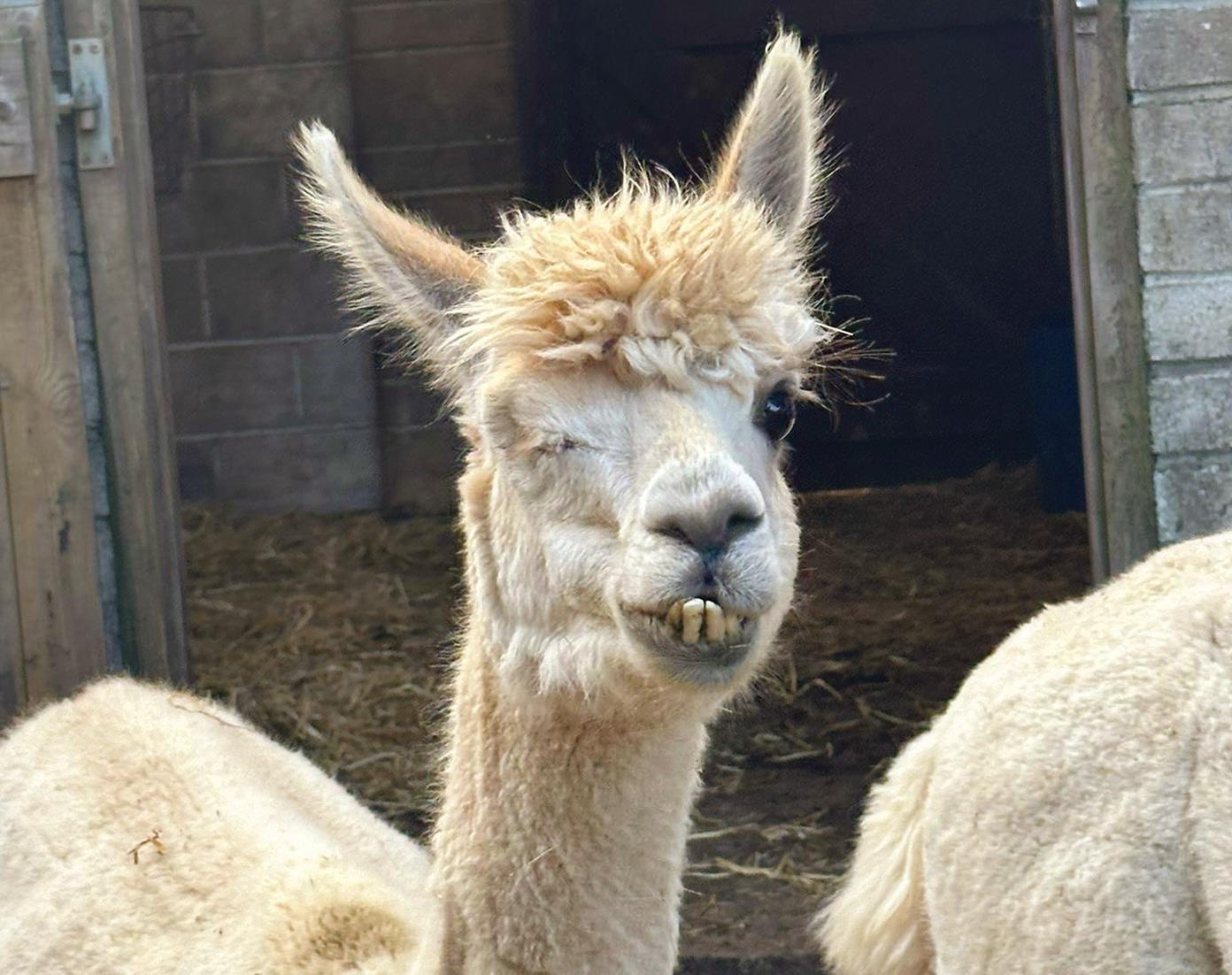
Castle Vets Farm team cover premises an hour in every direction from Launceston, Cornwall. Vets Sarah Caldwell (who runs the camelid consultancy company –HumanVet Ltd) and Charlotte Bain have undergone extensive additional training in caring for camelids, and help support the rest of their 13 vet team to ensure the best possible care for your animals.

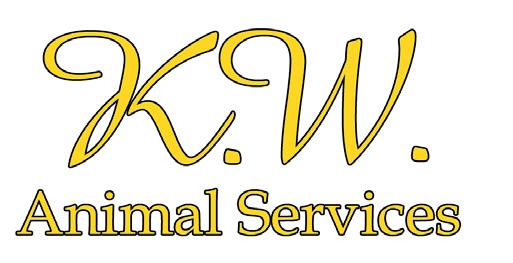




Dr Ami Sawran BVSc CertAVP (CP) PGCertVPS PhD PhD FRCVS
looks at how this affects the alpaca world.

Ami graduated from Liverpool in 2011 and went on to undertake a production animal internship and complete a PhD in dairy cattle lameness at the Royal Veterinary College. Working in farm practice ever since, she has found her niche catering to the health and welfare of camelids. Ami is clinical director of Westpoint Farm Vets in Chelmsford and sits on the VetPartners Clinical and Farm Executive boards. She completed her Certificate in Advanced Camelid Practice and Postgraduate Certificate at Liverpool, and runs the Camelid Clinical Interest Group at VetPartners, aiming to deliver relatable CPD and resources to help farm practitioners cater to camelid needs.
This year, the emergence of Bluetongue Virus (BTV3) has adversely affected many keepers of susceptible species (cattle, sheep, goats and camelids) – not least through the stress and concern over whether animals may become infected. Wider impacts of this disease incursion have included lost commercial opportunities due to movement restrictions and limited export opportunities. This has a potential knock-on effect of leaving some UK farms overstocked, with limited opportunities to move animals to new homes, both here and abroad.
With any notifiable disease (that is, one that if suspected must, by law, be reported to the Animal and Plant Health Agency) there can be much confusion with different bodies involved in the reporting, testing and communication of results to farmers.
Many of the clinical signs associated with BTV3 are also noted in diseases like Foot and Mouth, arguably with more dire consequences to our livestock and industry – this is why continued reporting remains necessary, even in the high-risk areas.
Clinical signs of BTV3 include:
• Lethargy
• Crusting and erosions around the nostrils and muzzle
• Conjunctivitis and excessive tear staining
• Facial swelling
• Redness of the mouth, eyes, nose
• Reddening of the skin above the hoof and between the toes
• Nasal discharge
• Reddening and erosions on the teats
• Fever
• Milk drop
• Not eating
• Abortion, foetal deformities and stillbirths.
At the time of writing, no positive cases of BTV3 have been noted in camelids, though reports from abroad suggest that alpacas with BTV3 have suffered fatal respiratory distress.
One of the most frustrating elements of BTV3 management is the difficulty in preventing it. This is because of the way it is transmitted. Infected midges have been blown over from the continent (which is why the East Coast is at highest risk). These midges incubate virus within 4-20 days depending on the temperature. They then bite susceptible hosts, after which those host animals become infective to other midges. The culls undertaken when the disease incursion first happened were to essentially ‘stamp out’ infection reservoirs. Once the disease was thought to be actively circulating in the midge population, this was no longer the most appropriate course of action within the high-risk areas, hence the reliance on movement restrictions to slow the spread. Models suggest that without this, cases would be significantly more widespread. Many are understandably asking what they can do to protect their stock, but midge risk is very difficult to mitigate. Advice is to ensure that livestock trailers are thoroughly cleaned and treated with insecticides for any necessary movements. Treatment of individual animals is not thought to be effective in reducing midge activity – and in fact their use could prolong withdrawal periods or have negative environmental impacts. There may be merit to keeping animals away from midge breeding areas like muckheaps to reduce the bite risk.
For alpacas it is postulated it may have been more difficult for midges to penetrate the dense fibre of some animals – there are no definitive
answers as to why no camelids were affected this time, however it is worth noting that they were not part of the national surveillance scheme (only cattle were passively screened). If BTV3 were to emerge again in spring, through the birth of viraemic (infected) animals, and warmer weather promoting disease circulation in midges then we could face another resurgence much earlier in the year, and prior to shearing season.
The camelid community are rightly concerned about the welfare of animals affected by BTV3, infected animals can be supported with anti-inflammatory and fluid therapy with your vet. There are also three unauthorised vaccines permitted for use in the UK that can be prescribed. These vaccines may not prevent an animal from becoming infected but can reduce the severity of clinical signs and mortality associated with the disease. The British Veterinary Camelid Society have provided comprehensive advice for vets on the use of these vaccines. The decision to vaccinate is an entirely personal one, but vaccination will continue to be encouraged on a national level to reduce reservoirs of infection for midges to feast on. There are various stipulations of their use, including fastidious record keeping and declaring use to APHA, as well as returning any wastage to the vet practice.
At the time of writing, we are in an official vector low period (where midge activity is deemed low enough to reduce restrictions), and efforts are being made behind the scenes to outline how the alpaca calendar will be navigated through the next year in different disease scenarios, with a view to reopening export channels, and ensuring that animal gatherings may continue unhindered, if possible.
We have been fortunate to have the interests of the camelid community represented at a high level, which should help to forge a more inclusive environment for disease control strategy in the future that considers the camelid calendar and interests of alpacas and their keepers.
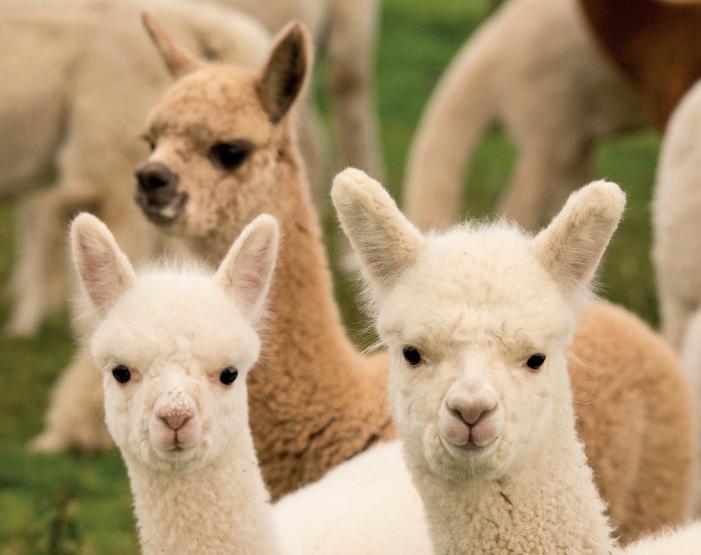

By Claire E Whitehead BVM&S MS DACVIM FHEA MRCVSRCVS

Weight loss is a common and concerning issue in alpacas, with a variety of potential causes. Addressing it effectively requires identifying the underlying problem, as the causes can range from poor nutrition to chronic disease. While diagnosing
Figure 2: Check the jawline for any swellings that could be tooth root abscesses. If you're not sure, compare with the other jaw, or another alpaca! You can do this yourself while holding quite easily
the exact issue often involves veterinary expertise, there are steps that you, as an owner, can take to get started and gather valuable information. However, do not delay in calling for assistance if the weight loss is more dramatic or concerning, or the affected alpaca is not eating!
Some of the most common causes of weight loss are straightforward to check for. Begin by evaluating the animal’s body condition (figure 1) and performing a thorough visual and physical assessment:
• Check for overgrown incisors or sharp points on the cheek teeth that could cause oral pain. Don’t put your fingers in your alpaca’s mouth because they have very sharp teeth! Instead, I suggest that you feel along the outside of the cheeks for anything that feels out of line. As animals age, sometimes the cheek teeth can become loose and end up pointing outwards. You may also be able to appreciate gaps where teeth may be missing.
• Feel along the jawline for swellings, which may indicate a tooth root abscess (figure 2). If you find this, you will need to call your vet to discuss the severity and treatment options. Radiographs are best for assessment ahead of deciding whether medical or surgical management will be best.
• Collect a fresh faecal sample to test for worms, coccidia (particularly Eimeria macusaniensis), and fluke if this is a concern in your area.
• It is usually a good idea to send a few other samples alongside the sample for the animal of concern because sometimes pre-patent burdens can bother individuals while others have high burdens but aren’t yet showing any clinical signs. Pre-patent burdens are when animals have parasites in the gut but they are at the earlier stages and not yet producing eggs or oocysts – they can still be affected though. In this way, the other animals can be sentinels, helping guide you to a diagnosis and may flag up issues that may yet affect others in the herd.
• Make sure you send your faecal samples to a lab that is familiar with alpacas and is performing the most sensitive testing methods so that things aren’t missed. Most standard tests will fail to detect larger, heavier, or more dense eggs and oocysts that can be significant in alpacas at low levels of infestation. We perform the Modified Stolls test at our lab and you can send your samples directly to us for fast efficient reporting (figure 3). The Modified Stolls test will detect these burdens, and you will be provided with a full and detailed interpretation helping you and your vet manage your herd’s health. For more details, visit www.ukalpacavet.com.
• Watch how the animal interacts at feeding time. Is he/she being pushed away by dominant herd members? Or being so dominant that he/she is unable to consume sufficient to provide for its own needs? If so, consider providing separate feeding areas to manage this.
• Assess the quality of your forage and pasture. Pregnant, lactating, or growing animals have higher requirements for protein and energy and your grass or hay might not be sufficient for their needs. Few people bother with forage testing but it is a fundamental tool to help you feed your animals effectively. It’s pretty much impossible to guess at forage quality accurately by look, smell or feel. If multiple animals are losing weight, a closer look at your nutritional provision is well worth the expense of forage testing.
• If in doubt, consider supplementing with tested, high-quality forages like chopped dried grass or alfalfa. Avoid excessive reliance on concentrates, as these can disrupt digestion if not properly balanced.

Figure 1: This alpaca is clearly skinny. Please note that fleece may disguise poor body condition so it is crucial to body condition score your alpacas regularly to detect changes in condition so that you can act appropriately
If weight loss is significant, the animal isn’t eating, or basic checks don’t reveal an obvious cause, it’s time to involve your veterinarian. A vet can perform a detailed clinical examination and advanced diagnostics, such as:
• Bloodwork: A full panel (including haematology, biochemistry, and mineral levels) can pinpoint systemic diseases, chronic inflammation, or nutritional imbalances.
• Imaging: Ultrasound can detect internal issues like abscesses, tumours, or organ enlargement. For example, thoracic ultrasonography is particularly useful for diagnosing tuberculosis in camelids showing weight loss and respiratory symptoms.
Once the underlying cause is addressed, reversing weight loss involves providing high-quality nutrition. You should ensure that the forage you’re providing is of excellent quality – check this using forage testing. There are a number of companies selling bagged chopped dried grass in the UK that has a consistent nutritional profile and this can be a reliable option to provide good quality and palatable forage to animals with special needs. However, this is an expensive way to make up for poor quality forage routinely! You can add supplements to their regular ration, but you should be cautious about adding too much in the way of concentrates (anything in a bag that isn’t a forage) as this can result in disruption of the microbial population, acidosis and ulcers if not done carefully. Any new feeds need to be introduced gradually over 7–10 days to prevent digestive upset. A good source of energy is sugar beet. Sugar beet is high in fibre so is favoured over grains such as corn, barley or wheat. This comes in different forms that always need soaking in water but the easiest way to get this is in flakes that are quick-soaking (eg “Speedi-Beet”, British Horse Feeds). Alfalfa is a great source of protein and is available as chopped alfalfa in bags or as pellets.
>> Continued on next page

Figure 3: Faecal testing is a vital tool in evaluating alpacas with weight loss. This should be on top of routine faecal testing as an integral part of your parasite control strategy
You can also find sugar beet and alfalfa blended together in a pellet (eg “Alfabeet”, from Dengie Horse Feeds). All should be available at your local feed merchant where they sell feed for horses.
Whatever you do, it is important to ensure that energy and protein are present at the same time so that they can be utilised properly and promote microbial growth in the first stomach compartment. In other words, if you increase the protein provision without ensuring that sufficient energy is present in good quality forage, there will be a mismatch. This means that both energy and protein will be wasted since the microbes cannot store either until the other is present.
You could also consider adding a probiotic to promote growth of the microbes in the first stomach compartment. The microbial population is critical for digestion of forages and imbalances result in inefficiency in the system. Don’t reach for something like live yoghurt which is great for simple-stomached creatures like humans, but contains lactobacillus that promote acidosis in the adult camelid forestomach which is bad. You
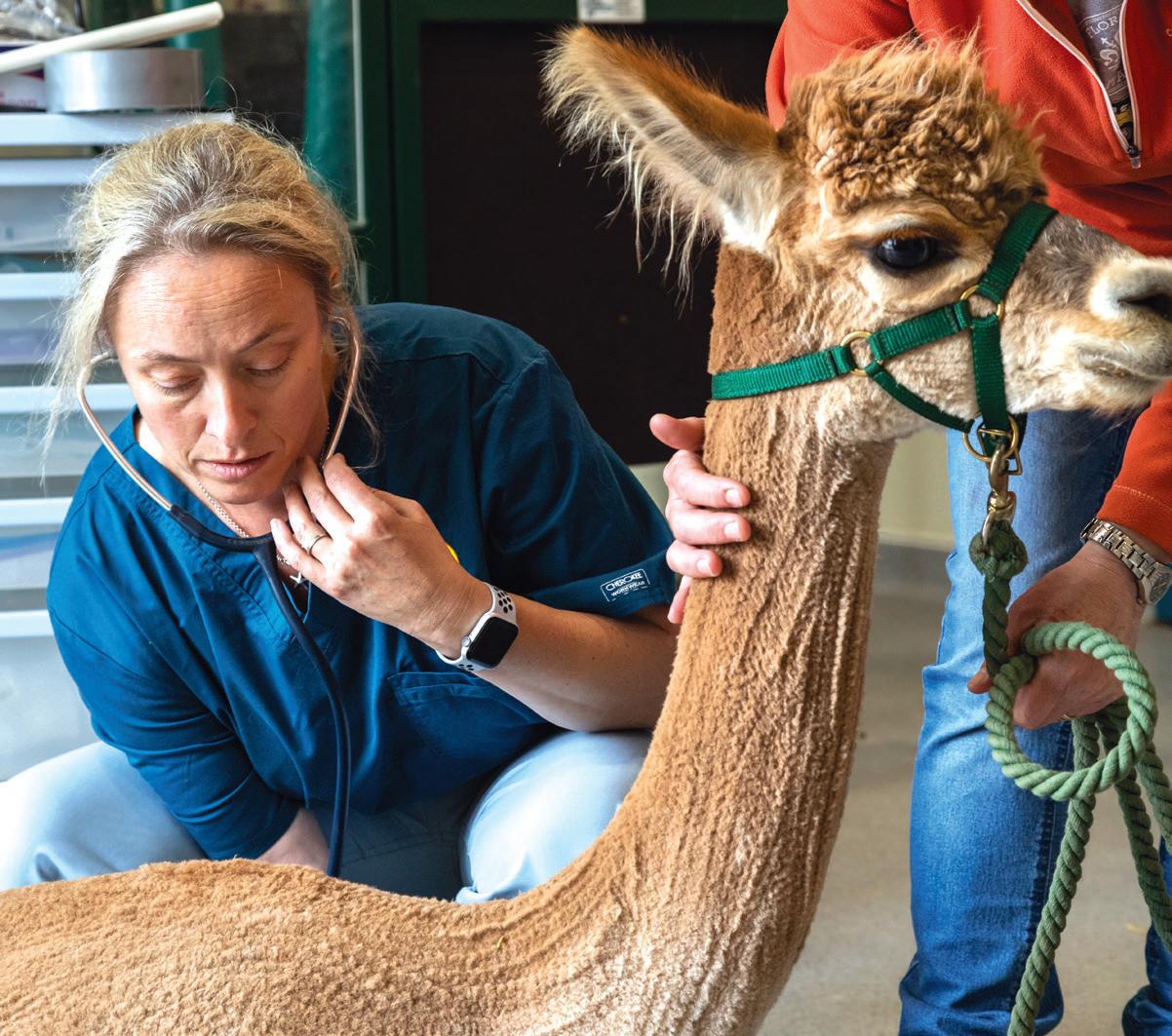
want to use a probiotic made for ruminants, usually one containing yeasts like Saccharomyces Cerevisiaes. An example probiotic is Provita Rumen Stimulant, available through our website at www.ukalpacavet.com/shop/.
Dealing with weight loss in alpacas can be daunting, but your proactive involvement in these cases is crucial. By performing simple observations and tests, you can provide your veterinarian with valuable insights that will expedite diagnosis in these cases and allow effective treatment from the outset. Remember, you're not alone—your vet is there to guide you through more complex cases. With careful management and professional support, most animals can recover and thrive once their underlying issues are addressed.
If your vet needs assistance with any alpaca cases, please consider booking a consultation with me. It’s always best if you and your vet are involved in this consultation process.
Dr Claire Whitehead has been working with camelids for 35 years, having started learning all about them on the family farm, and then choosing to specialise in them after becoming a vet in 1999. She completed a three year camelid-specific medicine residency programme in the US, the first of its kind outside South America and then returned to the UK. She set up the Camelid & Farm Animal Hospital service at the Royal Veterinary College and then set up a camelid-only referral and consultancy practice in Oxfordshire where she is happy to help anyone with the camelid care concerns, as referrals or in consultation with you and your vet! She has been teaching both owners and vets how to work with camelids since 2003, and offers a variety of on-demand training options for owners and vets. She was recognised as the first (and remains the only) RCVS Specialist in Camelid Health & Production in early 2016 and has been President of the British Veterinary Camelid Society since 2011.
Claire has contributed to veterinary texts in camelid medicine and is going to release her new book in April 2025 – The Camelid Care Handbook for Alpaca & Llama Owners.

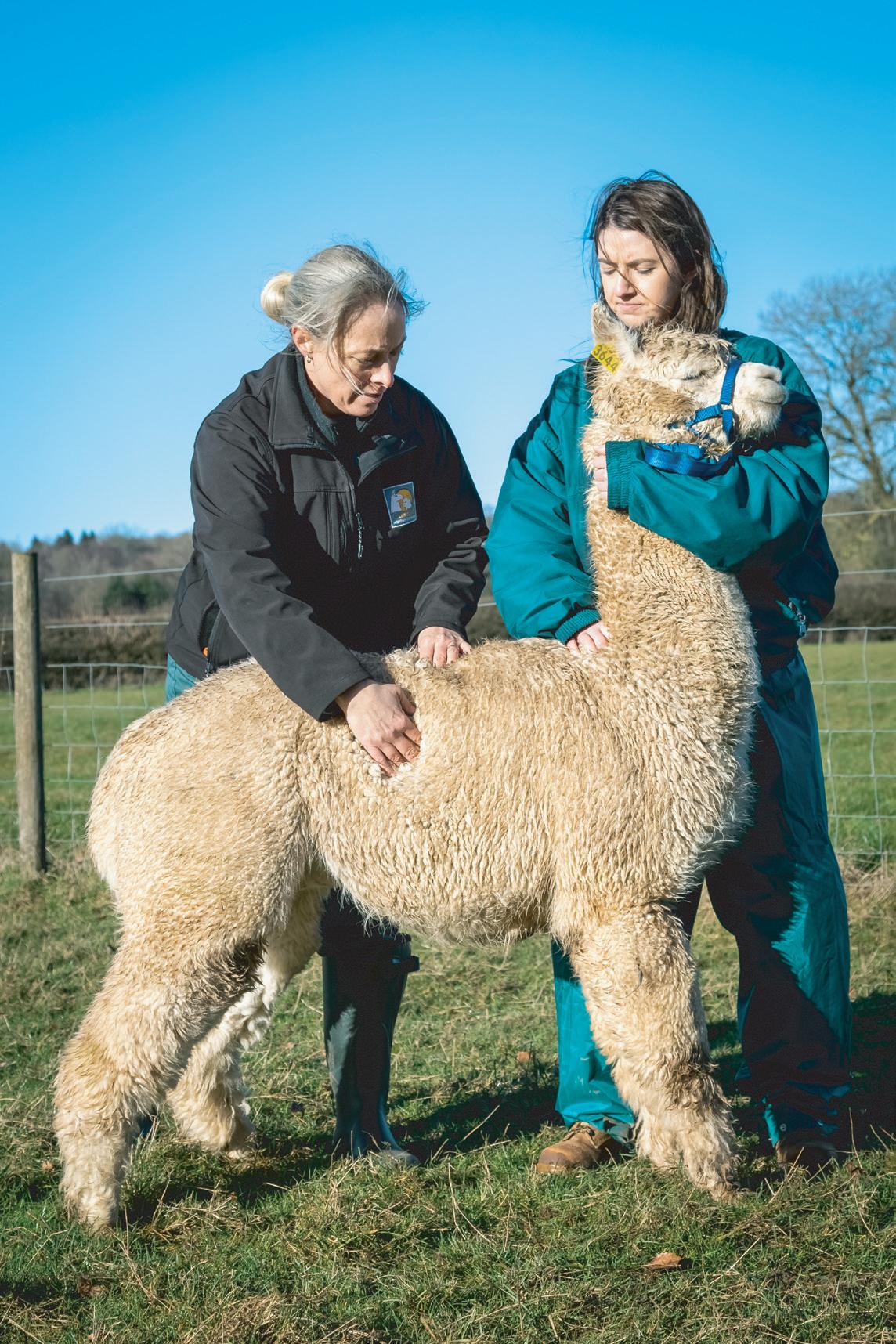
We’re passionate about camelids and share your goal to have a healthy & productive herd.
Committed to ongoing learning in the rapidly developing field of Camelid Health, Medicine, and Reproduction, we stay at the forefront to offer up-to-date care and advice. Our commitment extends to sharing our expertise, enhancing knowledge for amelid aregi


► Intensive Camelid Health Care ► Camelid Reproduction & Cria Care Intensive ► The Advanced ► Launching Soon
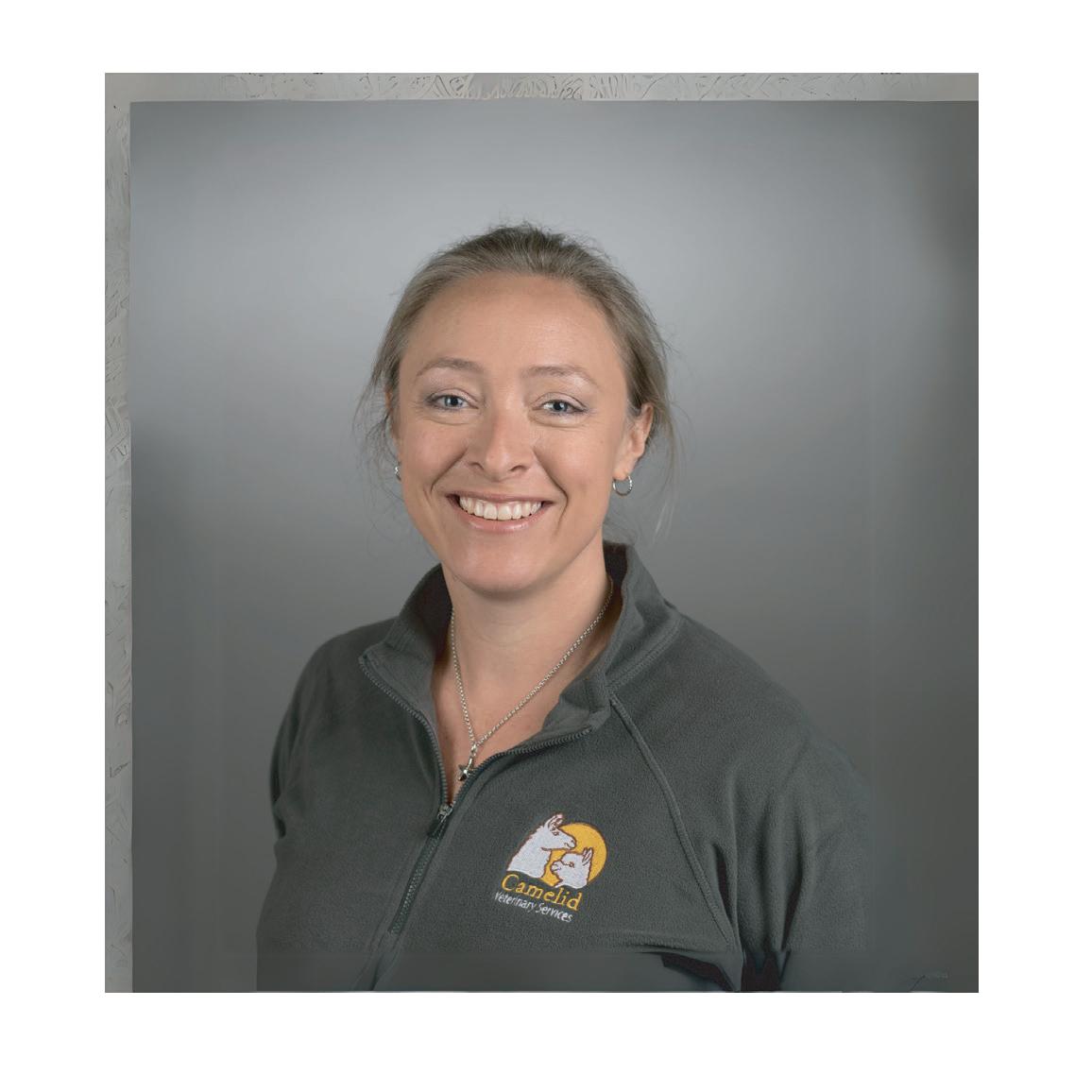

Partner with us for a thriving herd. We support and collaborate for specialised care, optimising camelid health and easing management stress.
Utilize our Camelid-Specific Lab for comprehensive testing (faecal or cria IgG).
Dedicated to enhancing camelid health and welfare, our ser vices are spearheaded by Claire E Whitehead, the only RCVS Specialist in Camelid Health & Production.

As we all know, alpaca fleece can be a magical fibre with a quality so exquisite that you cannot quite believe your animals grow this without even realising its beauty! But most of us do not have the time or money to commit to processing our own fleece and are often left wondering what we can do with the resulting product,
It’s important to understand alpaca fibre and all alpaca owners would benefit from taking one of the courses mentioned in this Yearbook. I found the basic alpaca assessment course an absolute eye opener and gave me some tools to make sensible evaluations of fleeces and to be able to understand what mills were talking about in

MAP-MARKER Vulscombe Farm, Pennymoor, Tiverton, Devon EX16 8NB Visitors welcome by appointment
PHONE 01884 243579
✉ info@ukalpaca.com
TV www.ukalpaca.com
Chas Brooke and Rachel Hebditch also run Classical MileEnd Alpacas. Featured in the Autumn 2024 issue of Alpaca magazine, this mill is unique in that it actively buys alpaca fleeces.
They prefer white and fawn as they can be dyed successfully though can buy black, grey and brown, usually at a lower price. The fleece will be graded by microns but even the ‘outsorts’ the fleeces that are too short or too coarse do have a good market for duvets for example.
Their website explains what they need when you send fleeces to them and also has a guide to skirting. They take only fleeces shorn in the current year, minimum of 88m (3.5 inches) – but see note about ‘outsorts’ above, and solid colours only.
Rachel emphasises “Shearing is often a lost opportunity to make money from your fleece. Keep the area clean, sweeping up between animals and clean even more thoroughly between colours”
Looking at their website will extend your knowledge of alpacas and the products that are available from their fleece. You will also find Rachel’s blog which is a great read.

terms of quality and usage.
The next important thing is to realise is that before you send to any mill, consider your shearing. We’ll look at that in more detail in the spring Alpaca Magazine but again, an affiliate course or your local alpaca group, can help with how to do the essential task of ‘skirting’ , and how to send a clean, well managed fleece to them so that they don’t have to charge you to do work you could do yourself.
Every mill I have ever spoken too has been enthusiastic and keen to share knowledge. That’s why we are publishing a list of mills you can help you with alpaca and it is suggested that you contact them for further information long before you shear.

MAP-MARKER 5 Bushmills Road, Portrush, Co. Antrim BT56 8JF PHONE 07802 442228
✉ phil@tworiversmill.com
✉ dani@tworiversmill.com
TV www.tworiversmill.com

Located near the North coast of Northern Ireland, with easy trading links to customers on the island of Ireland, in GB, the EU and further afield.
Visitors to the mill are very welcome by prior appointment and they are always happy to discuss and demonstrate their work.
Two Rivers Mill specialises in worsted processing of alpaca fibres, either as pure Huacaya and Suri or in blends with other fibres to suit different applications.
They work with orders from 20kg to over 100kg.
They run their machines on electricity generated 100% from renewables and they use biodegradable cones and plastic bags to deliver your yarn. Their website is full of information including pricing structure and preparation. They made the move from Dorset in 2023 and you can read more about them in the Alpaca Yearbook of that year.









MAP-MARKER Unit 3 Cheeklaw Business Park, Station Road, Duns TD11 3HS
PHONE 01361 883692
✉ hello@thebordermill.co.uk
TV www.thebordermill.co.uk
The Border Mill specialise in spinning alpaca fleece but also process wool, especially from rare breeds, and other fibre-producing animals including llamas and angora rabbits. They can process any quantity from a single fleece upwards, and also blend in a variety of special fibres or dye fleece across the entire colour spectrum for something extra-special.
The Border Mill are very busy with fleece processing orders so if you'd like them to spin your fleeces, please plan ahead and book a space as soon as you can.
For information on the fleece processing process, options and charges, tips on preparing your fleece for spinning and all sorts of other things you never knew you wanted to know, please explore the sections on the website. But if you don't find what you're looking for, they say, “please feel free to contact us by phone or email – we're very friendly and we love blethering about alpacas, sheep and all things fleecey.”
The Natural Fibre Company specialise in turning shorn fleeces into processed fibre/used for felting or hand spinning/into yarns suitable for knitting, crochet, weaving or machine knitting.
Fleece is a very versatile raw material and it is wonderfully sustainable, with great high performance properties, and can be made into a huge range of end products from baby clothes to heavy duty carpets, from sculptured felt to insulation and from household goods to high fashion items. The animals they cover include sheep, goats and alpacas.
They can advise what to do with a particular fleece type and what you can do to adjust the results by using different processes or blending. They say “ we are expert at unravelling the technical aspects of processing.” For further information check out the website.
Operating hours: 9am to 5pm Monday to Thursday, closed on Fridays.
MAP-MARKER Unit B Pipers Court, Pennygillam Way Launceston, Cornwall PL15 7PJ
PHONE 01566 777635
✉ enquiries@thenaturalfibre.co.uk
TV www.thenaturalfibre.co.uk


MAP-MARKER Brookfields Farm, Cannock Road, Shareshill, Staffordshire, WV107LZ
PHONE 07901 161308
✉ sophie@lilipopmill.com
TV www.lilipopmill.com
Lilipop Mill is a family run fibre mill located in a renovated stable in the heart of the Staffordshire countryside. They specialise in processing alpaca fibre and have an established herd of their own. This means, they say, that they have a passion for the fibre and understand it's beauty and quality.
Their aim at Lilipop Mill is simple, to create beautiful and high quality yarns and products. They also aim to offer helpful, friendly service to our
East Anglia Alpaca Mill uses bespoke and custom built machinery specifically to process alpaca. The specialised equipment enables expert spinning resulting in cost-effective processing, superior quality end products and greater return of product to the customer.
East Anglia Alpaca Mill operates with an eco-friendly ethos, mirroring that of the alpacas themselves. They have embraced numerous environmentally conscious practices including rainwater harvesting, water recycling, green packaging, bio-degradable products and e-invoicing to name but a few.
East Anglia Alpaca Mill has made conscious decisions not to dye or blend the products we create, opting instead to embrace the rainbow of natural colours of pure alpaca. These choices align with our commitment to environmental preservation and sustainability.
The fleece is marked for its journey throughout the mill
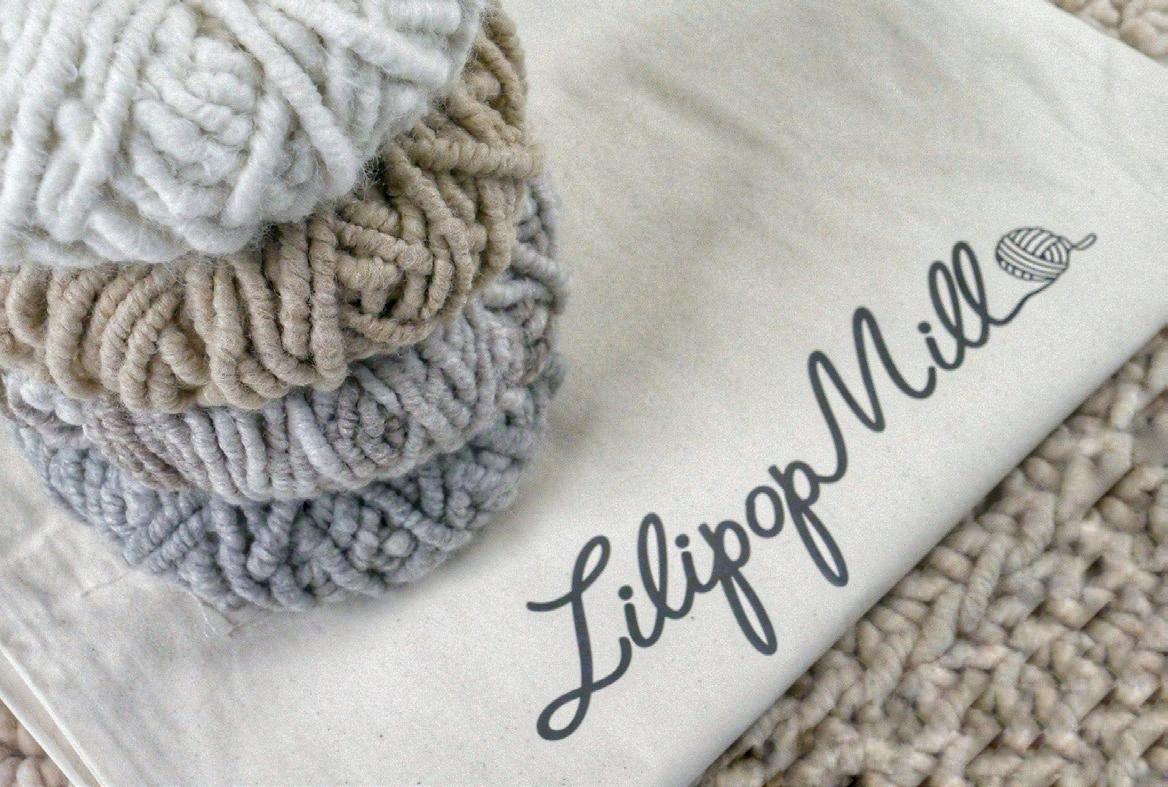
customers and create amazing products using their fleece. They were featured in the Summer issue of Alpaca Magazine in summer 2024. They offer Core Spun Chunky Knitting Yarn and Rug Yarn with cotton core plus they are able to turn your yarn into a range of finished products. The website has lots of advice on how to clean fleece amongst other ‘how to’ advice. Even if your fleece is not the best quality, they feel that it can be made into something lovely and useful and you can ring to discuss this – or call in.
MAP-MARKER The Orchards, Beighton, Norwich, Norfolk NR13 3JU PHONE 07762 439923
✉ info@alpacamill.co.uk
TV www.eastangliaalpacamill.co.uk

An interview with Emma Taylor who owns and runs East Anglia Alpaca Mill with Chris, was published in the Alpaca Magazine Spring issue 2024 and explains their processes and ethos. Emma highlights the importance of time spent planning and ensuring fleeces are properly skirted, labelled and stored that will save you money in processing and is very happy to talk clients through what they can do. She says “ We are very proud that we have an increasing number of clients who are in our below the 1% weight loss in processing from fleece to fibre!”

Hilary Monkcom reports from an event that only happens every four years.

Peru has long been on our bucket list and as enthusiastic and committed alpaca breeders, we knew that for us, there would be no better time than to ensure we visited Peru in a Fiesta year, something that happens every four years! In October 2024 that dream was finally realised.
As we landed in Lima we were greeted with alpaca merchandise of the highest quality in three large airport boutiques and by planes on the tarmac sporting huge images of alpacas on their tail fins. We were in our element!
Within three days of our arrival and acclimatisation to the high altitude, we were privileged to be sitting in the VIP seating for the Alpaca Fiesta 2024 Fashion Show in Arequipa and what a spectacle it was. The whole of Plaza de Armas Grand Square was turned into a giant Catwalk, dedicated just to alpaca and alpaca-related fashion. Backlit against the stunning Cathedral on the crisp, cool evening the stage was set.
The atmosphere was one of excitement and anticipation and it was clear that Peru was more than ready to showcase it’s finest Couture Alpaca Fashion with a host of leading designers presenting their New
Season Collections. Beyond the seating areas the square quickly filled with a huge crowd, with thousands standing patiently waiting for the show to commence. The quality and array of clothing displayed as the models entered the runway was incredible to see. Huacaya, Suri and the exquisite Vicuña were paraded before us by numerous Fashion Houses with one collection after another, showcasing a style and panache and sheer quantity not seen here in the UK for alpaca designs. The crowds clearly approved, and the buyers and VIPs in the front row looked equally impressed, judging by their rapid note taking and nods of approval.
We had just spent three days viewing some of Peru’s finest alpacas at the start of our Quechua Benefit tour and having assessed the fleeces in the pens with the breeders which was an absolute treat, we eagerly awaited the judging. The show ring was huge and on grass under sunshades. Beside the Showring the OFDA 2000 was at the ready to test the fleece samples of those alpacas pulled forward by the judges. Those histogram stats were then displayed on the huge screen for all to see, before the hand crochet rosettes (in alpaca of course) were given out to




the waiting exhibitor’s animals. All the handlers were dressed in white boiler suits and international guests were invited into the ring to present the awards. In Peru, cria were allowed to come into the ring too, just following their mother.
Not only were we able to sit and listen to the oral reasoning, we were also invited to get up close to the judges and see the fleeces as they opened them up and explained their placing. At the Alpaca Fiesta show ring, it was not hard to see why this fibre of the gods is still prized as one of the world’s finest fibres. The density, uniformity and fineness, brightness and sheer cutting weight of the Peruvian alpaca fleeces was astounding and the quality of fleeces right across the board so high, but of course, they have thousands of years of selective breeding behind them which has helped them achieve the position they are in today with their world-renowned fibre industry.
In Peru it is probably safe to say that if the alpaca’s fleece does not make the grade, it will end up in a pot as alpaca meat is consumed in Peru, along with guinea pig. Not something I could bring myself to try but this is part of Peruvian life.
>> Continued on next page

Clothing and accessories designed and made here on our family run farm Made with 100% alpaca yarn
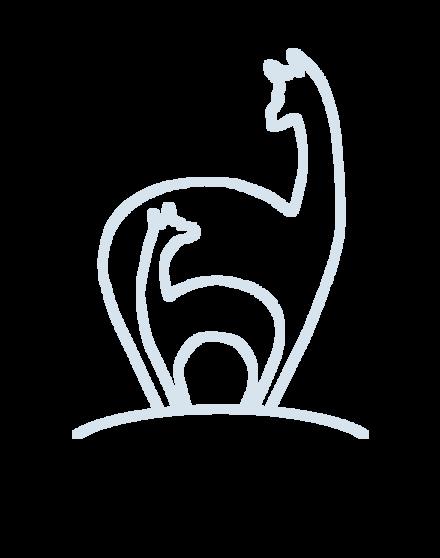





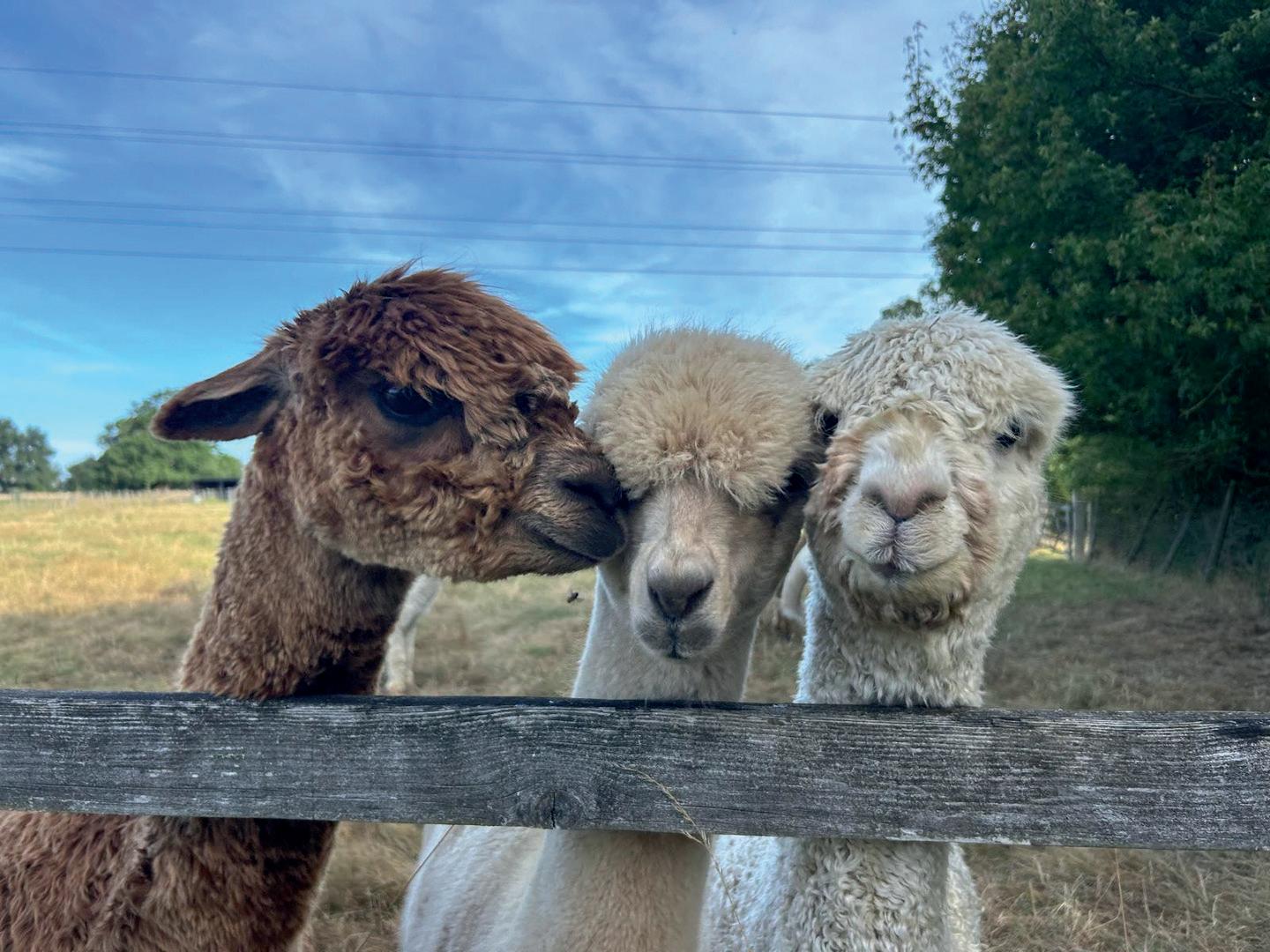


Only the very best, consistent fibre producers remain in the Peruvian breeding programme. In this diverse country alpacas are most certainly not kept as pets, although if you choose to visit, steel yourself to seeing young cria on leadropes, taken away from mothers to be used for tourist photograph. Every aspect of alpaca is utilised and as we travelled the roads, large stockpiles of alpaca beans were seen in the crop fields ready for spreading into the soil. Yes, they do therefore poo pick in Peru, because alpaca poo is the only fertilizer available in many places and it is utilized by peasant farmers and commercial farmers alike and clearly valued for its incredible fertile properties.
We would pass Peruvian women on street corners with their drop spindles and regional hat styles and everywhere the vibrant, multicoloured, traditional woven fabrics were displayed, along with plenty of knitwear and crochet items. ‘Alpaca’ in Peru is everywhere and the pride in and of this ancient culture and heritage was evident wherever we travelled. We were able to see at close hand, skilled hand weaving and dying of fibre with an array of natural dyes.


Having seen the prestigious fashion show in Arequipa, we also visited the factory at Inca Alpaca to see the reality of the production line behind the high-end fashion. What an eye opener this was as we toured the immaculate factory and watched the scale and precision of the huge operation and the absolute quality control of each product as it was spun, woven and stitched.
At Inca Alpaca, the fibre is received as tops from the breeders and the specification by these companies of that fibre, it’s micron and therefore the quality of the tops from the breeders, is an absolute requirement. If the fibre doesn’t make the grade, it will not be bought.
On receipt, the fibre is cleaned and prepared and spun into yarn at the factory, to ensure the exact quantities and colours are produced for each garment. Dust is extracted and constant cleaning down ensures that every area is kept immaculately clean. The scale of this production line was incredible with thousands of pieces per week being produced.
>> Continued on next page











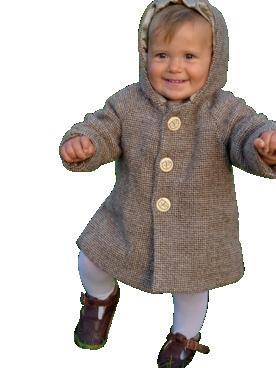







Once again, nothing was wasted and if an error was found by quality control, then there were even machines in place to unravel the product and recycle the yarn. Of course, we are familiar with alpaca fibre, both Suri and Huacaya, in the UK but what we were also keen to see was the Vicuña with its uniform average 12.5 micron.
High in the Altiplano at 16,000ft where the air is very thin, we were so privileged to join with the local Quechua community at Picotani to share in their Chacu. The Chacu is the annual gathering together of the Vicuña for the shearing of their most highly prized and valuable fleece. These people now manage the Vicuña and are responsible for their well being and their survival. In times past, the Vicuña were nearly rendered extinct as they were killed for their fleece. Now with careful management they are thriving.
Together with these humble people who so openly welcomed us into their community and to participate in their ancient ceremonial rituals, we
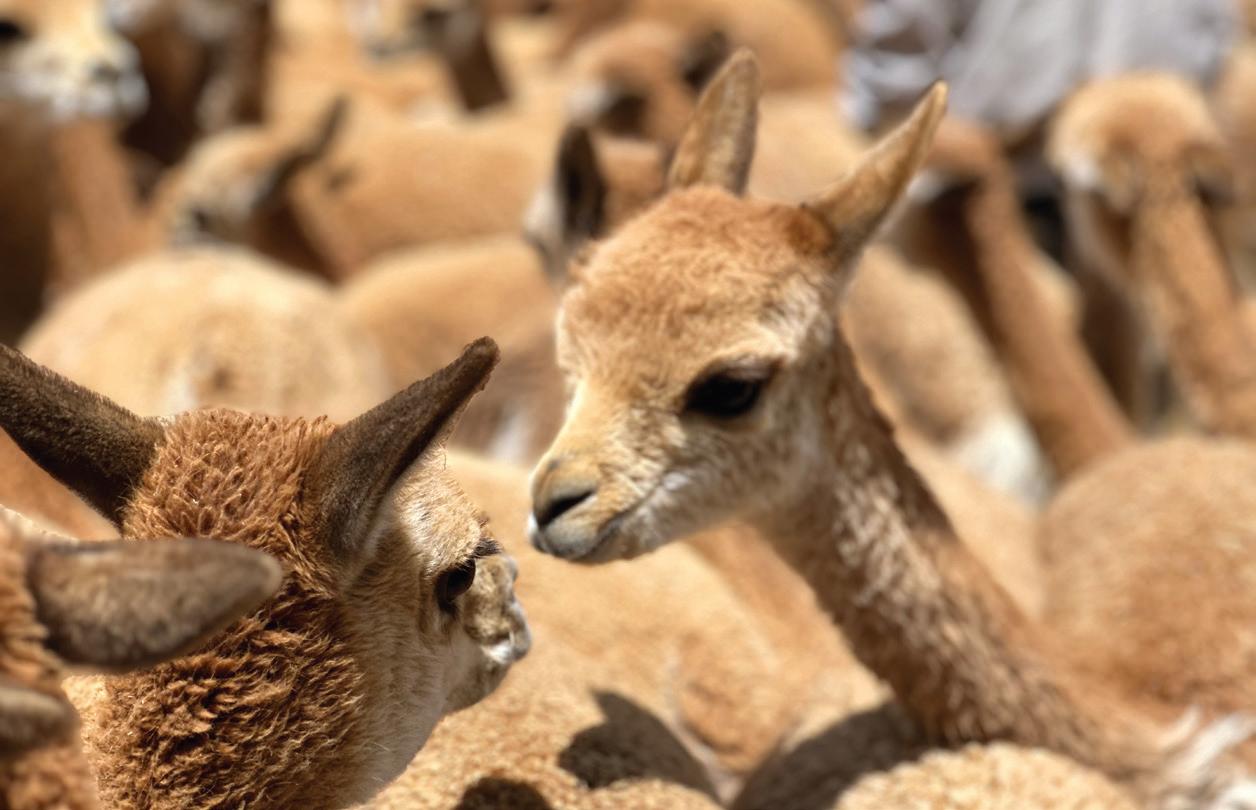
herded down the wild vicuña to the shearing area. We were in Peru with the Quechua Benefit 2024 Peru Tour and having read ‘Vicuña Survival of the Finest’ and followed the documentary ‘Salvation of the Vicuña’ by Mike Safley, to actually behold these magnificent creatures in such close proximity was deeply moving and an experience I for one, will never forget.
Vicuña too, have poo piles even though they are roaming free! They have natural family groups of about 5-7 animals with one macho guarding and herding their group. In late October these animals blend in perfectly with the landscape behind them and as we waited quietly at a rocky outcrop for the Quechua community to appear on the horizon with their bunting ropes outstretched, to herd down behind the Vicuna, we began to see the growing numbers of animals.
>> Continued on next page












They came in their family groups, some quietly, some at pace, until the numbers amassed to some two thousand animals. The beauty of their eyes, their elegance and general calmness as the animals were herded down was truly something to behold. Following another ceremony where thanks were given for the successful Chacu and two Vicuña took part in a symbolic marriage, there was a period of dancing with our hosts. Quechua people know how to party, but at 16,000ft most of us were exhausted within minutes of getting on our feet.
Shortly after, we were taken into the onsite shearing buildings and shown the process of Vicuña shearing. Prior to shearing, each animal is checked over and the length of their fleece measured. If the fleece is not long enough, they are released without shearing to wait for another year. Any health issues are treated as necessary and only fit Vicuña will be brought into the shearing area.
The animals were very carefully restrained as we watched the care and skill of the shearer, removing just the blanket from the animal. Each fleece was numbered and certificated, straight from the animal, before being rolled up and taken straight to the skirting table where they were picked over by two carefully trained women to remove any second cuts and/
or stray long fibres (from the white areas on the Vicuña’s marking) that would otherwise contaminate the fleece. Each fleece would then progress to being washed and combed. It takes on average, 14 fleeces to make 1kg of Vicuña fibre which is one of the reasons why this fibre, together with its ultra fineness of between 11 to 14 micron is so prized and the most valuable, legally farmed fibre and why the feel of the fashion items produced from it, so exquisite.
Peru without doubt left an indelible mark upon us as we took in the breathtaking diverse landscape, the architecture and culture and rich diversity. Our small tour was accompanied throughout by two excellent Peruvian guides, in addition to Mike Safley, Amanda Vandenbosh and Dale Cantwell and the incredible wildlife photographer Robert Els, all of Quechua Benefit.
In two weeks, we packed in multiple destinations, architecture and ruins along with so many rich cultural visits. The Inca Trail and visit to Machu Pichu at the end of our tour was both an achievement and fabulous end to the most memorable and incredible experience. We had made new friends and strengthened existing friendships. If Peru is somewhere you are thinking about visiting, it comes highly recommended!


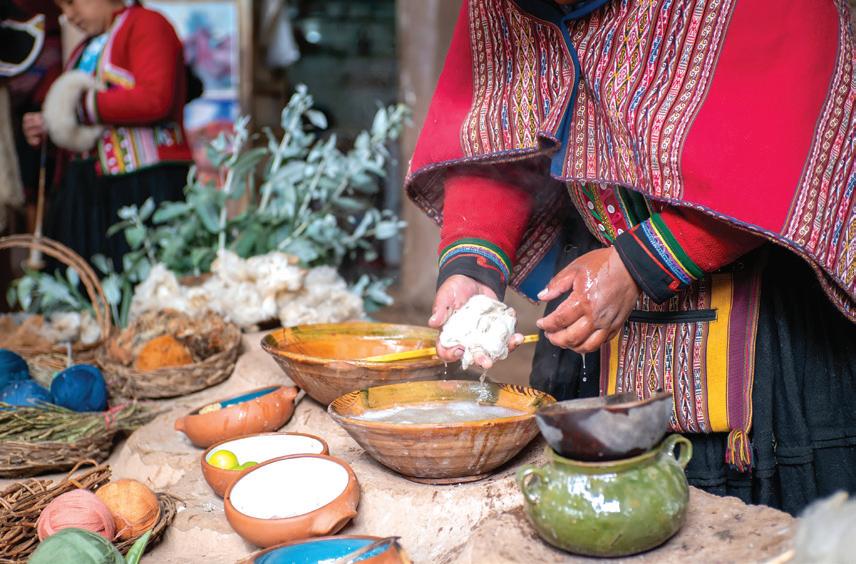





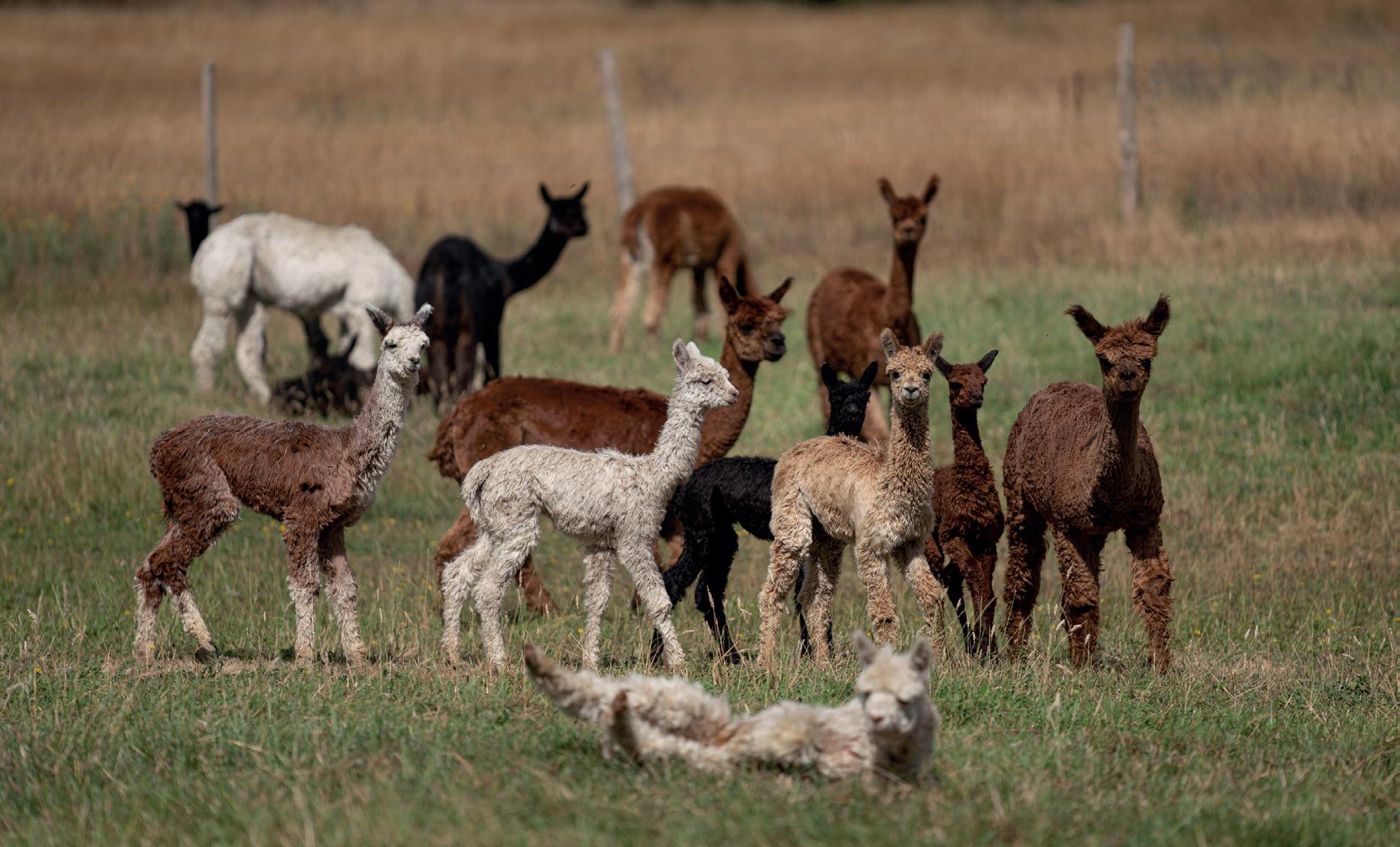
Iam not from farming stock but I love this way of life. My husband Barry’s family have been farming on these fields for generations, when we started our own family, we just knew that we wanted to raise our children on the farm, close to nature, animals and family. Working with the land and animals has a lovely way of encouraging intergenerational connection, young and old working side by side to get the job done.
We live on the townland of Altacamcosy, which means ‘Height with a crooked foot’ in Gaelige. We are high up in the foothills of the Central Sperrins Mountain range, with the Owenkillew river winding round with a crocked curve below us. We are blessed with really beautiful views of the valley and a mountain of blanket bog above our farm. We are predominantly sheep farmers, we have a few cattle, donkeys and hens and then nearly two years ago, I took a mad notion to buy some alpacas. This is how Sperrin Alpscas began.
I studied Tourism Management at University and I wanted to bring my knowledge of tourism industry to diversify and create an experience on
the farm, an agri tourism product. I took a chance on two male alpacas and soon after we purchased two more with the intention of starting an alpaca trekking business, we soon started taking alpacas to events and hosting our own events on the farm. Nearly two years on we now have eight male alpacas, seven Huacaya and one Suri and have visitors from all over visiting us to trek and spend time with our lovely boys. They have bought so much joy to our lives.
We have taken the alpacas to weddings, festivals, fun days, local nursing homes and more recently we have started to host our own events here at the farm. One of our most successful events has been our alpaca forage walks, I have always had a real interest in our hedgerows and trees, I have early memories of my grandmother pointing out and telling stories about hedgerow flowers and berries. That interest stayed with me, I would always return home from walks with a pocket full if flowers to identify, I would read up on them and have built up a bit of knowledge.



When halter training the alpacas, day after day we would walk and they would often stop for cheeky little munches on the gorse, Hawthorn, blackberry, I loved that because it gave me a chance to forage and collect, I would come home then and decide what to make with my loot. I just thought one day that other people might enjoy it too, so I put it out there online and it got booked up pretty quickly which I couldn’t believe.
Visitors were asked to wear wellies and bring a basket, and a real mixture of guests from very young to more mature, got a chance to meet the alpacas and get to know a little about them as we trekked, stopping every so often at flower/plant/tree of interest, whilst the alpacas enjoyed a good hedgerow lunch. We talked about rose, hawthorn, clover, dandelion, elderflower, cleavers, nettle, horsetail and rowan. People shared stories which are so important to keep alive, reminiscing about their childhood, picking blackberries, collecting roseips for a neighbour, and the younger children filled baskets and seemed to find new plants to identify. The alpacas slow, relaxed pace works so well with discussion and taking pit stops, taking in fresh mountain air and views and as one of my visitors said the other day, forgetting about the electric bill for an hour or two.
We picnicked after the trek, sampling some of my favourite recipes with a big basket of home made scones. Blackberry jam, rosehip syrup, elderflower cordial, elderberry juice, cleaver tonic and everyone got a copy of my favourite recipes to take home, with a few favourite natural remedy recipes too, rose water, dandelion tonic, plantain balm. All the while, the alpacas watched on, making people smile.
Since hosting alpaca forage walks on the farm, we have been asked to lead alpaca forage walks in other locations which has added another fun element. Sometimes I just think the doors keep opening to new adventures with alpacas, long may it last!
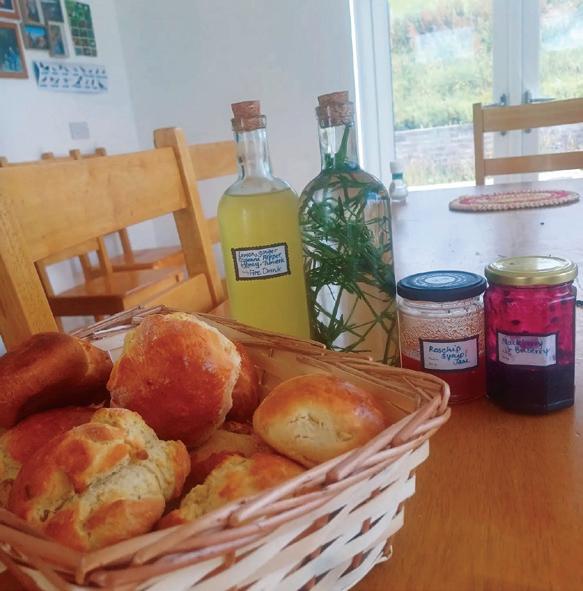


at Mulberry Alpacas
C
(BAS affiliated) Alpacas for sale
So, come and visit soon!
Mulberry Grange, Red Hall Lane
Higher Penley, Wrexham LL13 ONA
Tel: 07713 639 447 or 01978 710224

Email: mulberryalpacas@btconnect.com
We’re 4 miles north of Ellesmere
Open Saturdays 10.00 until 16.00 and by appointment
ORDERS WELCOME

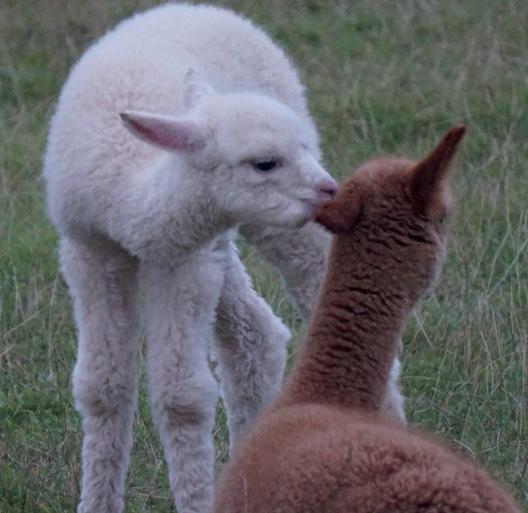

Q: I don’t imagine that you can just start taking people out with your alpacas without some sort of rules and regulations. What do you need to consider?
A: Public liability is an absolute basic – you are responsible for these people’s safety. You will also need a license from the Local Authority. This used to be called the performing animals license but is now called the Animal Welfare (licensing of activities involving animals) (England) 2018. You also need to consider that you meet the facilities for visitors – again contact the Local Council for advice. You might need a change of use in some circumstances which will involve planning.
If employing helpers, then you’ll need all the usual things that go with that and employers’ liability. You’ll also need to get and read the Code of Conduct for Trekking which is a joint code between the British Llama Society and the British Alpaca Society. This needs to be displayed so we put ours in the café.
If travelling with the alpacas to a paid engagement, then you will need the Animal Transporter Authorisation (ATA) from APHA. Incidentally not only do you not receive notification when this runs out, there also seems to be less courses available since Covid-19. The first place to look would be your local agricultural college or maybe ask your local alpaca group for advice.


Q: Hmm, I found it difficult to find an ATA course but I did mine through the British Driving Society. Having looked through the documents, what else do I need?
A: The most important part of your trekking enterprises are halter trained and almost bomb proof alpacas. Not only do they need to lead, they need to lead with novices and be used to loud noises, unexpected events and to be confident. It is highly unlikely that you can just go out and buy these amazing animals. You will need to look at what you have and select those that you think will be suitable from your males. If buying, then leading willingly is a must but there will be further training to do. Big stud males will normally walk as a second job.
Q: So wearing a halter and taking a few steps with the herd is not enough?
A: Well it’s a start but its not the same as being halter trained. This means leading on a loose rein, being able to meet dogs, people, and all the other things that a walk might bring. All our boys are trained with a halter but they get extra training for trekking. Taking an alpaca on a walk should bring about a feeling of having something so light on the end of the lead rope.
Q: How do you start the walk, do they catch their alpacas?
A: No the catch pen is not part of the walk. Its not a good idea to let someone they don’t know catch them and the participants have paid for a walk. Though my alpaca queue up to go into the pen.
Q Presumably most people have not been this close to an alpaca. How do you start the trek?
A: You need to begin by being very clear so that the participants know exactly what to expect. Be honest and be positive. You must clearly talk about safety including how to walk, for example not close to the alpaca in front. Explain the possible consequences of not being safe. Get them to repeat back to you what you have said, make it a bit fun, such as a safety quiz. They need to know how long the walk will be but the preparation starts in the booking forms, which will help you match a participant to the alpaca. Firstly before they even arrive they must know to wear good footwear so they can walk safely. Don’t rush this bit, its good to find out expectations and manage them accordingly. I get people to arrive 15 minutes early but if they are earlier I have a plan such as an option to see the crias. I time feeding the crias after the walk so they can see this as part of their experience.







Q: Do you always walk the apacas in the same order?
A: Its vitally important to really know your alpaca. That way when you have had a quick assessment of your walkers, you can match person to alpaca to suit both of them. Some alpacas are front ones, they like to be up there at the front while other feel more comfortable following others. You will naturally get to know your alpacas really well as you’ll have spent hours walking them to train them to all events and people. That’s part of the joy of trekking, the interaction with alpacas and people. You want a positive, enjoyable experience for everyone.
Q: Can you sum up some of the most important things that you really need to do for success?
A: Obviously fulfilling all legal and insurance obligations before you start. Then ensuring you have the right alpaca for trekking both mentally and physically. You really need to understand your alpacas. You need to be sure you know where you are walking. It is so much better if you can do it on your own land for safety and to reduce unexpected events. Some people do use bridle paths and rights of way. Only a byway is technically legal – footpaths and bridleways are for pedestrians and horses and pedestrians, respectively. If you do use these then you will have hazards in the form of dogs and horses and ponies. You’d need to do a lot of work to be sure all your team were Ok with these. Byways allow not only people, ponies and dogs, but also driven motor vehicles and carriages. Driven ponies and horses seem to cause dismay even with their own kind so something else to get your team used to if you are going off your land or your land includes a byway.
It also helps with any business that involves the public, that you like people and want them to have a good time.
Q: What else could you do with your walking team?
A: Alpaca agility is very popular and is good if you have limited space. People love to get rosettes for getting round a course and its great for their photo opportunities. We did try alpaca yoga once...
Companies must agree to four minimum requirements for llama and alpaca trekking/walking as set out below by the British Llama Society and British Alpaca Society:
General good practice
• To abide by the appropriate Health & Safety Legislation in consultation with the applicable Local Authority, including Food Hygiene where applicable.
• Consider biosecurity measures relevant to the area and business.
• To secure adequate Public Liability Insurance and any other insurance applicable to the business.
• Consult with Local Authority regards any appropriate Welfare Licence.
Route good practice
• To seek relevant permissions if trekking off your own land.
• Plan and risk assess accordingly in relation to your environment.
• Respect the environment and others who use it.
• Abide by Countryside Code.
Public/Client/Llama Health & Safety good practice
Demonstrate a duty of care towards:
• Your Clients
• The public
• Your animals
Llama and alpaca welfare
• Maintain a responsible effective welfare structure towards all the animals within the business.
• To put welfare of the animals above income.
• To demonstrate good practice throughout all aspects of care both on the premises and when out trekking.
Q: The big question, does It pay?
A: Costing it out should have been done right at the beginning. If you have the facilities, already have enough males to make a team and have public facilities on site, then initial set up is not too bad. Creating from scratch will be more costly. It can be profitable, but it is very hard work and you will need more people than you to help. It is rewarding in many other ways as well – though everyone has to be realistic about needing some return for your effort.












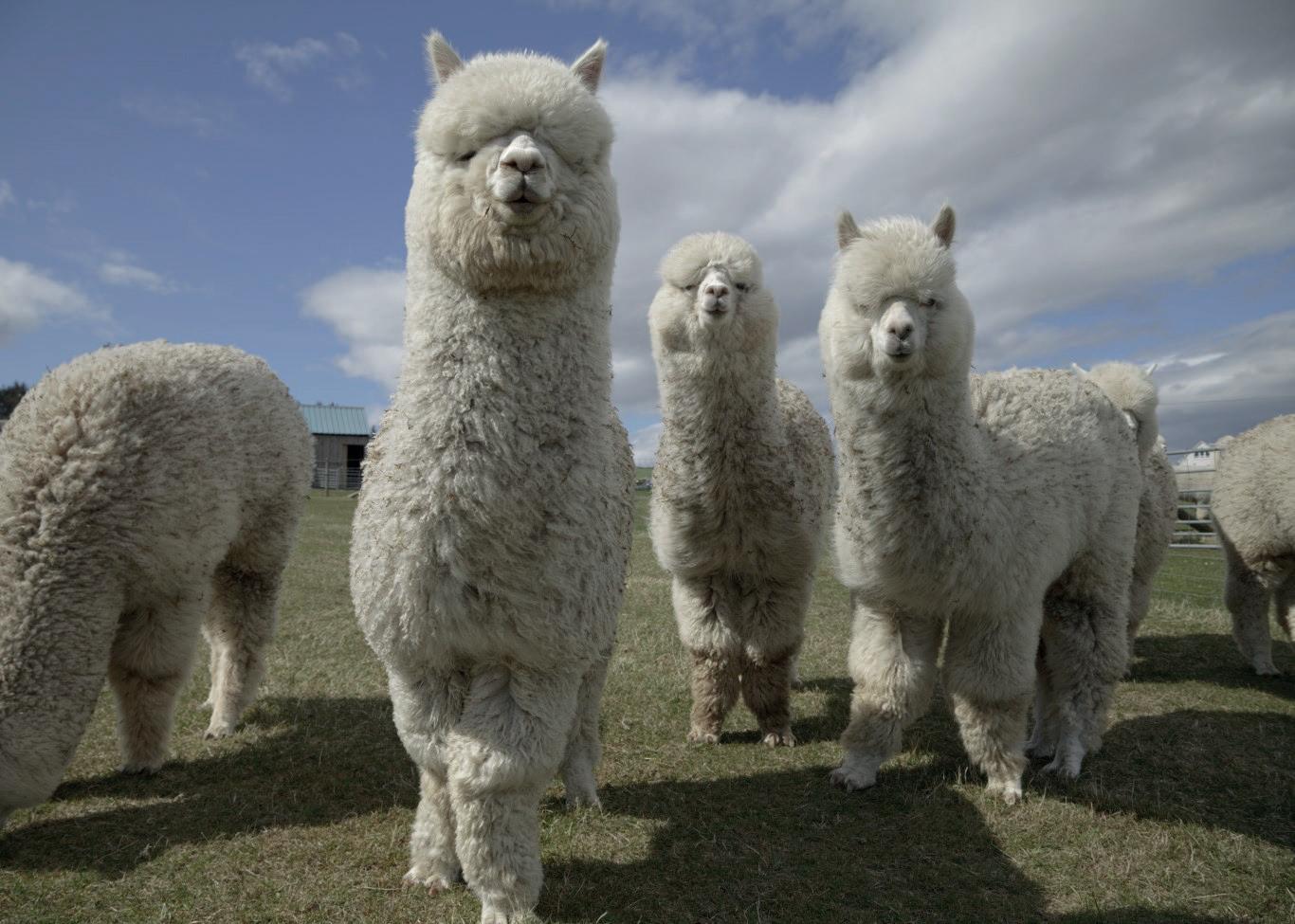






Attacks by dogs on alpacas are increasingly more frequent and cause suffering to the animal and emotional misery to the owner. It’s often so distressing that its hard to remember what to do so BAS have compiled a guide that they hope you will never have to refer to!
If your alpacas are victims of dog attacks:
1. Stop the attack by any reasonable means
2. Call the vet to treat any injuries. Keep information on veterinary treatments and costs.
3. Collect evidence – take pictures, “arrest” the dog if possible (it may have a tag or be chipped which can identify the owner).
4. Take contact details from the dog owner, if present, and witnesses if there are any.
5. Report the incident to the police using 999 if it is in progress and 101 if you discover an attack and the dog has gone. What3words is helpful for an exact location. https://what3words.com/
6. Take indirect losses into account like loss of pregnancy.
7. Report the incident to BAS
Many of you will know that the issue of dogs worrying alpacas has been
rather confusing because the legislation was designed for sheep rather than alpacas. The Scottish Government recently changed the law to put alpacas in the same bracket as sheep when it comes to dog worrying. The English Government is considering the same sort of changes, but it is still a work in progress.
BAS has supplied data on the frequency and severity of dog attacks to Government which has helped move things forward. BAS still need to collate information relating to dog attacks on alpacas to maintain pressure on the Government. If you are unfortunate enough to be involved in any dog worrying incidents, then please do send details to Duncan (ceo@bas-uk.com) so we can continue to have up to date information on these incidents.
If you have footpaths on your land that are regularly used by dog walkers it could be worthwhile talking to the owners to make your concerns real for them. They may well be more supportive of good dog control if they have a personal connection with you and your alpacas.
You can download and print the poster to help you build awareness or cut out the page opposite TV www.bas-uk.com/dog-attacks


The North Shires and North Wales Alpaca Group (NSNWAG) was formed just over a year ago to cover a blind spot in the previous coverage of the regional groups.



Alpaca ownership in North Wales and adjacent parts of North West England has gathered a huge amount of momentum in recent years, leading to a vibrant and active community of alpaca owners. The core aim of the group is to provide education, welfare support and networking opportunities for the owners in these areas.
Within just one year of operation, countless owners have managed to connect with other local owners, sharing advice and information on many topics, from the best local vet to offering to help on toe nail trimming day! As well as connecting with their local alpaca community, members of NSNWAG, near and far, benefit from a varied and exciting webinar program. Hosting speakers from all over the world, from Australian alpaca shearers to experts on colour genetics. On top of socialising and learning opportunities via Zoom, members also enjoy face to face meet ups, whether it's for Sunday dinner or attending one of our greatly in demand course days at Acton Hill Alpacas.
Regardless of all the fun and games being an NSNWAG member brings, welfare is at the core of the group. Ensuring members have a supportive network around them to help advise, or helping members within our area who may need a bit of support whether it is with rehoming or welfare advice.


To give you a taste of what NSNWAG has in store for next year, just in this last portion of 2024 alone we have had an exciting webinar programme including the History of Camelids, The Peruvian Alpaca, and Castration and Teeth. It is basically Netflix for alpaca owners! All of these are recorded and available to members together with a range of subjects which include:
• Keith Payne, Big Ear Llama Ranch: A camelid conversation
• GWF Nutrition
• WaterHouse Feeds
• Red Granite Presentation: Breeding decisions
• NZ SummerHills: Appaloosas
• Lilipop Mill
• Ami Sawran and Philippa Hampson: Facial conformation
• Ian Watt: OFDA
• Jason Gill: Colour genotyping
• Marty McGee, CameliDynamics
• Tiffany Horn, Ribble Vets: Parasites
• Sarah Unwin’s event is also available but this requires payment. In 2025, we hope to repeat many of the fabulous courses we offered with regards to parasite testing, and a course on birthing. However, we are known to have a few surprises up our sleeves, so keep an eye out for our announcements. Not to mention we are due a good meet and catch up over a good hearty meal, so now is the perfect time to join if you are within our area.
A huge factor of the NSNWAG group is that we want to ensure our local alpaca owners are supported, and that they have access to as many exciting opportunities as possible. Alongside being able to increase their parasite, birthing and general breeding knowledge through our courses and meet ups, we even offer our members (and for an additional charge, non-members) certified CPD learning opportunities.
After the success of our first webinar with the highly respected and qualified Sarah Urwin (registered counsellor and psychotherapist), we invited Sarah back to do a course last autumn on Neurodiversity and Working with Animals. This is such an important area for alpaca owners to get involved with, offering both a diversification opportunity, but also to make a serious impact on their local community. Even if some owners have some experience in these areas, the feedback after the previous course was fantastic, so we decided to repeat and extend the opportunity, so it is relevant but still 'ground level' for everyone who attends, whether they attended the previous CPD or not. This was really well attended with fascinating discussions as well.
Everyone is welcome to join the North Shires and North Wales Alpaca Group, whether you are just contemplating camelids, an adventurous alpaca newbie, an advanced alpaca owner, or a brilliant breeder, we promise there is something for everyone.

26 February: 7.30pm
The Peruvian alpaca
Jose Berdejo Peruvian breeder and judge
12 March: 7.30pm
Alpaca’s and nanoBody technology
Mary E. Skinner, M.S, research lab specialist lead
Taubman Nanobody Initiative
University of Michigan (recorded)
Wednesday 16 April: 7.30pm
Alpaca health checking – The token creek sweep
Elden Harms of Token Creek Alpacas
7 May: 7.30pm
NeoNatal Cria Care
Patrick Long (author of Neonatal Care Book)
Wednesday 11 June: 7.30pm
“Everyone should love a Suri”
Presented by NorthWestSuri, Neil Payne and Bev Morgan
2 July: 8pm
Practicalities, expectations and goals of our animal assisted programmes
Animal Therapies Ltd
23 July: 7.30pm
AGM
TBC August
Vet talk : Why is my llama/alpaca not eating?
17 September : 7.30pm
Fibre processing – “What does the market want!”
Yarn Factory USA
PLANNED FACE TO FACE EVENTS AT THE MOMENT ARE:
19 April
Alpaca birthing course
Presented by Charlie Lambert BVSc MRCVS, The Vet Shed.
Hosted and supported by Acton Hill Alpacas
£20 with places limited to 20
18 May
Parasitology course
Presented by Charlie Lambert BVSc MRCVS, The Vet Shed.
Hosted and supported by Acton Hill Alpacas.
Also includes a fluke test demonstration by Clara Boulton of Natterjack Alpacas.
£20 with places limited to 20. In partnership with Brunel Microscopes and each delegate will receive a one time 20% discount if they wish to purchase a Brunel microscope.

Lightfoot Alpacas are situated in Hawkhurst in the Weald of Kent. We have been breeding alpacas since 1997 and have over 250 Huacaya. Lightfoot is a closed herd, we believe that the bio security and health of our animals is paramount to their breeding and care. We have a range of colours and ages, mainly Huacaya and some Suris. Our animals are known for being friendly as we spend time with them and know them individually.
We provide after sales advice and back up services when we sell our animals. Whether you are looking to improve or expand your herd or just thinking of alpacas as pets, why not contact us to arrange a visit.
TEL: 07802 263589
EMAIL: graham@alpacabreeder.co.uk
WEB: www.alpacabreeder.co.uk
Celebrating 28 years of continuous selective breeding for colour, consistency, fineness and density. Champion Stud services available.

Re-organisation Sale in progress: Show stock, Breeding Stock, Studs, Walkers, Fibre, Guard and Therapy alpacas for sale in all colours at prices to suit all budgets.
Husbandry, Fibre, Processing and Management workshops available hosted by Rob & Shirley Bettinson – two former BAS judges with over 30 years’ experience in all aspects of alpaca breeding and showing.
We are dedicated to helping you realise your own alpaca aspiration.
SHIRLEY: 07970 626245 ROB: 07973 123008
EMAIL: shirley@toftalpacastud.com
WEB: www.toftalpacastud.com
The PennyBridge Herd and Stud. One of the first alpaca farms set up in the South of England, still producing show winners from champion stock. Good quality starter herds, proven and potential stud males, fancy grazers and sheep guards available.
‘Home of The Alpaca Experience’.
Situated in North Hampshire, close to the Surrey and Berkshire borders with good access to ports and airports, less than five minutes drive from both J5 and 6 of the M3. TEL: 01256 764824 or 07801 132757
EMAIL: joy@pennybridgealpacas.co.uk
WEB: www.pennybridgealpacas.co.uk

Ballymac Alpaca is situated in Gilford, Northern Ireland. Our multiple prize-winning herd consists of carefully chosen genetics from around the world. We breed Huacaya alpacas of all colours, including appaloosa. Available for export.
Our online shop sells camelid supplies including GWF alpaca feed, birthing and husbandry items shipping throughout the UK or for collection.
Our Champion Studs are available for on-farm or mobile stud covers, including Champion of Champions Bozedown Trailblazer.
Look on our website for more information.
TEL: 07546 929659
EMAIL: mail@ballymacalpaca.com
WEB: www.ballymacalpaca.com
A list of BAS members who are breeders and advertising their alpacas for sale
Home of The Tartan Alpaca®, The Dark Sky Genie™ and Destination Mating.

Located in rugged and beautiful North Cornwall, we focus on Suri and have a herd of elite alpacas with some of the best and varied genetics in the country. We sell quality breeding stock, in particular Suri starter herds, and offer full stud services as part of Poldark Suri Stud.
WENDY: 07712 136949 TOM: 07825 105530
EMAIL: tomandwendy@darkskyalpacas.com
WEB: www.darkskyalpacas.com
The family run JandJ Alpaca herd was established in 2005 with four breeding females, today we have over 90 beautiful animals. We are located in Lincolnshire on the Nottinghamshire, Lincolnshire, Leiceistershire border just off the A1.

With years of experience our aim is to help you choose the best alpacas to start you journey, whether it be breeding females, stud males or pet boys.
Stud services also available from top coloured genetics. MARTIN OR CLARE: 01636 626990
EMAIL: sales@jandjalpacas.co.uk
WEB: www.visitalpacas.co.uk
We are a family run farm in Warfield, Berkshire, breeding high quality Huacaya and Suri alpacas from show winning sires. We would like to welcome you to Scotlands Farm to see our wonderful herd of both white and coloured animals.
We are happy to discuss your requirements, be it for pet males, stock guards, or breeding females to suit your budget but with no obligation to purchase. We have over ten years of experience with these adorable animals. Give us a call and let us see if we can help you.
SUE HIPKIN: 07770 455533
LISA HIPKIN: 07770 455534
WEB: www.scotfieldalpacas.co.uk

Advertise here
Your booking will include an online listing in the Alpacas for Sale section on the BAS website.
TEL: 01732 448748
EMAIL: wendy@talk-media.uk
Advertise here
Your booking will include an online listing in the Alpacas for Sale section on the BAS website.
TEL: 01732 448748
EMAIL: wendy@talk-media.uk

Located on the Solway Firth, in Cumbria, King Garth Alpacas is a family-owned herd where we aim to breed beautiful, happy, healthy and friendly alpacas with top show winning genetics.
We have alpacas to suit everyone and all budgets; from pet boys to starter herds, elite females and stud males. We offer full support and advice before and after sales. Please feel welcome to get in touch and chat about your alpaca needs.
We also offer stud services, alpaca experiences, luxury alpaca products.
TEL: 07762 286050
WEB: www.kinggarthalpacas.co.uk
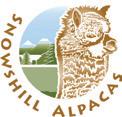
Established in 2002 and situated on the North Cotswold hills close to the picturesque village of Snowshill, the current herd numbers over 300. We breed both Huacaya and Suri alpacas (approximately 75% are Huacaya). Although our breeding programme is biased towards the darker colours, we do also have superb quality whites and beige alpacas.
Full range of alpacas for sale, attractive pets to top show quality breeding girls and stud boys. Large choice of stunning stud males available to service your girls. Also offering natural alpaca fabrics made in the UK from the fleece of our own herd.
TEL: 01386 853841 or 07711 044106
EMAIL: snowshillalpacas@btinternet.com
WEB: www.snowshillalpacas.com
Nestled in the rolling hills of mid Wales, Fostings Alpacas is home to a mixed colour herd of friendly Huacaya alpacas and offers Alpaca Husbandry Courses, Online Training and bespoke Staff Training for Farm Parks and Sanctuaries.
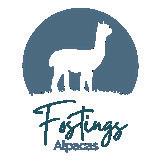
Alice has over 16 years experience in animal care, having worked with a diverse range of birds & animals, whilst Kevin has a lifetime’s experience in agriculture, enabling us to offer extensive pre & post sales support and guidance. Whether you are looking for halter trained pet boys, a starter female herd or pretty paddock grazers, we’d love to help you find the right alpacas for you and your budget.
ALICE: 07882 135027 or KEVIN: 07875 243086
EMAIL: contact@fostingsalpacas.co.uk
WEB: www.fostingsalpacas.co.uk
M.R.Harness was founded in 1995 after existing part time for a number of years. Mary herself is a qualified engineer and is well placed to assess materials and their useage. Company policy is to test as many of the webbing designs as possible before release, as each item is unique to the animal it is designed for. This has led M.R.Harness to become the supplier of choice for headcollars, leads, coats and harness for all the various smallholding animals, but specialising in alpacas and llamas, and working ponies.
All items are hand crafted ‘in house’, in England, so you can be assured of good workmanship and quality products that last.
So please come and try the ‘Choice of Champions’.
TEL: 01299 896827
EMAIL: mary@mrharness.co.uk
High specification organic chealated nutritional supplements suitable for all camelids.
• Premier Camelid Drench
• Premier Mineral Supplement
• Premier Mineral Bucket
• A, D3 & E Paste
TEL: 07866 607466
EMAIL: jganimalhealth@aol.com
WEB: www.jganimalhealth.co.uk
Everything you need for your alpacas delivered to your door! We are a one-stop-shop for alpaca supplies, including headcollars and leads, vitamins and nutritional supplements, healthcare and welfare supplies, colostrum, coats for cria and adults and microchipping equipment.
We also have a good selection for your other animals, including dogs, chickens and horses, as well as a range of farmhouse items and gifts, including our famous home cheese-making kits.
We are alpaca owners ourselves and we are always happy to help with your questions and enquiries.
Order direct from our website or by phone. You can expect fast, friendly service and advice.
TEL: 01295 713188
EMAIL: homesteadfarms@btinternet.com
WEB: www.homesteadfarmsupplies.co.uk
Your booking will include an online listing in the Alpacas for Sale section on the BAS website.
TEL: 01732 448748
EMAIL: wendy@talk-media.uk


Your booking will include an online listing in the Alpacas for Sale section on the BAS website.
TEL: 01732 448748
EMAIL: wendy@talk-media.uk
Classic Carder produce a full range of British, handmade drum carders for fibre preparation. Featuring our unique interchangeable drum system which allows quick and easy drum change for carding different fibres.
TEL: 01746 714130
EMAIL: paulbrittain@mac.com
WEB: www.classiccarder.co.uk




Members meet on a regular basis to talk alpaca, organise events, seminars, workshops, and generally share their experience and knowledge on all things alpaca.
The groups are not exclusive (to BAS members or by Geography) and are open to all. Their aim is to allow new and existing members to come together, socialise with other breeders in their locale and learn more about alpacas. Should you be an owner, prospective owner, or just interested in these fascinating animals, your regional group will always make you welcome.
The groups also provide invaluable expertise by providing qualified judges, welfare advice, nutritionists and lecturers, with the emphasis always on self-help, accessibility and local initiative. Each group organises its own area slightly differently; some hold their meetings in the same place and some move venues. Meetings are organised around barbecues, suppers, coffee mornings and workshops; most groups ask for a small contribution to cover the costs of the event.
No group in your area? Form your own.
The BAS Regional Groups are designed to provide local activities for and contacts between members within a region.
Groups are responsible for organising meetings for members and for disseminating information from the Society to members and passing feedback to the Society.
Groups are responsible for their own financial affairs and meetings of the group should be financially self-funding.
Alpaca shows within the Group’s area would be organised by the Regional Group with assistance from Grassroots Systems Ltd (if required) with regard to online entries and catalogues. Shows are expected to be self-financing.
Groups are encouraged to provide reports of their activities to the Editor of Alpaca magazine.
Notices regarding Group events can be







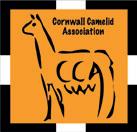


included in the BAS Newsletter sent by email to all members, posted in the Facebook BAS Chat Forum and posted on the appropriate page(s) of the BAS website – www.bas-uk.com. Details of events should be sent to ceo@bas-uk.com
To be recognised by the Society, the Group must have an appointed Secretary and Treasurer. It must have its own bank account for Group funds. When these items are in place, details should be submitted to the BAS Board which will consider the formal recognition of the Group.
Minutes of meetings must be produced to the BAS CEO and be made available if requested. It is suggested that those interested in establishing a new Regional Group hold a meeting of members within the area to gauge interest and to determine what type of activities local members would support.


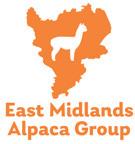
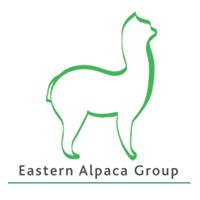

A list of all Regional Group contacts is included on the BAS website and it is also sent to all new members who are encouraged to join the one nearest to them.
• Northern Ireland Alpaca Group
• North West Alpaca Group
• North Shires and North Wales Alpaca Group
• West Shires Alpaca Group
• South Wales Regional Alpaca Group
• Cornwall Camelid Association
• South West Group (SWAG)
• Heart of England Alpaca Group
• South East Alpaca Group
• Eastern Alpaca Group
• East Midlands Alpaca Group
• Yorkshire Alpaca Group
• North East and Borders Alpaca Group
• Scottish Group
• Suri Network UK Group








We are proud to offer:
Business plan for new breeding herds and full herd assessment and business review for established breeders.
Elite pedigree breeding and pet stock for sale in the UK and for export to the EU, Qatar, UAE, Saudi Arabia and India.
Help obtaining planning permission for a dwelling using alpaca breeding as justification – we did it and have helped others.

